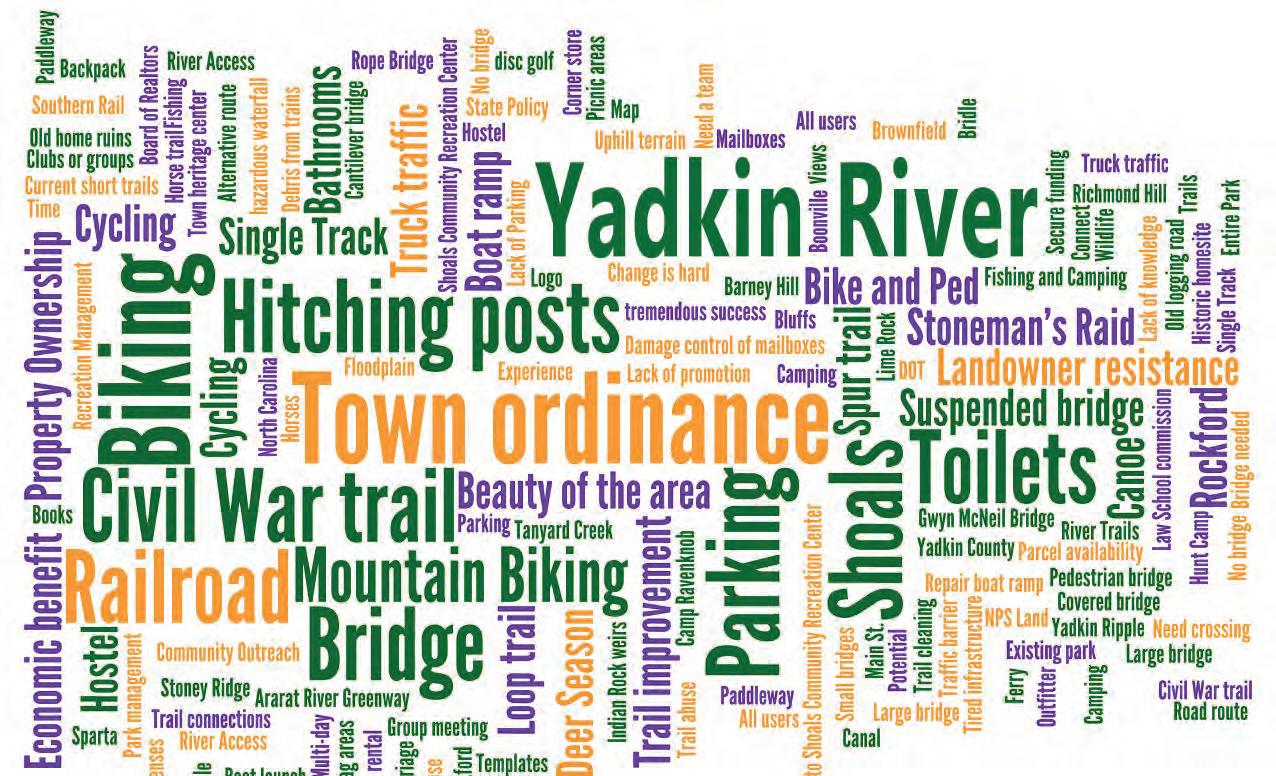





 Stone Mountain State Park Superintendent, Janet Pearson, points to the Stone Mountain outcrop from Devils Garden Overlook on the Blue Ridge Parkway.
Stone Mountain State Park Superintendent, Janet Pearson, points to the Stone Mountain outcrop from Devils Garden Overlook on the Blue Ridge Parkway.







 Stone Mountain State Park Superintendent, Janet Pearson, points to the Stone Mountain outcrop from Devils Garden Overlook on the Blue Ridge Parkway.
Stone Mountain State Park Superintendent, Janet Pearson, points to the Stone Mountain outcrop from Devils Garden Overlook on the Blue Ridge Parkway.
5: trail Section analysis and
MSt hIStorY anD chanGInG
History
Glance
of Previous MST
overvIew of the reGIon
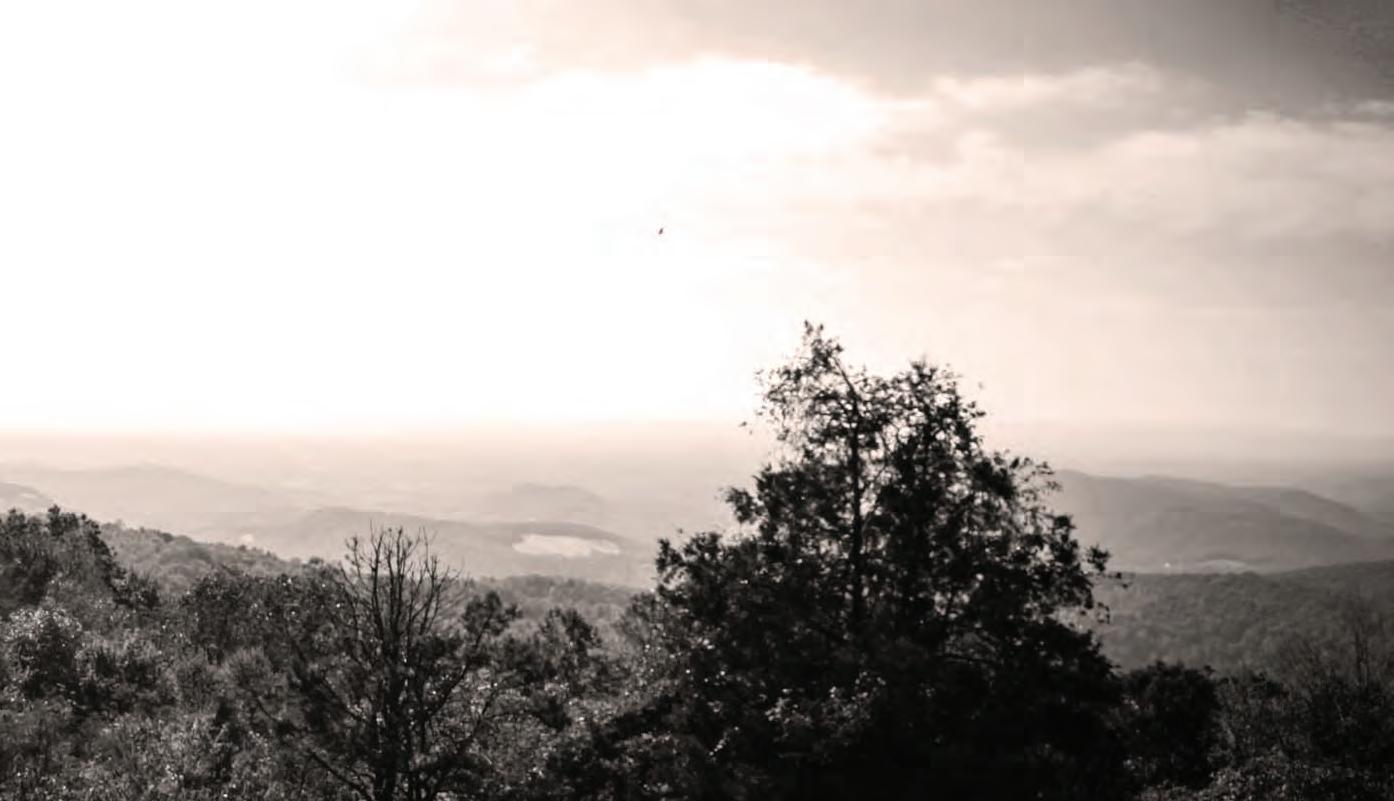
Agencies
PuBLIc enGaGeMent anD vISIon
hIStorIc
Insights,
uSer GrouPS, DeSIGn StanDarDS, anD traIL character
6: Section Management and Implementation
Manager and Delegated Community Groups Areas of Responsibility
the Need and Climbing
Trail Support
Key Stakeholders
Potential Funding Sources (A-3) Assets (A-4) Public Workshop Attendance (A-5) Public Workshop: Ideas, Insights, Barriers, and Big Ideas (A-6) Trail Towns Assessment Summary (A-7) Trail Towns Assessment: Elkin (A-8) Trail Towns Assessment: Jonesville (A-9) Trail Towns Overview (A-10) Trail Towns Case Study (A-11) Letters of Support (A-12) Federal Highway Administration Pedestrian and Bicycle Facility Design Flexibility (A-13) Sample Memorandum of Understanding (MOU) (A-14) Public Comment Process and Results (A-15) National Park Service (NPS) Draft Comments
The Mountains-to-Sea Trail is a significant asset within northern Stone Mountain State Park.
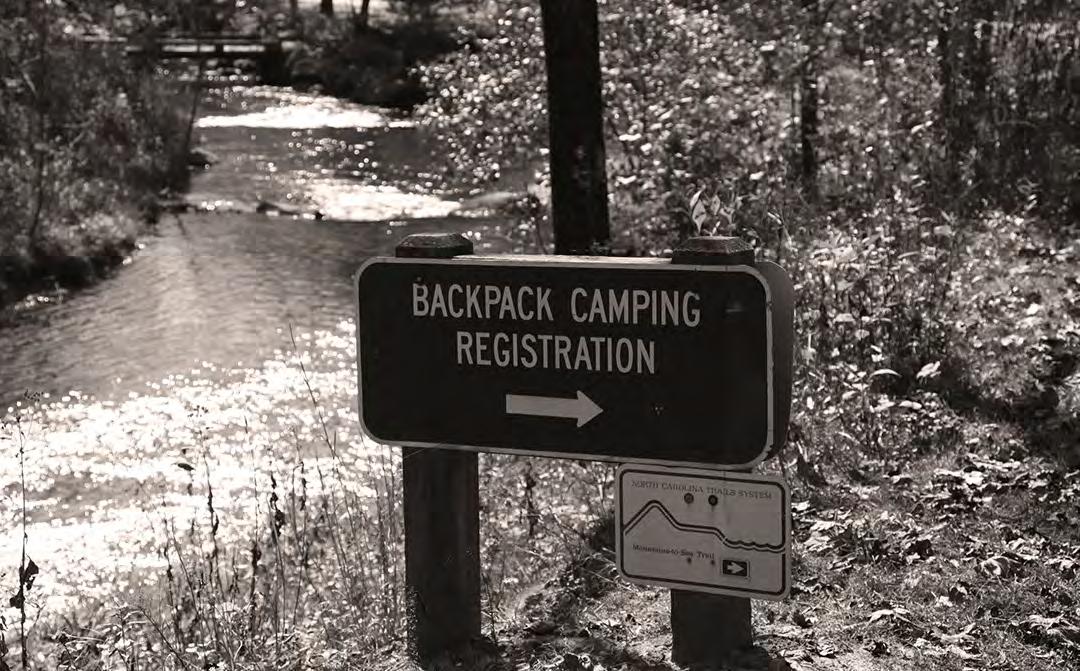
Also, the Elkin Valley Trails Association (EVTA) has made considerable progress in trail development and securing landowner agreements between Stone Mountain State Park and the Town of Elkin. EVTA continues to solidify its position as one of the premier trail development non-profit organizations in North Carolina.
In 2013 health directors from across the 10-county region of northwest North Carolina created a regional plan for establishing new active living opportunities throughout their jurisdictions. The plan – Health by Design – was funded by the Community Transformation Grant and identified forty (40) projects focusing on active living infrastructure. Of these projects, eight “Category 1” projects, including the Mountains-to-Sea State Trail (MST) - Sub Section Plan - Stone Mountain to Pilot Mountain State Park Master Plan, were selected for additional funding for plan development.
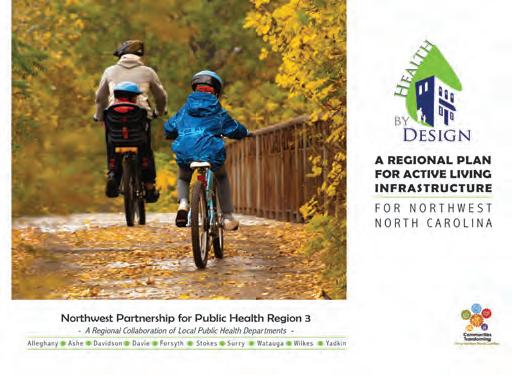
This planning effort ranked particularly well within the Health by Design plan since the proposed trail connector from Stone Mountain State Park to Pilot Mountain State Park enjoys such broad public support. Health officials from both Wilkes County and Surry County ranked this project as their top priority.
The recognition of need for this planning effort extends beyond the local and regional level - it is also of great interest to the North Carolina Division of Parks and Recreation’s (NCDPR) State Trails Program.
MST is a State Trail, and NCDPR provided matching grant funds to support this planning effort. State Trails Program leaders also provided benchmark planning goals to ensure that this plan would well-position local stakeholders to secure future grants.
The MST Plan was identified as a major priority within the regional Health by Design plan.
The Health by Design plan study area includes North Carolina’s 10 northwestern counties, referred to as Region 3 by the NC Association of Local Health Directors.
The Mountains-to-Sea State Trail - Sub Section Plan - Stone Mountain to Pilot Mountain State Park Master Plan serves as a comprehensive trail plan that is meant to guide local trail section managers as they strive to locate, design, and implement the Mountains-to-Sea Trail throughout the region. Also, this plan is critical as state trail development leaders, particularly those associated with the North Carolina Division of Parks and Recreation, continue to plan, develop and manage statewide trail systems.
EVTA officials host a community meeting updating the public about trail development work.

1. 2. 3.
Identify and engage all existing and potential supporting and funding partners;
Re-evaluate the North Carolina Mountains-to-Sea State Trail – Western Piedmont Section Plan;
Consider and define what user group(s) this trail might serve and define optimal trail corridor widths based on regulatory guidelines and expected traffic;
Consider and define how the trail/greenway might be constructed;
Define and prioritize trail routing options between Stone Mountain and Pilot Mountain State Park;
Identify segment managers, delegated community groups and partners; and
Identify the key factors necessary to justify segment manager staff, resources, and public funds for this project.
To SolIdIfy ITS PoSITIoN aS oNe of The PReMIeR TRaIl develoPMeNT NoNProfIt organIzatIonS In north CarolIna.
a. Meet with EVTA and other key stakeholders (listed in appendix) for project orientation
b. Discuss planning study area boundary and planning sections
c. Develop a schedule for field reconnaissance
discovery and analysis
a. Acquire existing, pertinent GIS data
b. Identify existing and planned trails, key assets (listed in appendix), and environmental assets and constraints within the study area
c. Conduct thorough field visits with key stakeholders
d. Host a public meeting to share initial analysis and glean new insights
a. Work with key stakeholders to identify preferred and alternative routes
b. Develop a complete map series of trail alignments according to planning sub-sections
c. Provide visual schematics, such as drawings or photo-renderings, that highlight significant trail features and opportunities
d. Develop an implementation strategy that includes an evaluation of each planning section and recommendations for trail implementation
e. Provide a draft plan (45-day public review period) to all local governments and stakeholder organizations impacted by the recommended trail route or the re-routing of the historic MST planned route.
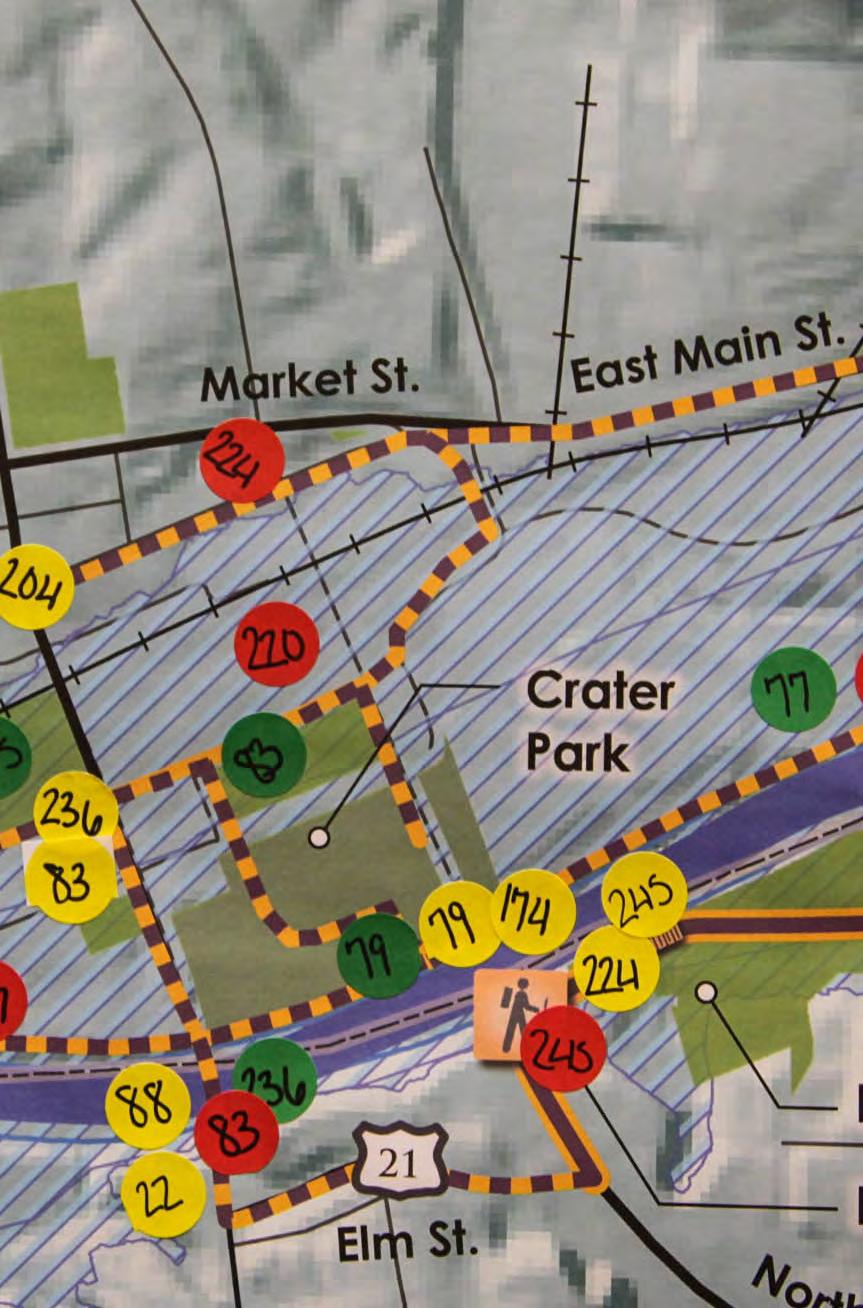
a. Finalize the draft planning document to include all content acquired throughout the planning process, incorporating all comments gleaned during the 45-day public review period.
b. Seek adoption of plan by local governing bodies
A critical component of the Discovery and Analysis Phase included identifying the public’s “ideas, insights, barriers, and BiG ideas.”
This plan is organized according to six (6) subsequent chapters: 1) The Mountains-to-Sea Trail: Its History and Previous Planning Efforts; 2) Overview of the Region; 3) Public Engagement and Vision; 4) User Groups, Design Standards, and Trail Character; 5) Trail Section Analysis and Objectives; and, 6) Section Management and Implementation.
Chapter 1: MSt history and Changing the historic Planning Route provides the historical context for the state’s foremost trail development priority. This chapter also evaluates previous MST regional planning efforts with significant implications for this study area.
Chapter 2: overview of the Region provides a brief geographic profile of the plan’s study area, which consists of a 50-mile area linking Stone Mountain State Park, the towns of Elkin and Jonesville, and Pilot Mountain State Park. This chapter also provides a description of the key nongovernmental organizations working to implement the MST in the region. The chapter concludes by summarizing local recreation and greenway plans, and other relevant plans related to MST development efforts.
Chapter 3: Public Engagement and vision describes the process of public outreach and inclusion, a critical element within the planning process. In March 2014, more than 80 citizens from across the Yadkin Valley attended the Stone to Pilot Trail Master Plan workshop. This chapter highlights many of the key “Ideas, Insights, and Barriers” gleaned from workshop participants.
Chapter 4: User Groups, Design standards, and Trail Character identifies the preferred trail construction and design standards that will best accommodate a widearray of trail user groups. This chapter also emphasizes a unified theme and design for trail support facilities, information kiosks, wayfinding signage, etc.
Chapter 5: Trail Section Analysis and Objectives serves as the heart of this plan, providing specific objectives for trail alignment and development throughout the study area. This section is organized into five parts, each representing a geographic sub-sector of the Study Area. The chapter emphasizes the six (6) major factors: public workshop comments; asset connectivity; relative parcel density; environmental assets; environmental constraints; and, segment manager capacity. Every effort was made to ensure that the trail follows the most meaningful and feasible route.
Chapter 6: Section Management and Implementation discusses responsibility for the long-term development and management of the trail. This chapter highlights trail segment managers, their geographic areas of responsibility, and their priorities for implementation.

1.
2. MST
3. Implications
MST
The Mountains-to-Sea State Trail (MST) is an effort to link Clingman’s Dome in the Great Smokey Mountains National Park to Jockey’s Ridge State Park located in the Outer Banks. NC State Parks deems the trail the flagship project of the North Carolina State Trails Program. Today more than 600 miles of the 1,000 mile route are complete and open for use. Utilizing temporary routes on backroads and bicycle paths, hikers can take part in an adventure across North Carolina. Partners across North Carolina are helping to plan and build the trail to link communities together and to serve as the backbone of a growing system of land and water trails. When completed, the route will pass through 33 counties that include approximately 40 percent of the North Carolina’s population.
The Mountains-to-Sea State Trail showcases the diversity of North Carolina’s natural beauty from the Appalachian Mountains to the Atlantic Ocean. Map from NCParks.gov.
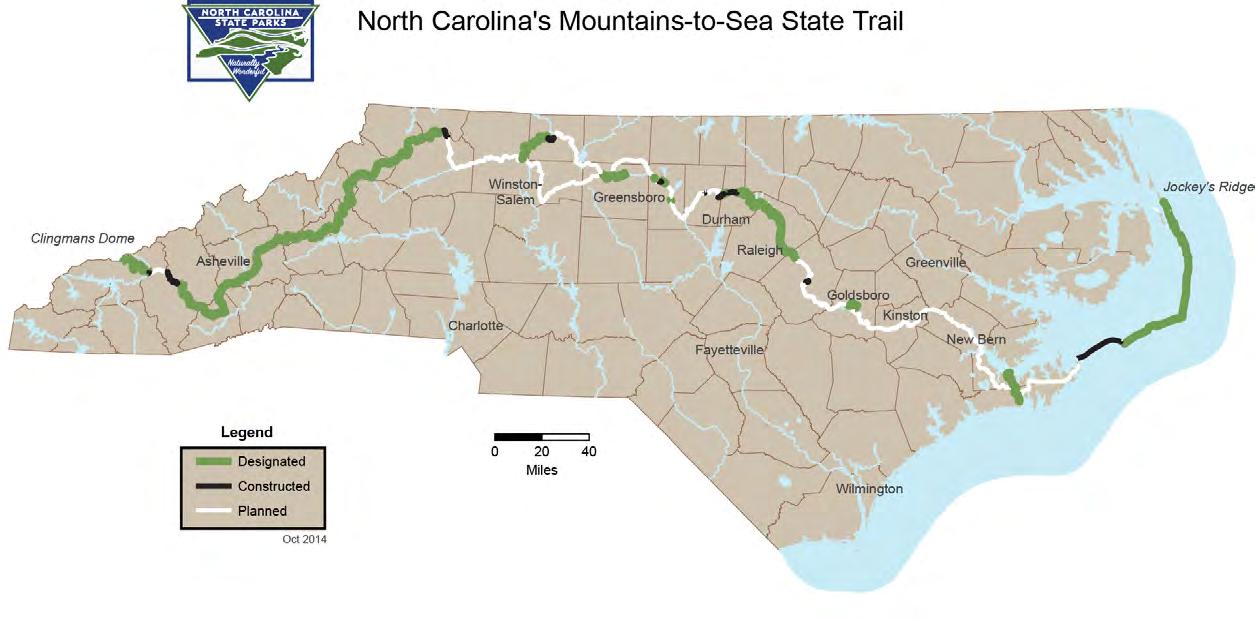
The trail concept was first proposed in 1977 by Howard Lee – then secretary of the N.C. Department of Natural Resources and Community Development. The Mountains-toSea State Park Trail was made an official landbased unit of the state park system by the General Assembly on August 2, 2000.
The vast majority of the foot trail is located on lands not directly managed as part of its associated state park unit. The trail is a part of the North Carolina State Trails Program and as of August 2014, 608 miles of trail has been designated as a part of the MST. The segments of MST along the Blue Ridge Parkway were designated as a National Recreation Trail in 2005. The MST has the distinction of being the highest elevation, long-distance trail in the eastern United States, where it crosses Mount Mitchell at 6,684 feet (2,037 m).
In 1977, Howard Lee (right), then Secretary of the Department of Natural Resources and Community Development, accompanied by Dr. Doris Hammett (left), first announced the idea of “establishing a state trail between the mountains and the seashore in North Carolina” at the National Trails Symposium in Lake Junaluska.
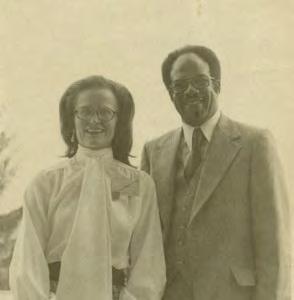
The MST was created not only for its recreational benefits, but also because of its implications for further developing North Carolina’s outdoor recreation economy. The outdoor recreation industry sector in North Carolina has experienced significant growth and warrants public sector investment to help generate private sector job growth.
The number of norTh Carolinians parTiCipaTing in reCreaTional aCTiviTies over The pasT deCade


40.5 Million
• Is North Carolina’s longest marked footpath at present
• Is one of North Carolina’s State Trails
• Climbs both the tallest mountain peak and the highest sand dune in the Eastern United States
• Is being built and maintained by trail clubs, local communities and state parks
• Passes through 33 counties
27.4 Million
top outdoor recreation activities by percent of state residents who participate
• Showcases the state’s diverse landscape from hardwood forests and tea-colored swamps, fading tobacco crossroads and reviving urban centers, courthouse square towns and rugged gorges, remote lighthouses and mountain overlooks
• Passes through three national parks and two national wildlife refuges
• Meanders through three national forests
• Passes three lighthouses, including the nation’s tallest
• Connects 10 State Parks: Jockey’s Ridge, Falls Lake, Cliffs of the Neuse, Eno River, Haw River, Hanging Rock, Pilot Mtn., Stone Mtn., Grandfather Mtn., & Mount Mitchell
• Was proposed in 1977 and added to the state park system in 2000
• Highest elevation: 6,684 feet on Mt. Mitchell
• Lowest elevation: 26 feet on Cape Hatteras National Seashore
• Takes approximately 2,112,000 footsteps to complete
• Includes two ferry rides
• 851 volunteers worked more than 18,500 hours to build and maintain the trail in 2012
Parks
Recreation,
changing the historic planning route
The MST incorporates many notable trails as part of its route.
• The MST shares several miles of its route with the Appalachian Trail near the MST’s western trail-head.
• The Art Loeb Trail from Davidson River Campground in Brevard to Daniel Boone Boy Scout Camp
• The MST follows most of the Tanawha Trail’s length.
• The MST shares most of the Sauratown Trail’s route, which is the only bridle trail that connects two NC state parks and is the longest trail on private owned lands in the state.
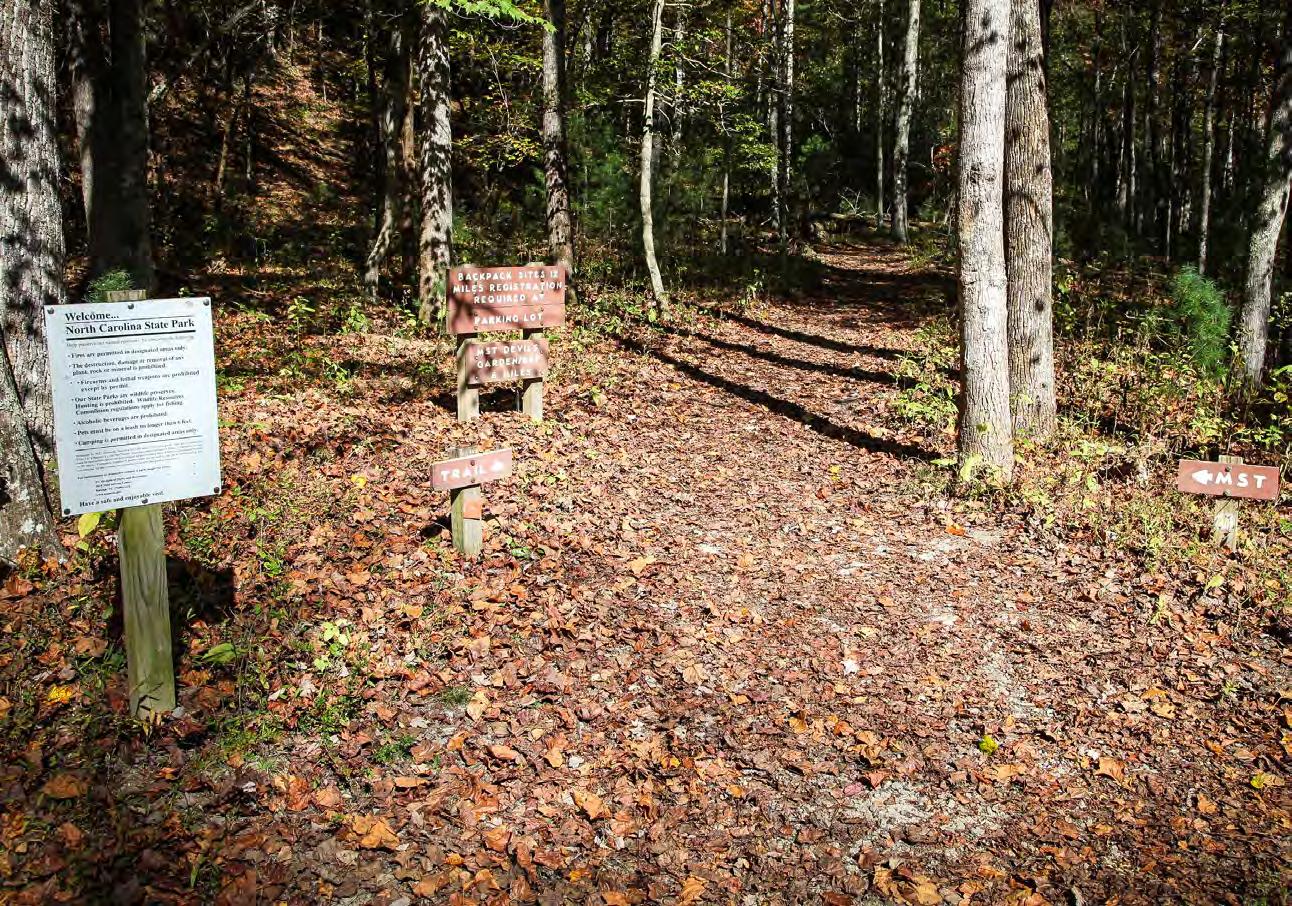
• A recent addition to the trail is the Haw River Trail (partially opened) which begins at Haw River State Park in Guilford and Rockingham Counties and continues to Cane Creek in southern Alamance County and on to Chatham County.
• The MST follows the entire length of the Neusiok Trail which traverses the forest from a sandy beach on the Neuse River to a salt marsh on the Newport River.
The MST utilizes a variety of trail networks across the state, such as those within Stone Mountain State Park.































In 2006 the Piedmont Triad Council of Governments (COG) developed the Western Piedmont Section plan for the Mountains-to-Sea State Trail through an inclusive workshop process. The plan’s study area extends from Lake Townsend in the east to Stone Mountain State Park in the west. The Stone Mountain State Park to Pilot Mountain State Park study area is fully within this study area, providing a detailed plan for nearly half of the planning section.
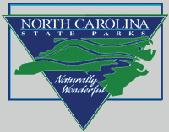


The COG plan recognizes that the MST trail could feasibly link to the Blue Ridge Parkway in a variety of ways. The plan identifies four (4) alternative routes and one (1) primary route for the MST. The alternative routes include Fisher River, Mitchell River, Old E & A Railroad, and Elkin Creek. The Roaring River corridor, which is located farthest to the west, is noted as the “Primary Planned Route.”
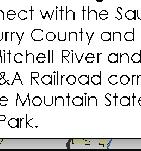











Primary Southern Urban Route













































Greenway through
BUS









Lake Brandt
Ridge
































































the proposed Piedmont
Guilford County; through Kernersville






County and around Salem Lake; along Salem Creek through Winston-Salem; up Muddy Creek through Winston-Salem, Bethania and Tobaccoville; along Old Pond Creek; along the Yadkin River through Pilot Mountain State Park in Surry County; and continuing on as described in the Northern Rural Route above.


Alternate Routes (Listed from East to West): 1) From Haw River State Park in Rockingham County through Reidsville and Wentworth, follow along the Dan River with a spur to Eden and another spur up the Mayo River to connect with the Mayo River State Park; 2) From the Dan River along an abandoned railroad corridor through Walnut Cove in Stokes County and Rural Hall and Tobaccoville in Forsyth County; 3) From Triad Park to Belews Lake; 4) From northern Kernersville to Belews Lake; 5) From the south-west end of Belews Lake along an abandoned railroad corridor to Walnut Cove; 6) From the confluence of Salem Creek and Muddy Creek down the Muddy Creek to provide a spur connector with the Yadkin River in Davidson County; 7) from Muddy Creek through Lewisville to the Yadkin River and north along the Yadkin River; 8) from Muddy Creek along Mill Creek and Grassy Creek through Rural Hall and continuing north along an abandoned railroad corridor and various small creeks to connect with the Sauratown Trail in Stokes County; 9) from the Yadkin River north along the Fisher River through Dobson in Surry County and connecting with the Blue Ridge Parkway in Alleghany County; 10) From the Yadkin River north along the Mitchell River and connecting to the Blue Ridge Parkway in Alleghany County; 11) from Elkin north along an abandoned E&A Railroad corridor paralleling US21 and following various small roads and streams to connect with the eastern end of Stone Mountain State Park; and 12) from Elkin north along Elkin Creek to connect with the eastern end of Stone Mountain State Park.















HOWEVER, WITH THE CREATION OF THE ELKIN VALLEY TRAILS ASSOCIATION (EVTA) IN 2012, ExTENSIVE TRAIL IMPLEMENTATION WORK HAS BEEN PERFORMED ALONG THE ELKIN CREEK CORRIDOR.
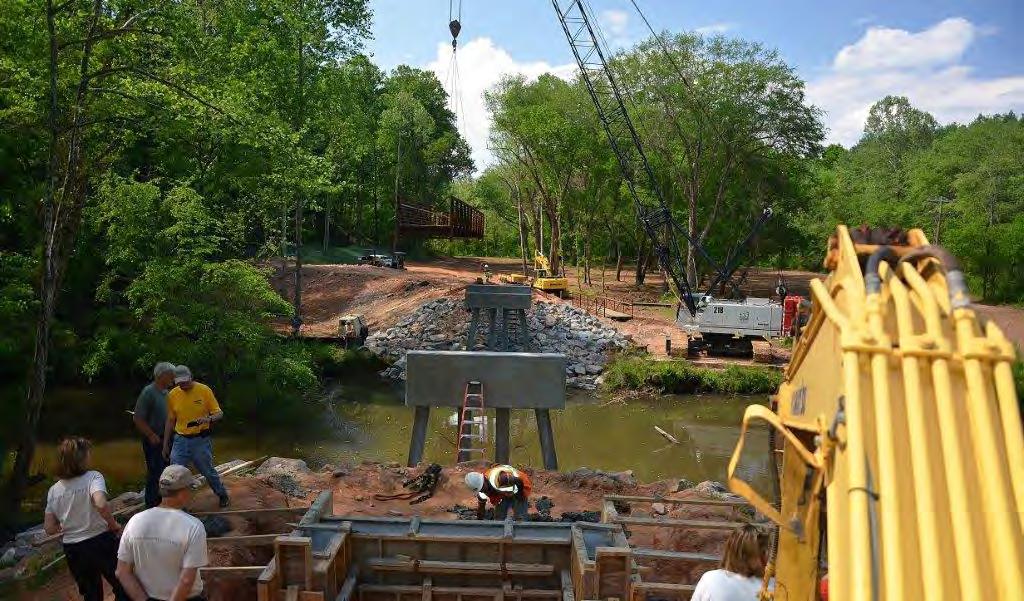

No trail construction efforts have been made along the Preferred Roaring River Route since the adoption of the COG plan in 2006.
In 2012 the Elkin Valley Trails Association (EVTA) was created. The association has completed trails along the Old E & A Railroad, Elkin Creek, and in the Wells Knob area. Additionally, planning work has been completed by EVTA to the south of Stone Mountain State Park. When these efforts are coupled together they signify the beginning (NE out of Elkin on the Old E & A Railroad and Elkin Creek), the middle (Wells Knob), and the end (south of Stone Mountain State Park) of a preferred trail route.
EVTA’s successes in this corridor have not been matched in any other area within the Stone Mountain to Pilot Mountain State Park study area. Consensus among a range of key stakeholders, including local governments and the general public (see letters of support in appendix) helped to solidify the Elkin Creek and Wells Knob Corridor as the preferred route as planning progressed. Furthermore, the route change has been endorsed by the Wilkes County Commissioners (Resolution from June 18, 2013) and Wilkes County has further agreed to hold trail easements.
Because of the extensive trail implementation efforts that have been made and the high level of community support, this plan designates the Old E&A Railroad/Elkin Creek/Wells Knob corridor as the new official MST preferred route.














The project study area begins at Devils Garden Overlook on the Blue Ridge Parkway.
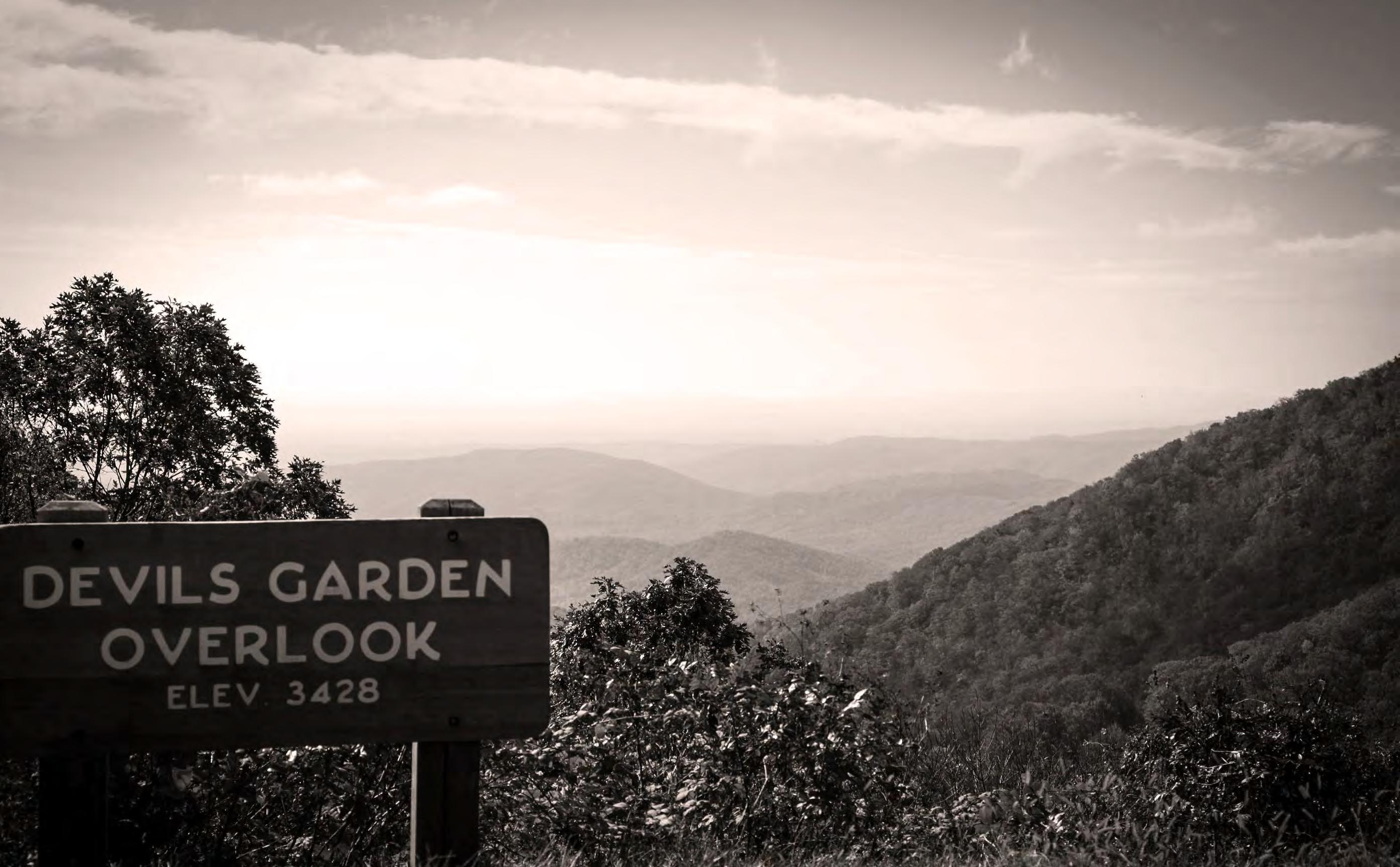
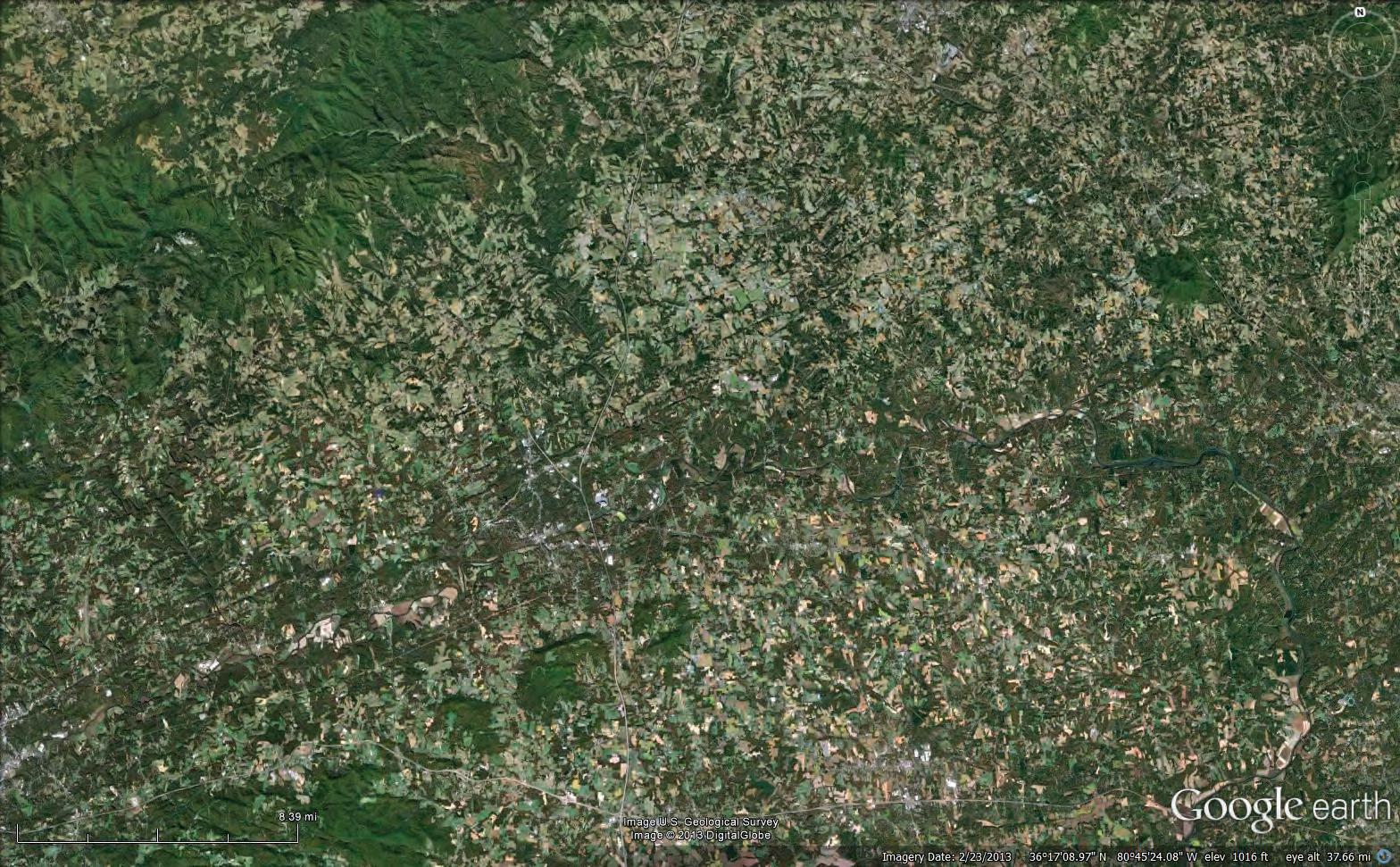
IN THIS CHAPTER:
1. Study Area
2. Key Agencies and Organizations


3. Previous Planning Efforts
This sub section plan of the MST stretches approximately 50 miles connecting Stone Mountain State Park, the towns of Elkin and Jonesville, and Pilot Mountain State Park.
The study area begins at Devils Overlook on the Blue Ridge Parkway before the Mountains-toSea State Trail enters Stone Mountain State Park.
From Stone Mountain State Park, the planning corridor, which is approximately two-miles wide, extends south over Wells Knob and then to Elkin Creek before reaching the Town Elkin and Town of Jonesville. From Stone Mountain State Park to Elkin is approximately 17 miles in length.
The Elkin Valley Trails Association has made significant trail development progress between Stone Mountain and the Town of Elkin.
East of Elkin and Jonesville, the planning corridor extends approximately 26-miles along the Yadkin River before reaching Pilot Mountain State Park.
Dobson W i l k e s C o u n t
Stone Mountain State Park
S u r r y C o u n t yCorridor Pilot Mountain State Park Mountainsto-Sea Trail to the Smokey Mountains Over Mountain Victory Historic Trail Sauratown Trail to Hanging Rock State Park
This section provides a brief overview of North Carolina Division of Parks and Recreation (NCDPR) and the many other non-governmental organizations working on behalf of the Mountains-to-Sea State Trail. A complete list of all existing and potential supporting/funding partners is located in the appendix.
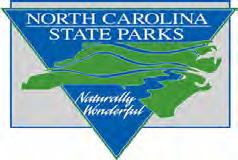
north Carolina Division of Parks and recreation (nCDPr)
The NCDPR provides critical funding, oversight, and coordination of the MST. The mission of the state parks system is to conserve and protect representative examples of the natural beauty, ecological features and recreational resources of statewide significance; to provide outdoor recreational opportunities in a safe and healthy environment; and to provide environmental education opportunities that promote stewardship of the state’s natural heritage.
elkin valley trails Association (evtA)



The mission of the EVTA is to increase the quality of life in the Elkin Valley by building and promoting a network of trails and greenways that will provide educational opportunities, preserve area history, promote health and wellness, provide economic opportunities and promote an appreciation and a respect for the environment in Wilkes, Surry and Yadkin Counties and connect with trails that link to the rest of North Carolina.
Yadkin river heritage Corridor Partnership (YrhC)
This YRHC works to promote economic development throughout the region including Caldwell, Wilkes, Surry, and Yadkin Counties. The recognizable YRHC logo influenced the branding for this plan.
friends of the Mountains-to-Sea trail (fMSt)
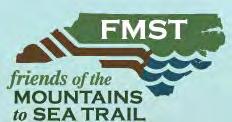
FMST is comprised of a growing group of citizens and volunteers who support the stewardship and development of the MST throughout North Carolina.
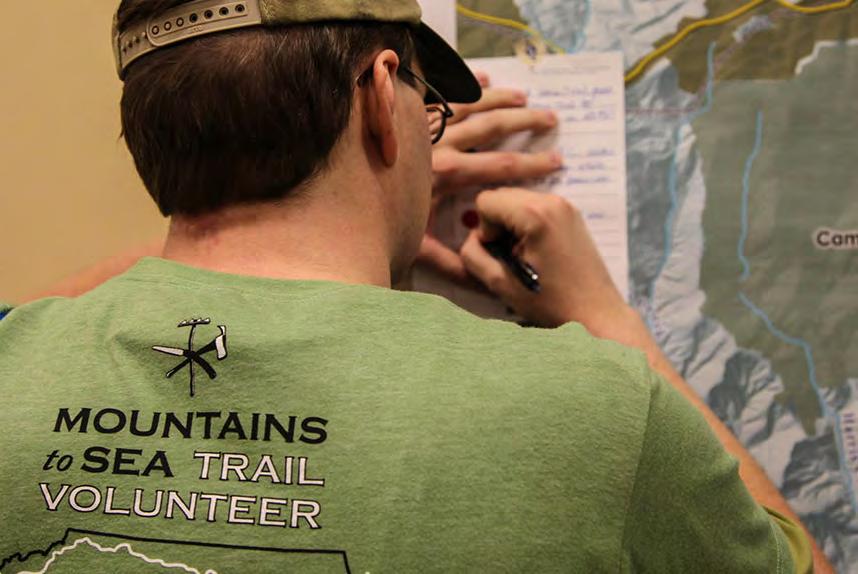
in
The Rockford Historical Society works to promote and preserve the historical legacy of Rockford, NC, which is located north of the Yadkin River in Surry County. Rockford is located between Elkin and Pilot Mountain State Park.
Yadkin Riverkeeper is a non-profit organization and a licensed member of the Waterkeeper Alliance. They seek to maintain and improve the quality of the Yadkin River Basin through education, advocacy, and action. The Yadkin River is a state designated

trail.

Formed in 1988, the Sauratown Trails Association (STA) is a nonprofit organization dedicated to promoting, creating and maintaining horseback and hiking trails in Stokes and Surry counties of North Carolina. STA’s primary mission is to steward the 25-mile Sauratown Trail, which extends from Pilot Mountain State Park to Hanging Rock State Park.
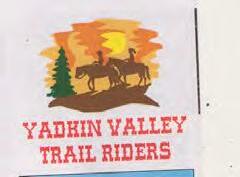
The Yadkin Valley Trail Riders work to promote, develop, and steward equestrian trails throughout the Yadkin Valley region of North Carolina.
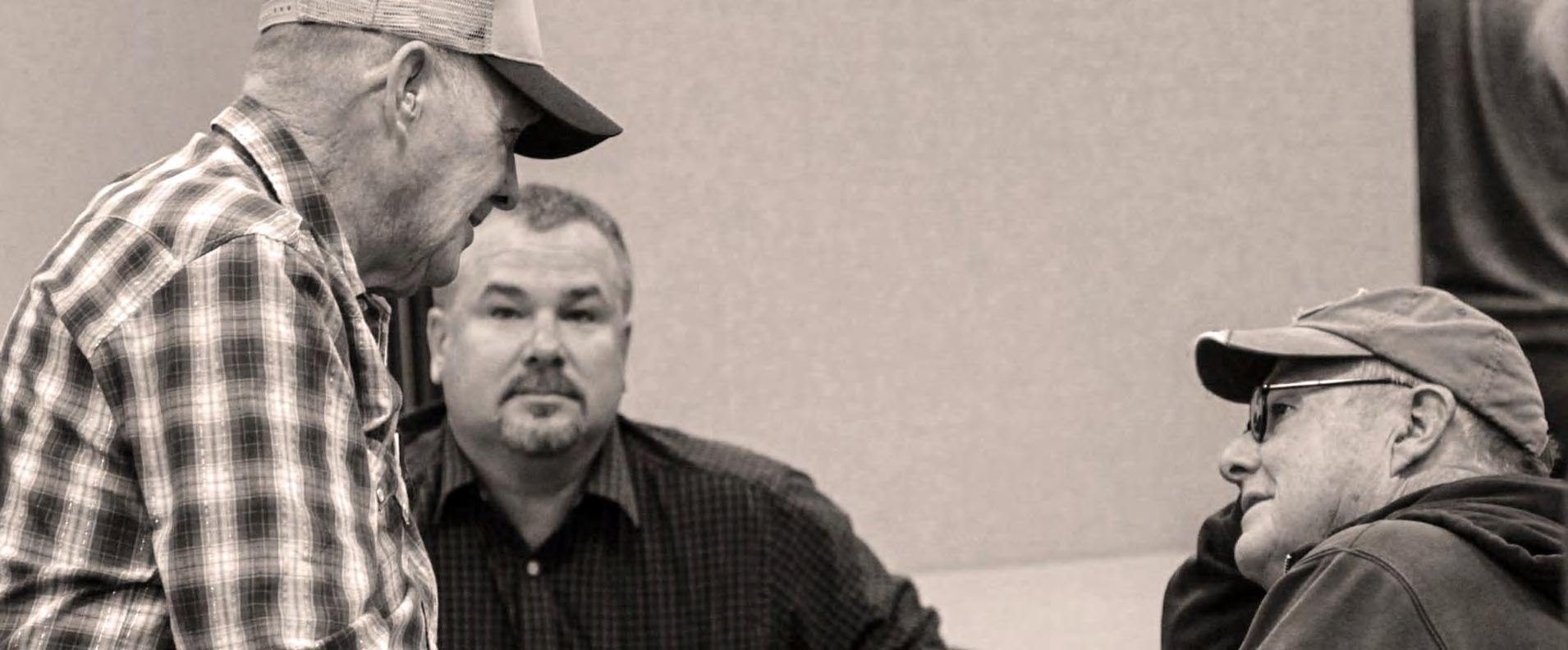
friends of Sauratown Mountains
The Friends of Sauratown Mountains provides a concerted effort among organizations working to benefit the Sauratown Mountains and support Hanging Rock and Pilot Mountain State Parks.

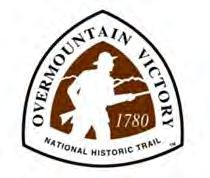
Established by the U.S. Congress in 1980, the Overmountain Victory National Historic Trail (OVNHT) commemorates the route taken by militiamen in 1780 from southwest Virginia, present-day eastern Tennessee, and the piedmont of North and South Carolina to Kings Mountain, South Carolina where a crucial Revolutionary War battle took place. Although the trail is not yet completed, 57 miles of the route throughout the 330 mile-long corridor are accessible to the public. Today, the trail is supported by the National Park Service, U.S. Forest Service, U.S. Army Corps of Engineers, Overmountain Victory Trail Association, various historical societies, and local citizens. The Town of Elkin serves as a major terminus for this nationally recognized trail, and portions of this MST sub section plan will include designated sections of the OVNHT.

The Recreation, Parks, and Greenway Plan for the Town of Elkin was adopted by the town in 2014. This plan addresses the Town of Elkin’s recreation needs in a holistic manner.
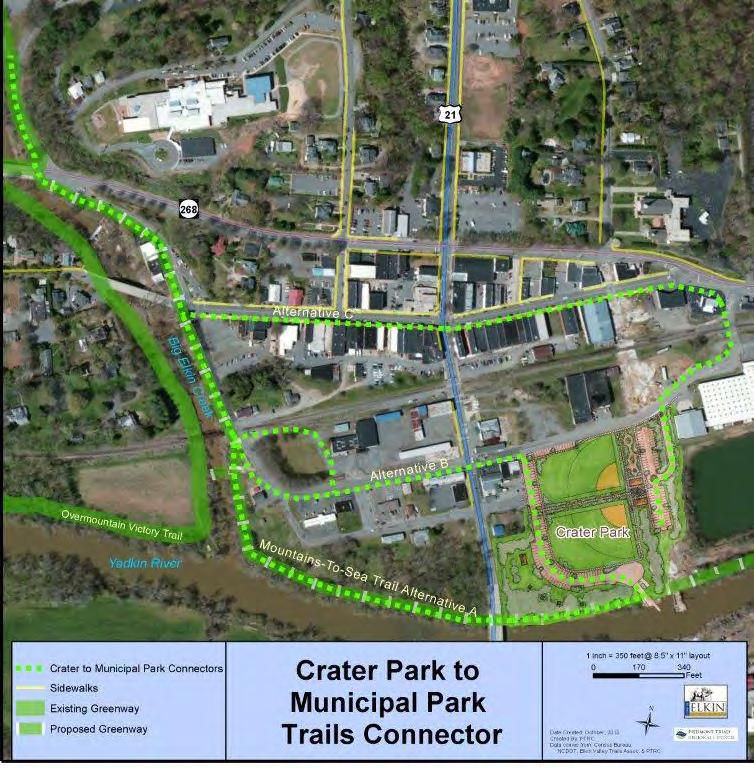
2014
the tOwn Of elkin ServeS AS A MAjOr terMinuS fOr the Ovnht. www.brpfoundation.org

OVNHT trail markers can be found at Elkin Park and along Elkin Creek.
Short-Term Planning Goals (1-5 years):
1. Trail connecting Municipal Park to Crater Park
2. Extension and expansion of E & A Nature Trail, including 1st major bridge over Elkin creek north of Municipal Park
Mid-Term Planning Goals (6-10 years):
1. Extend Mountains-to-Sea State Trail along Yadkin River and connect with Surry County’s Fisher River park
the 2014 recreation, Parks, and greenway Plan for the town of elkin provides various alternative routes for how a trail, such as the Mountains-to-Sea State trail, could traverse elkin’s municipal jurisdiction.

The Surry County Greenway Master Plan was completed in 2005. According to the plan, greenways would not only protect areas of cultural or historical significance, they would also allow access to these areas.
{Overall, this plan proposed that Surry County could benefit economically through increased regional tourism, preserving the quality of the rural landscape, and by preserving local cultural heritage.
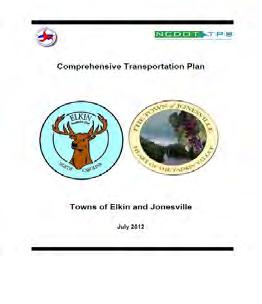
The Elkin/Jonesville
Comprehensive Transportation Plan, adopted in July of 2012, is a long-range multi-modal transportation plan that covers transportation needs through 2040. A major recommendation of this plan is a multi-use path on both sides of the Yadkin River spanning from Elkin Creek to Interstate 77. Additionally, the plan calls for on-road improvements throughout both Elkin and Jonesville.
A key objective of this plan is a trail along Surry County’s southern border: the Yadkin River.
The Elkin/Jonesville Comprehensive Transportation Plan, adopted July of 2012, recommends a multi-use path on both sides of the Yadkin River from Elkin Creek to Interstate 77.

While Yadkin County does not have an adopted greenway master plan, their Comprehensive Parks and Recreation Master Plan highlights the need for future trail and greenway development. There is a clear demand among Yadkin County residents for these facilities according to public meeting comments noted within the plan. Of particular interest to Yadkin citizens is further development of the Jonesville Greenway beyond the town limits and the opportunity to ultimately link to Pilot Mountain State Park along the Yadkin River corridor.
The Yadkin County Comprehensive Parks and Recreation Master Plan, adopted January 3, 2012, highlights citizen recommendations for expanding the Jonesville Greenway beyond the town limits and working to link a county trail to Pilot Mountain State Park.
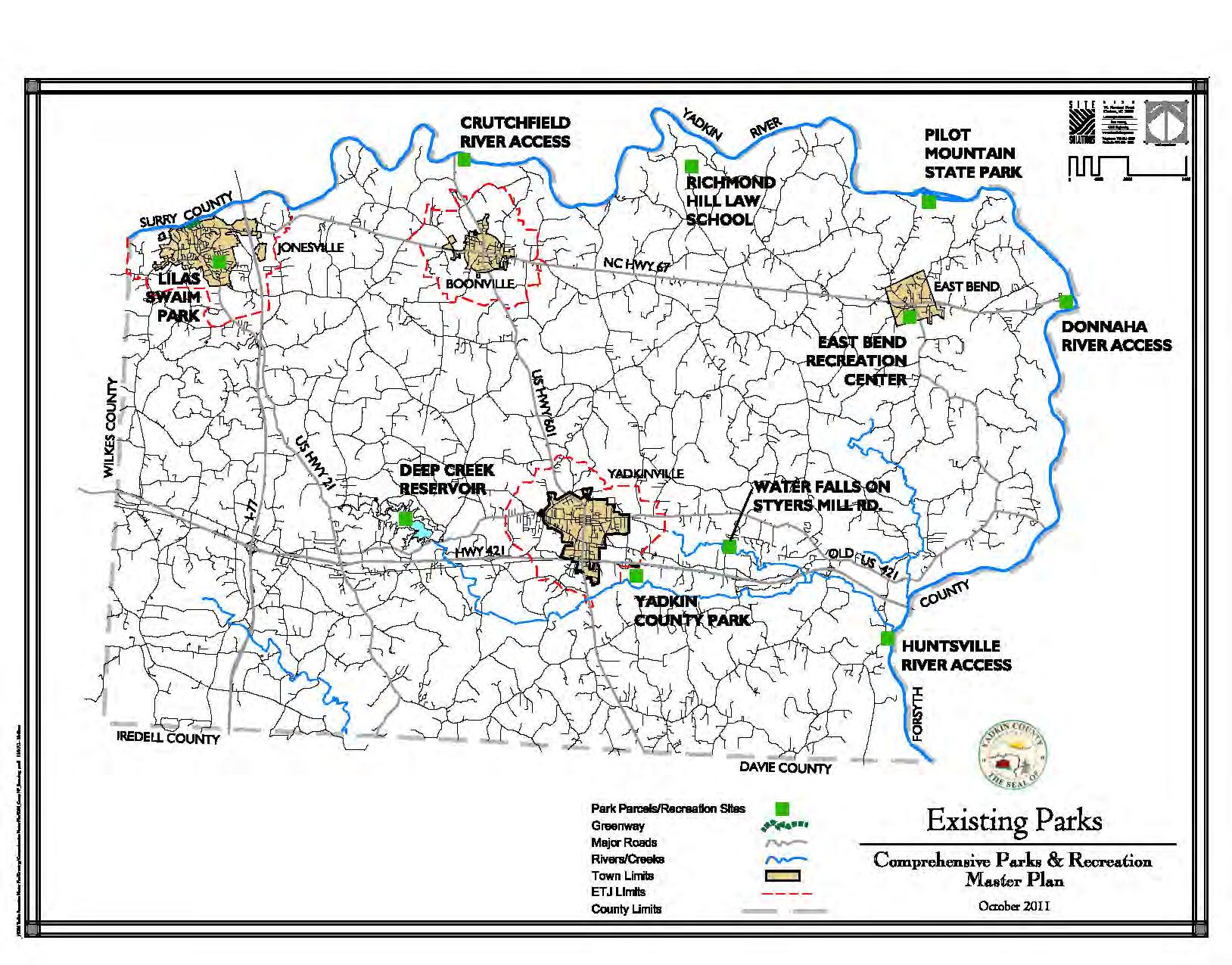


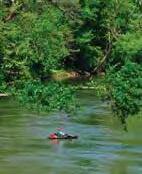


The Yadkin River Heritage Corridor Partnership developed this multi-county regional trail plan in 2008 with the purpose of creating a 113-mile heritage and recreational corridor to link, protect, and preserve significant cultural and historic assets within the fourcounty region including Caldwell, Wilkes, Surry, and Yadkin Counties.
DESSBusinessResearch,L.L.C.
PrincipalInvestigators
The


counties.





The Town of Elkin held a twoday workshop in December 2012 to allow community leaders to help envision the possibilities for an adaptive reuse of the Smith-Phillips Building downtown at 257 Standard Street. The vision is to create a Heritage and Trails Center on this townowned property.
The Heritage and Trails Center will serve as a central hub for trail activity throughout the region.
Key principles were explored necessary for developing a sustainable redevelopment plan. The Elkin community’s strengths and assets were incorporated into the process. A conceptual master plan was developed for the site and surrounding areas, including connections to downtown, the river, nearby parks, trails and Main Street.
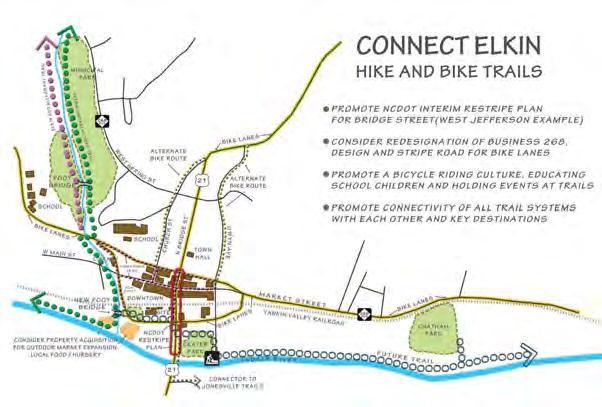
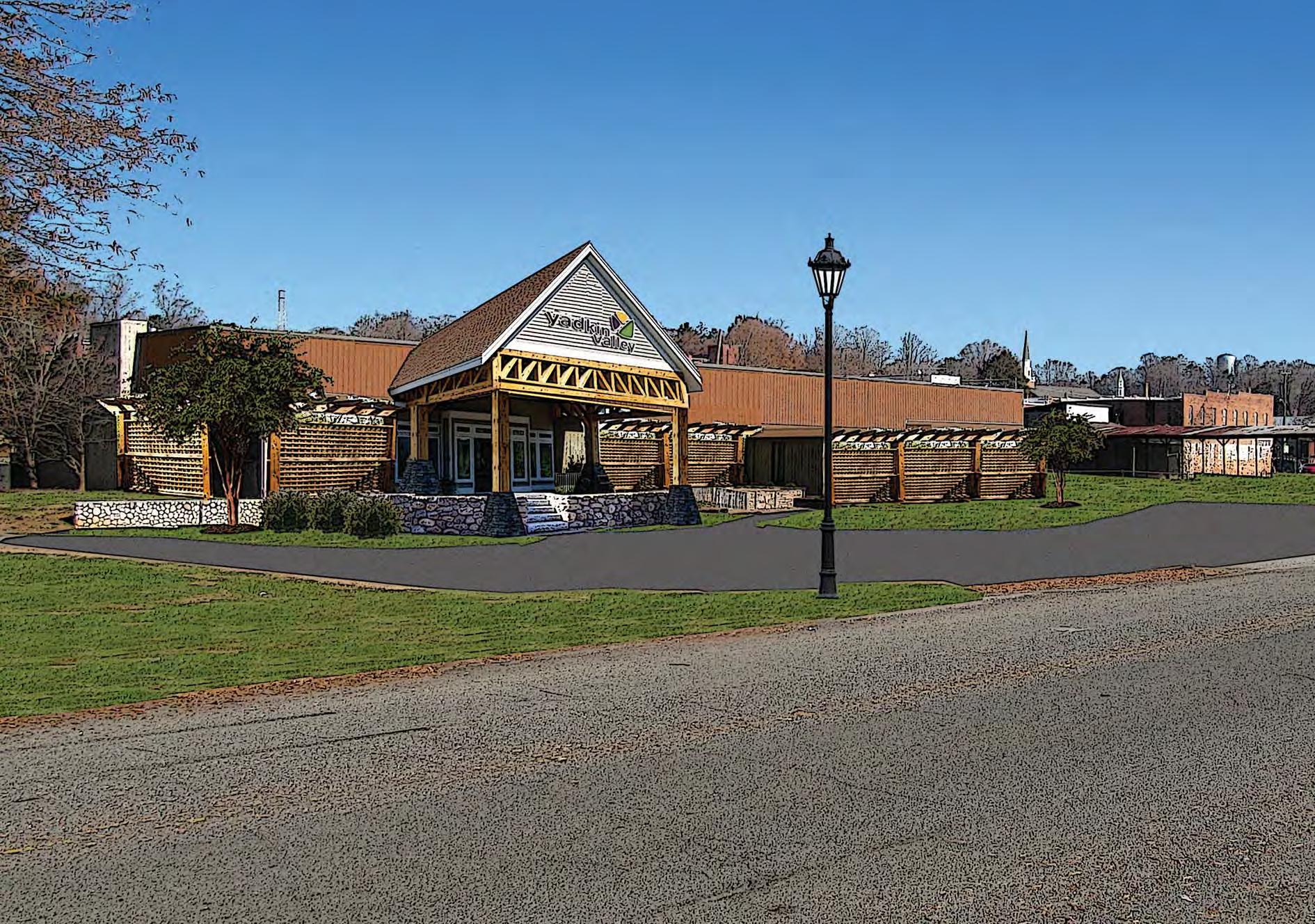
Over

2. Ideas, Insights, Barriers, and Big Ideas
On March 20th, 2014, more than 80 citizens from across the Yadkin Valley attended the Stone to Pilot Trail Master Plan workshop. The meeting was held at The Elkin Center in the Town of Elkin. An event flyer was developed and widely distributed via email by the Elkin Valley Trails Association and the Yadkin River Heritage Corridor Partnership. Furthermore, the event was publicized on the radio and through social media.
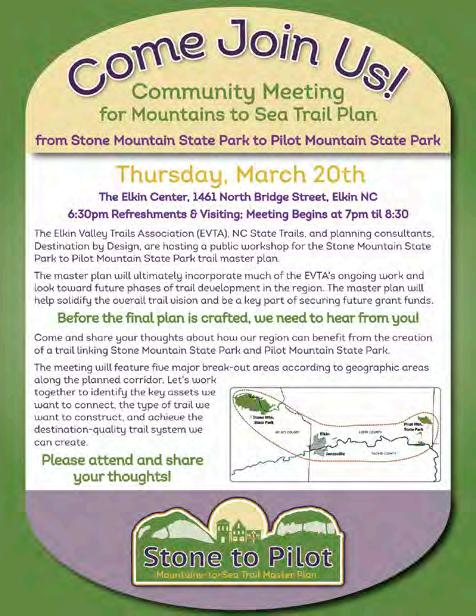
The Stone to Pilot study area is both extensive and diverse; the public workshop allowed the planning team to capitalize on the significant public interest and energy for this project and to identify the region’s many assets ideal for trail connectivity.

To begin the workshop, the consultant team presented results from the research phase of the planning process. This overview was the result of an extensive series of meetings with NCDPR, Elkin Valley Trails Association and other local government leaders throughout the region. The research phase overview provided a foundation and framework for engaging the public and generating their “Ideas, Insights, Barriers, and Big Ideas.”
The workshop began with an overview of the information gleaned from local trail development leaders, State Park Superintendents, and local government officials.
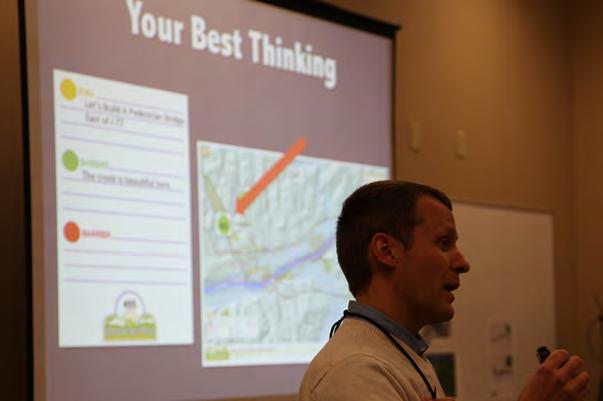
EVTA and NCDPR officials discuss MST development during a pre-workshop field visit.
After presenting the results of the research phase, DbD principal, Eric Woolridge, prepares workshop participants for idea generation.

The workshop allowed the public to brainstorm their “Ideas, Insights, and Barriers” for trail development


the study area. Five (5) stations were set up around the room according to geographic area. A sixth station was dedicated solely to “Big Ideas.” Attendees were provided with as many comment cards as they wished, which were marked with a







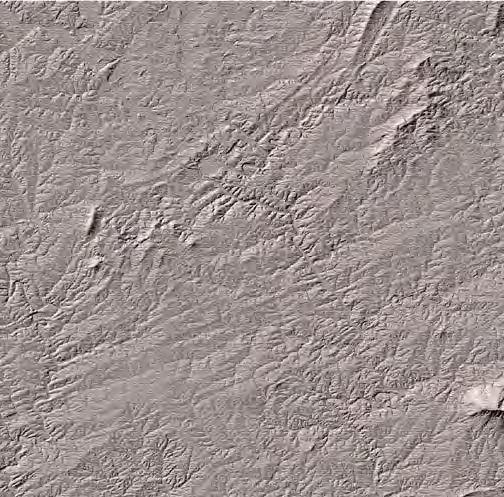
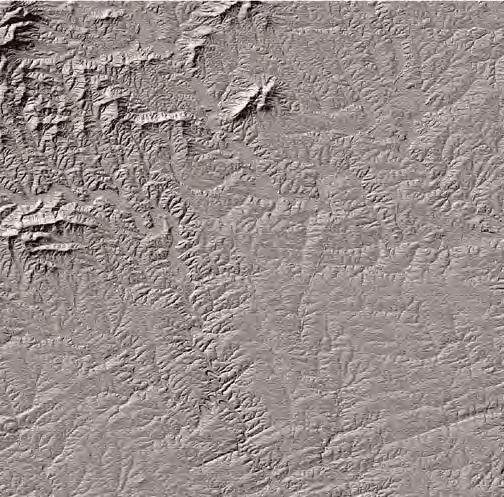

and sticker dot with the same number. This




the region.


workshop
research phase,

















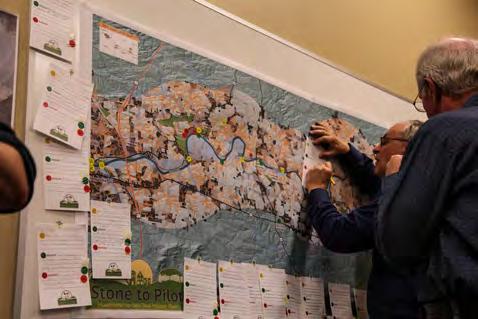
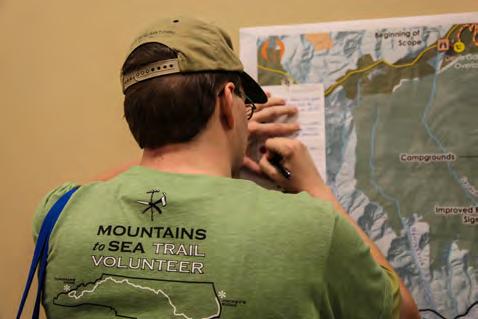









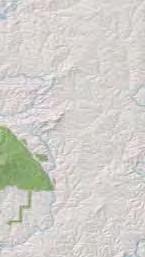

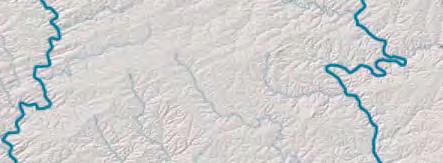
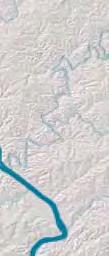
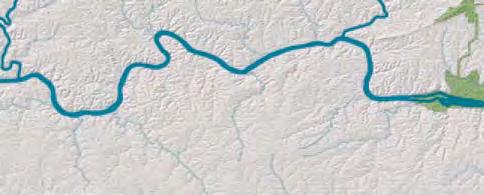



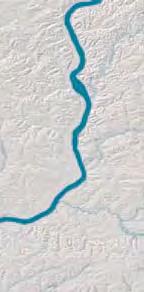
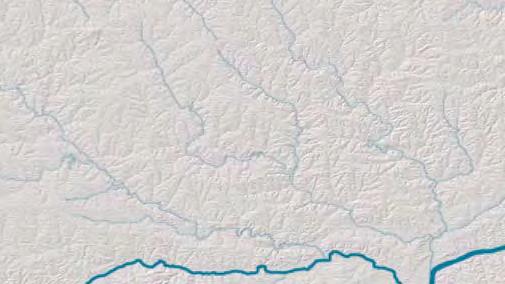


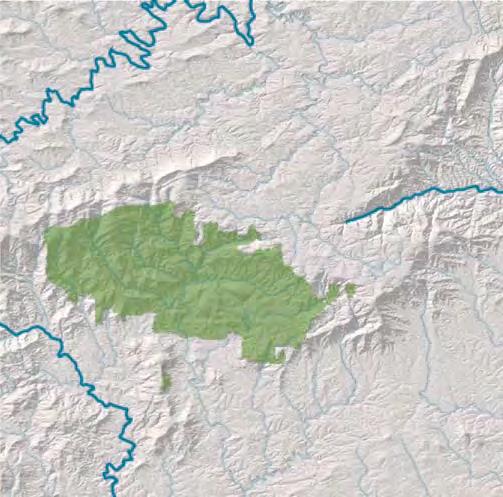
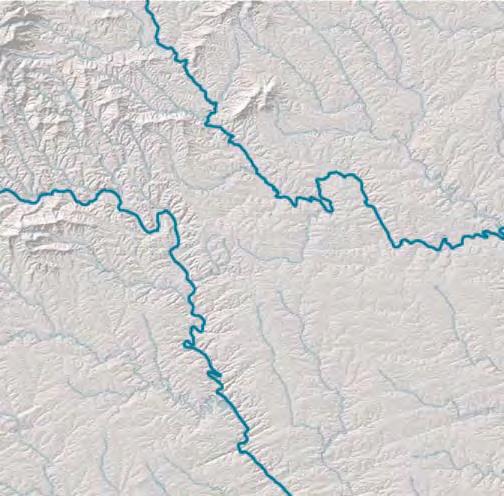

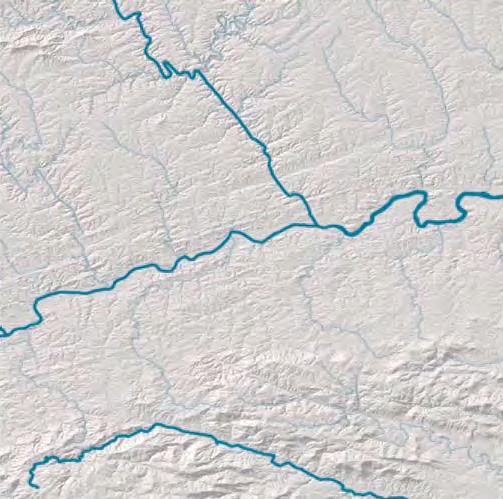












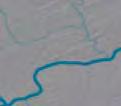




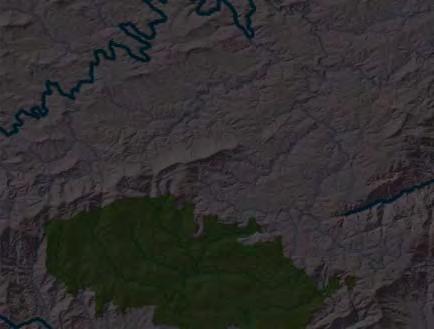











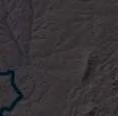



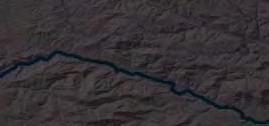



























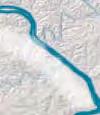



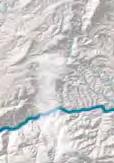
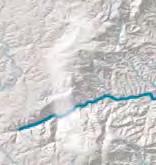
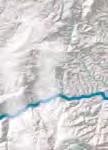


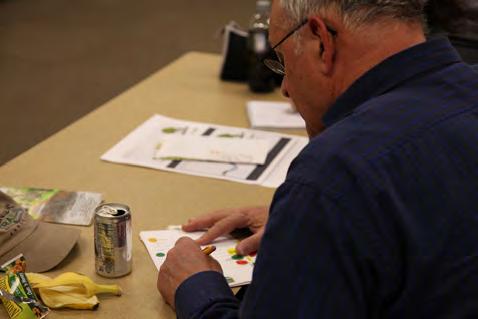
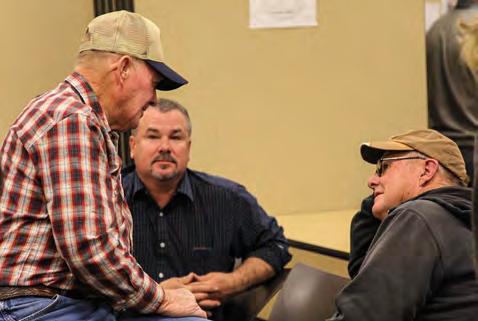


















DbD Principal, Teresa Buckwalter, recaps all of the BIG IDEAS to the participants at the Stone to Pilot Public Workshop.

1. Cycling on all trails
Have small libraries along trails for hiker to borrow books and return at other box
Carriage trails
Picnic areas and restrooms every 10-12 miles
Camp Ravenknob, Boy Scout Camp, Equestrian (Alt MST route for hikers and horses from Stone Mtn. horse parking to NC WRC Hunt Camp just outside Daughton Park. This would tie in 6.5 Fire Rd (open to riding) with rest of horse trails and create 30+ miles of backpack loop for hikers
Suspension bridge under I-77
Campgrounds: Many separate for horses and people
Hostel
Single track mountain biking
Bike Routes - Yadkin Co.
Trailhead parking
Connect Boonville

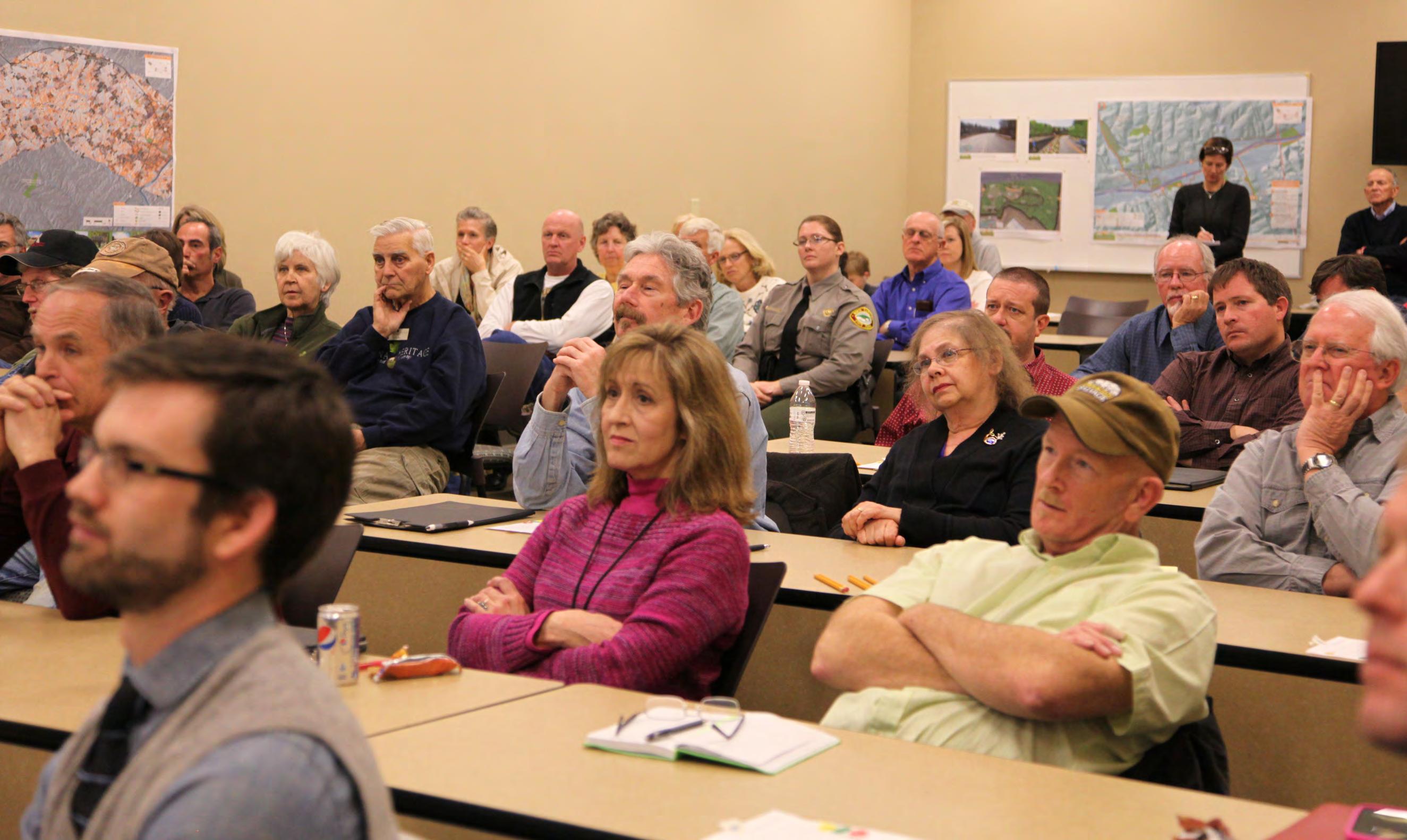
EVTA
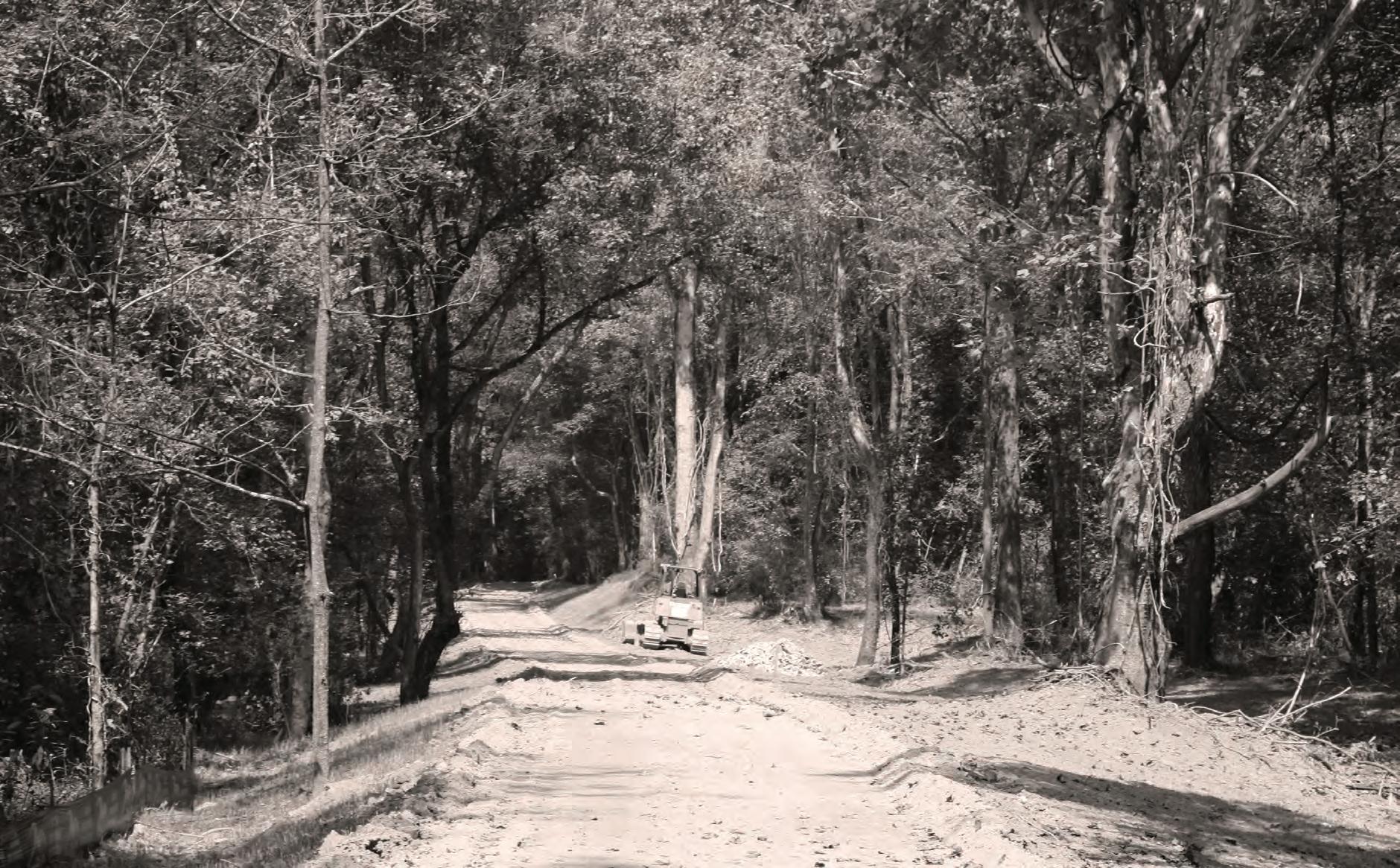
1. Overview
2. User Groups
2. Trail Types and Standards
3. Permitting
4. Trail Character
Because of its unique geography and mountains that frame a host of tributaries, two urban environments, and the wide and timeless Yadkin River, the Stone Mountain to Pilot Mountain State Park Sub Section study area provides for an array of user groups and experiences.
The purpose of this chapter is to outline the preferred trail construction and design standards for accommodating various user group combinations. As each section throughout the study area is examined in the subsequent chapter, a corresponding design standard will be applied. Also, this chapter provides specific design guidelines for trail support facilities, including information kiosks and wayfinding signage.
Direct trail connectivity to Elkin and Jonesville provides an opportunity to capture economic impact. Trail design must therefore accommodate as many users as possible for the longest extent possible, making Elkin and Jonesville the hub for trail
users. However, trail development must work in concert with other investments, such as downtown revitalization, land use planning, and infrastructure and community development.
Creating a broad trail user base to glean economic impact is a clear recommendation within the Yadkin Valley Economic Study. Also, this notion is supported within the planning goals* outlined within this plan, including:
• Consider and define what user group(s) this trail might serve, provide for as many users groups as possible, and define the optimal trail corridor width; and
• Create a trail system that maximizes regional economic impact.
* A list of all planning goals are found on page 3.
The International Mountain Biking Association’s (IMBA) Trail Solutions is a valuable resource for trail building of all types. Topics range from conceptual planning and organization to maintenance, and also include construction standards (see below).
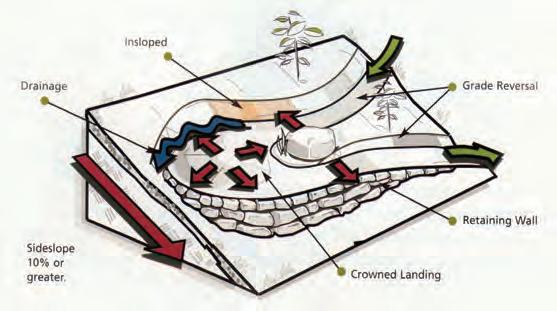
Construction standard for insloped turns.
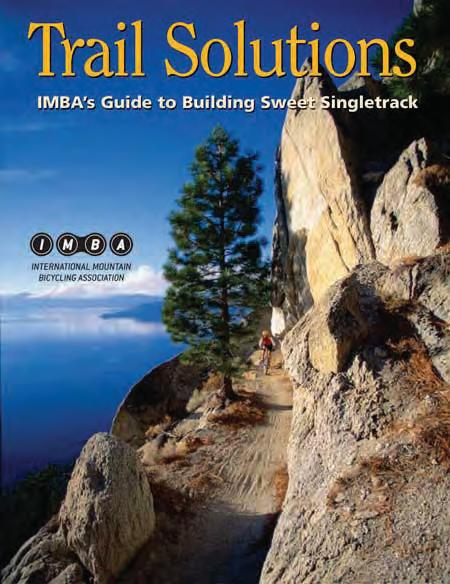
The trail user groups detailed below are classified into overarching categories, which include a list of potential trail user groups. Each of these overarching categories correspond to specific trail types, which are discussed in greater detail on the following pages.
Special attention should be given to any areas at which there is a transition between user groups. The same special attention should be given to areas at which user groups encounter roads, railroads, and rivers by incorporating safety concerns of all users and partner approval of trail conditions.
Horseback riding: Involves recreational horseback riding typically on natural surfaces or multi-use paths
Hikers: Utilize trails for recreational purposes usually for a day or less
Backpackers: Utilize trails for recreational purposes and typically stay for multiple days at a time Walkers: Utilize both trails and paved surfaces typically for exercise or daily commuting
Runners/joggers: Utilize both trails and paved surfaces for long-distance cardiovascular exercise
Trail Riders: Off-road bicyclists that utilize natural surfaces and trails
Road Riders: Bicyclists that utilize roadways and other paved surfaces
Canoing: Water navigation involving a small, pointed, open-top boat typically occupied by 1 to 3 individuals with oars
Kayaking: Water navigation involving a small and narrow boat operated by typically 1 individual with a double-bladed paddle
Rafting: Navigation through rivers characterized by rapids via a mediumsized inflatable vessel operated by multiple individuals with oars
Tubing: Water navigation involving an inflatable tube occupied by 1 individual without an oar or paddle
OHV’s or Off-Highway Vehicles, are specifically designed for off-road use. Examples of OHVs include all-terrain vehicles (ATVs), off-highway motorcycles, and snowmobiles.
During the public workshop, no favorable comments regarding OHV usage on the trail were provided. In addition, no OHV groups were in attendance at the workshop. Use of trails that are not specifically constructed for OHV use are subject to erosion, rutting and tree damage due to the weight and speed of OHVs. In addition, OHV usage of non-OHV trails presents a clear safety threat to other trail users, such as equestrians and pedestrians.

The Yadkin River Heritage Corridor Economic
Impact Study, which provides the only empirical research to project the volume of trail users in this region, anticipates 83,000 new visitors to the region upon completion of a trail along the Yadkin Corridor.
Do to the extensive length of the trail within the study area, which will naturally disperse trail users, and the sustainable trail design guidelines provided within this plan, this planned trail system could provide for considerably more volume. For example, consider that Stone Mountain State park and Pilot Mountain State Park effectively manage and provide for an estimated 181,075 and 227,993 hikers respectively.
The Yadkin River Heritage Corridor Economic Impact Study anticipates 83,000 new visitors to the region upon completion of a trail along the Yadkin Corridor.

(3) types of
of various
USER GRoUP:
MATERiAl:
PREfERRED WiDTh: 2’ to 4’ (Min.
PREfERRED EASEMENT WiDTh:
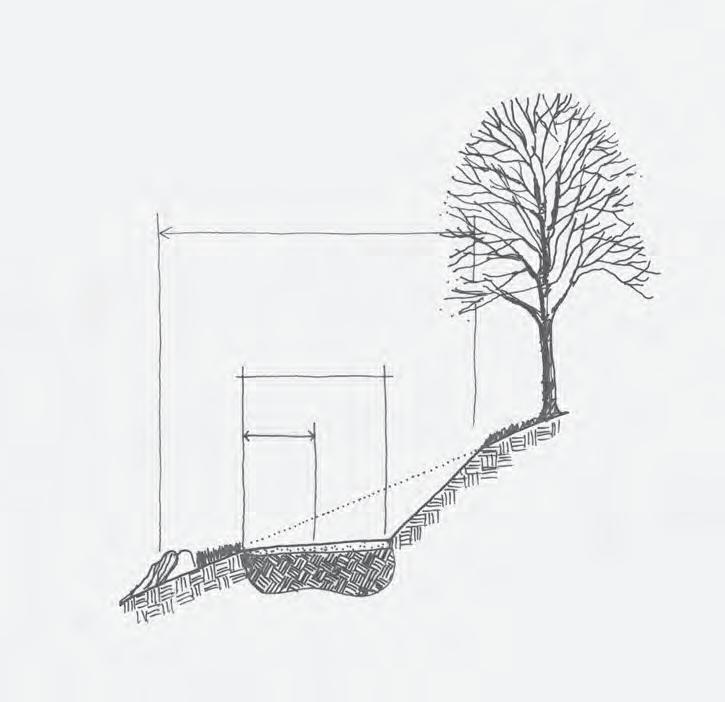
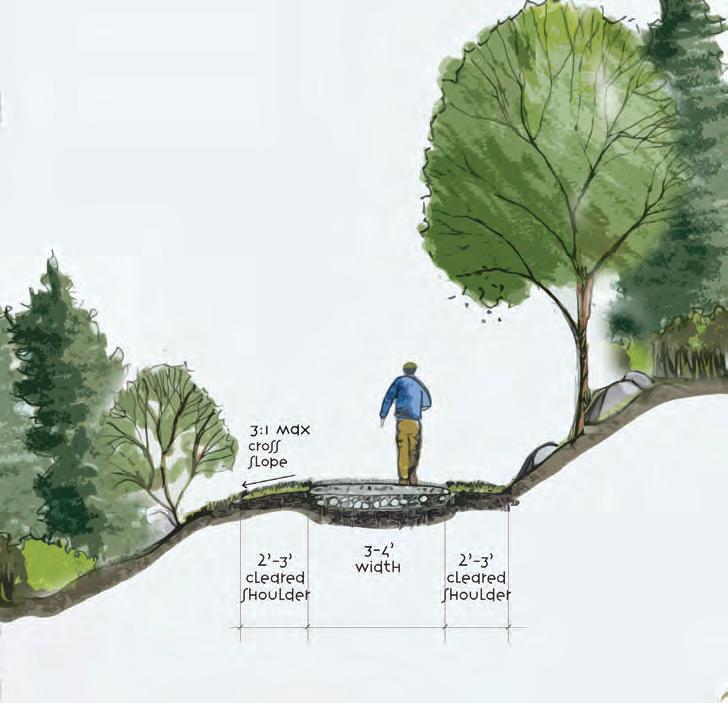
on terrain, landowner
railroad
Solutions:
– 100’
(B) Dual-use Trail
USER GRoUP: Equestrian & hikers
MATERiAl: Natural surface of crushed gravel fines
PREfERRED WiDTh: 8’ for two-way equestrian travel (Min. 5’)
PREfERRED loNGiTUDiNAl SloPE: Varied, but not exceeding 8% in order to minimize soil erosion. Trail to follow topography.
PREfERRED EASEMENT WiDTh: 50’ – 100’ depending on terrain, landowner willingness and proximity to roads, creeks, etc.
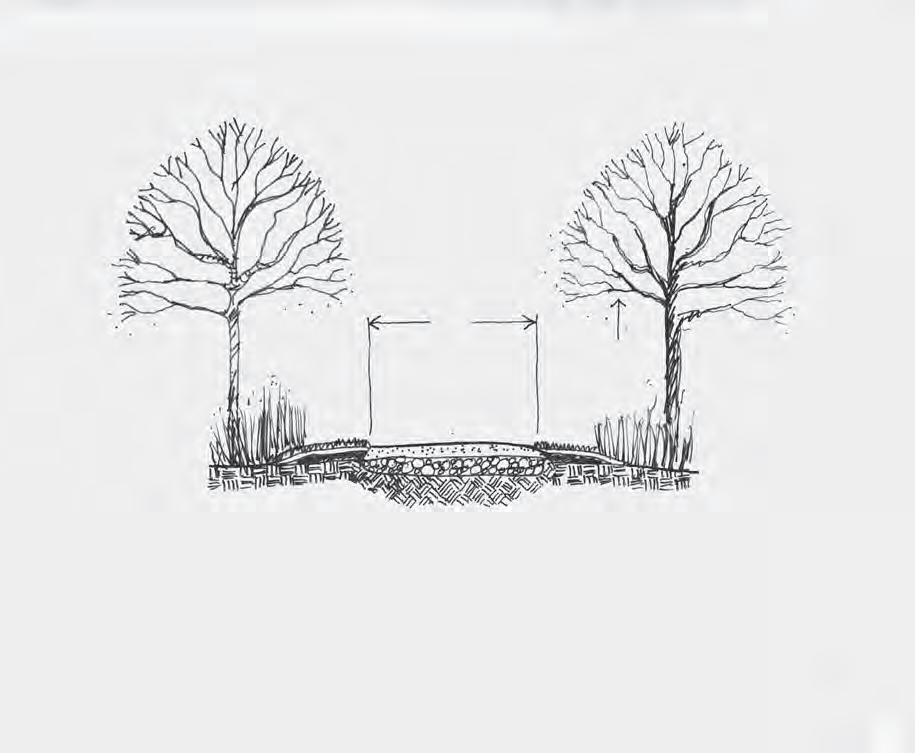
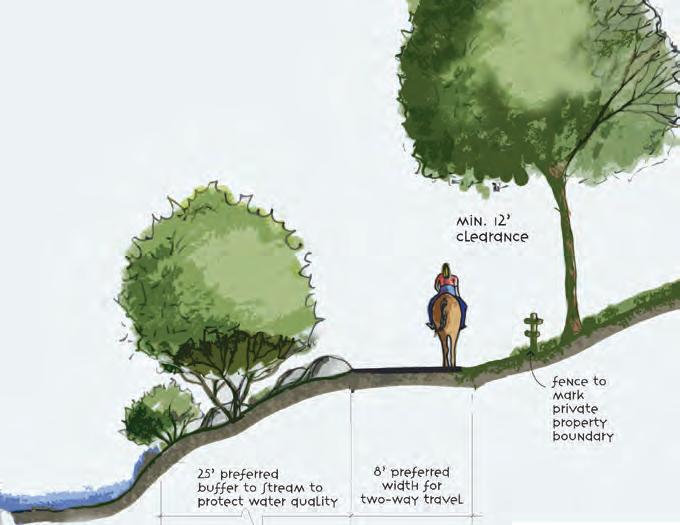
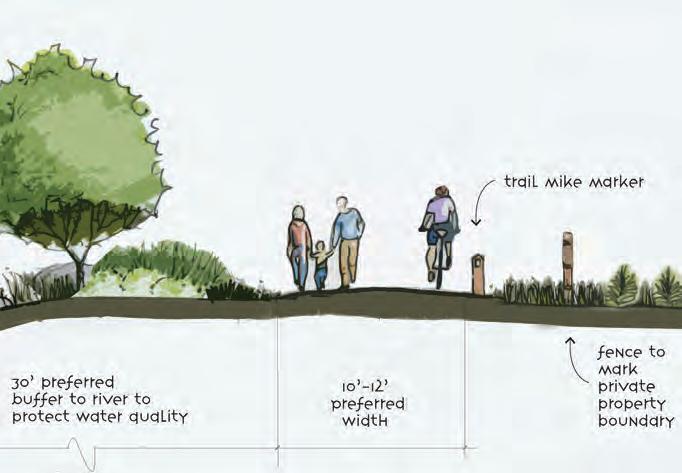
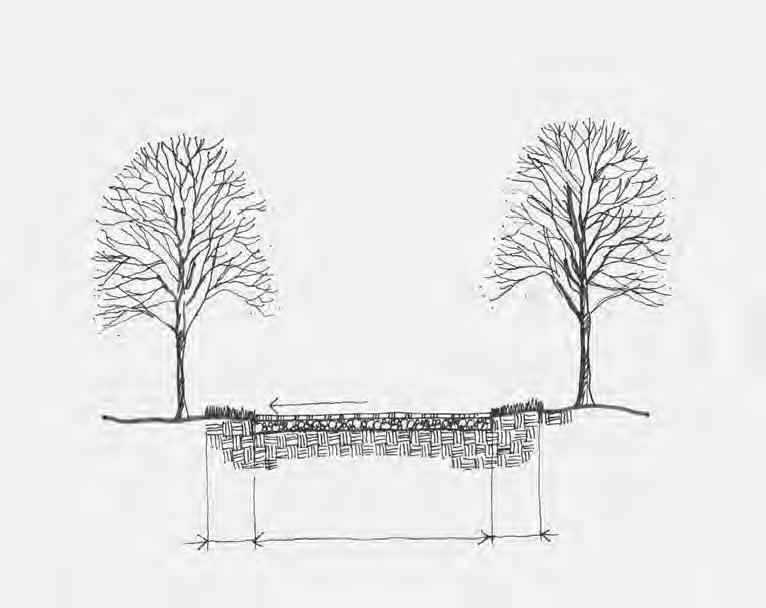
USER GRoUP: Hikers, bicyclists, wheelchair users, in-line skaters, strollers
MATERiAl: Bituminous pavement
PREfERRED WiDTh: 10’ to 12’ (Min. 10’)
PREfERRED EASEMENT WiDTh: 50’ – 100’ depending on terrain, landowner willingness and proximity to highways, rivers, railroad bed, etc.
MATERiAl: Parallel treads – one with crusher fines and the other bituminous pavement
PREfERRED WiDTh: 8’ for natural surface (crusher fines) trial and 10’ to 12’ for paved trail

PREfERRED EASEMENT WiDTh: 75’ – 100’ depending on terrain, landowner willingness and proximity to highways, rivers, railroad bed, etc.
NoTE: The Multi-use Greenway with Parallel Equestrian Trail is a preferred standard. In areas with topographic challenges the parallel trails may need to diverge from one another for a particular distance. In the case of “pinch point” scenarios, the two trails may need to consolidate into one trail for a particular distance.
Special consideration will need to be provided in areas where the trail intersects and crosses roads and rail lines.
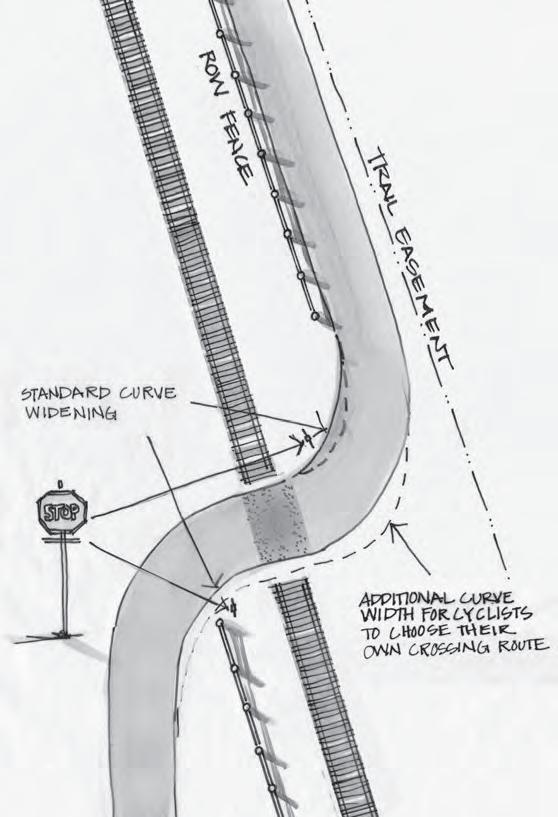
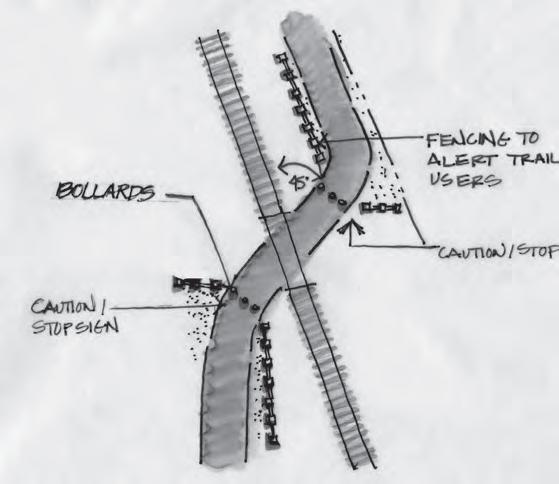
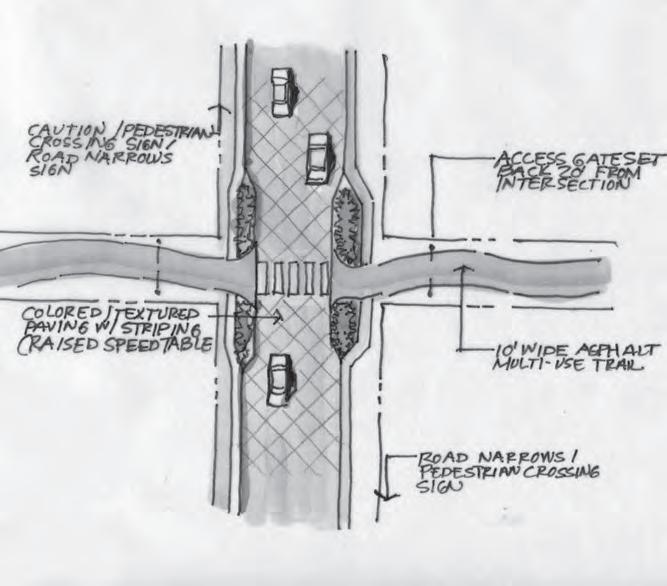
Signage will notify both trail users and vehicles of a pending crossing. An access gate or bollards should be located approximately 20’ from the road intersection, preventing vehicular traffic, but also providing access for maintenance and emergency service vehicles. In urban areas additional design elements can be incorporated, such as a raised speed table, textured paving, and the narrowing of the street to encourage traffic calming.
Signage will notify trail users of the pending railroad crossing. An access gate or bollards should be located approximately 20’ from the railroad intersection, preventing vehicular traffic, but also providing access for maintenance and emergency service vehicles. Fencing should be placed along the trail as it progresses towards the intersection, creating a gateway and signaling to trail users the unique environment ahead.
Signilization is required for 45 crossings.
Source: https://www.fhwa.dot.gov/environment/recreational_trails/ publications/rwt/page22.cfm
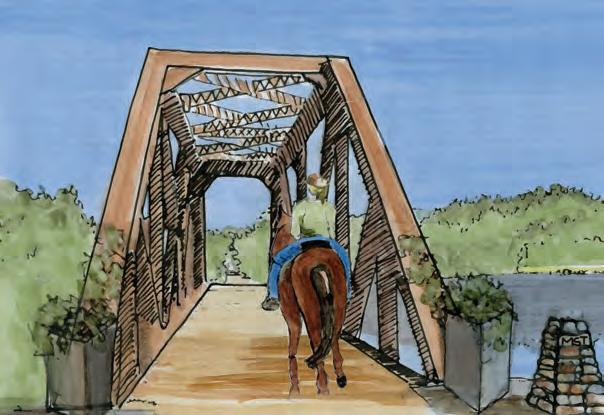
Building trails to accommodate equestrian riders requires knowledge of the needs and behaviors of horses and other trail animals (referred to as “stock”).
Planning for manure management at trailheads or providing access to water, for instance, are important considerations. In terms of behavioral matters, horses and mules are most comfortable in the track that other stock have trod. They favor the outer edge of a tread, especially if this ground is less densely packed.
In addition, stock tend to stay a comfortable distance away from other trail users and from walls or fences they cannot see through or over.
To accommodate this behavior, trails are recommended to be wider (5-8’) and routed away from disturbing activity. In addition to the tread width, a “shy distance” –added clear width on the edge of the trail—is important to design for. Any fence or shrub barrier should be open or lower than 54” for stock to see over or through.
Material of the trail is an important consideration for long term use and comfort. Crushed rock (preferably less than 1/2” in size) with fines, or crusher fines is a slip resistant, durable and dust free material which also
provides good horse comfort and lower maintenance than woodchips.
Lastly, considering a horse with a rider can weigh up to 1400lbs, the impact to trails can be significant. If not designed to accommodate water flow, horse trails can develop significant erosion. With this in mind, the longitudinal slope of a trail accommodating horse riders would preferably be no more than 8% (10% maximum). The slope of the trail should be less than 1/2 of the grade of the side slope. This may require a longer trail to traverse hilly terrain.
Any construction of the trail in the Right-of-Way of Department of Transportation will require an encroachment permit. This is obtained from the division engineering office. The study area is served by Division 11. Furthermore, all design standards will require approval from NCDOT. It is important to note that the U.S. Federal Highway Administration (FHWA) has indicated a change in policy toward more flexible design standards for bicycle and pedestrian infrastructure. (See FHWA memo in Appendix).
Streams are regulated under the Clean Water Act (CWA) by both federal and state government agencies. The US Army Corps of Engineers (USACE) regulates the dredging and filling of Waters of the US (including stream and wetlands) under section 404 of the CWA. The NC Department of Environment and Natural Resources (DENR) Division of Water Resources (DWR) regulates discharges of pollutants to Waters of the State under section 401 of the CWA.
Any impact to streams or wetlands throughout the corridor will require both section 404 and 401 permits. One application form is used for both permits and submitted to both agencies. Total stream impacts up to 300 linear feet can be permitted using Nationwide Permits (NWP) and associated Water
Quality Certifications. Impacts to stream exceeding 300 linear feet would require an Individual Permit (IP). NWP’s can typically be obtained within 45 to 90 days following submission of an application. IP applications are much more elaborate and can take up to 1 year for approval.
If impacts to stream exceed 150 linear feet, the USACE will require compensatory mitigation, usually at a 2:1 ratio. However, some streams within the corridor are considered High Quality Waters which would require mitigation at a 3:1 ratio.
If impacts to wetland exceed .1 acres, the USACE will typically require compensatory mitigation at a 2:1 ratio (3:1 with high quality wetlands).
A buffer is the land area surrounding a stream. If any section of trail impacts the buffer of a stream that is classified as a “Trout Stream” additional compliance is required. A 25’-wide buffer must remain undisturbed by development (including paved trails) on both sides of a classified trout stream. For encroachment into trout buffers that cannot be avoided and that exceed 10% of the total buffer length on the site or 100 feet of buffer in any 1000 feet of buffer (whichever is less) will require a Trout Buffer Waiver from the NC DENR Land Quality Section.
Any trail section that is established in the regulatory floodway will require a floodway study, or Flood Study to demonstrate that the proposed work will not result in any increase or decrease (beyond acceptable limits) in elevation or extent of the mapped 100 year flood. This “No Impact” certification is regulated through FEMA but sought through the local county government. Generally, any filling of soil in the floodway will trigger this requirement. As a result, some sections may require raised boardwalk instead of filling.




In 2012, the Yadkin Valley Heritage Corridor Partnership produced a detailed wayfinding and signage plan to help visually unify the region.
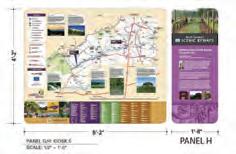
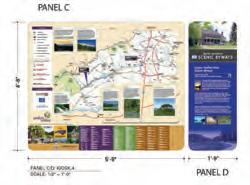
Through a recent grant awarded by the Federal Highway Administration, Surry and Wilkes Counties will soon implement elements of the signage and wayfinding program.
This wayfinding plan provides a template for signage across the region including signage associated with this section of the MST. All MST related construction documents within this region should incorporate signage specifications in accordance with this regionally adopted wayfinding plan.
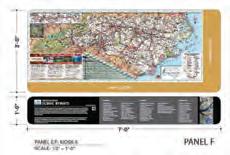

DbD

This chapter serves as the heart of the MST - Sub Section Plan - Stone Mountain to Pilot Mountain State Park Master Plan, providing specific objectives for trail alignment and development throughout the study area. The chapter begins with an overview of the methodology for determining the trail route and feasibility for construction. Subsequently, the chapter is organized into five (5) parts, each representing a geographic Section of the master plan study area, including: 1) Stone
Mountain State Park; 2)Wells Knob; 3) Trail Towns; 4) Yadkin River; and 5) Pilot Mountain State Park.
Public Workshop: Ideas, Insights,
Barriers Asset Connectivity
Parcel Density











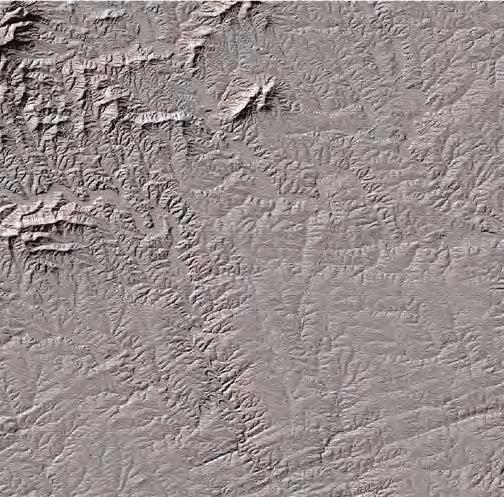
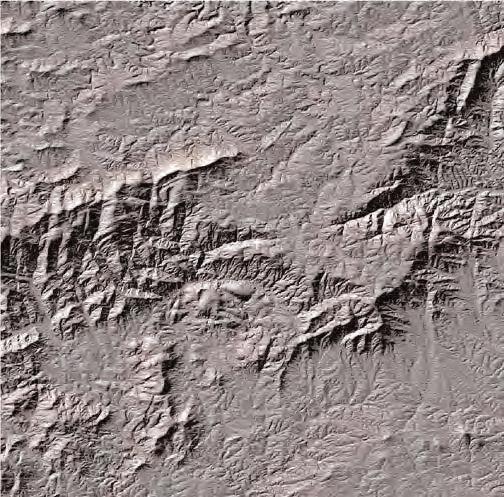
Environmental Assets:


Environmental Constraints:
Slopes,


Brownfields




The trail route was determined based on five major site suitability factors: public workshop comments; asset connectivity; relative parcel density; environmental assets; and environmental constraints. These factors, including segment manager capacity, are critical measures for evaluating the likelihood and feasibility for trail implementation. For each planning study section, these “feasibility factors” are evaluated to determine overall likelihood of success and are highlighted in the “Quick Facts” that begin each section description. The “feasibility factors” are explained in more detail below.
High Asset Connectivity. This factor measures the extent to which a potential trail route connects to any existing park, existing river access point, existing trail, existing or potential trailhead, or other natural/cultural assets.
To receive this designation, the trail section must contain two (2) or more assets for connectivity.
Relative Parcel Density. This ratio evaluates the number of parcels that the trail will need to cross in a particular planning section relative to the number of parcels that will need to be crossed in the entire study area. Since trail routes impacting fewer property owners are more feasible, this ratio serves as an important tool for determining the likelihood of success. A ratio or number less than 1 means that there are more landowners in a particular section relative to the trail as a whole. A ratio or number greater than 1 means there are fewer landowners in a particular section relative to the trail as a whole, which results in a “high relative parcel density” designation for those planning sections.
If thirty-four (34) parcels provide for (5) five miles of trail in a sub-section, the ratio is 0.14 (5/34). This ratio is then divided by the ratio of the overall trail (0.18), resulting in a relative parcel density of 0.78 (0.14/0.18). Because the relative parcel density of 0.78 is less than one (1), this means that there are more landowners in this particular section relative to the trail as a whole.
Favorable Environment. This factor considers the presence of floodplain areas or absence of steep slopes, railroad, or brownfield along a proposed trail route. The proposed trail type was considered when evaluating this factor.
Segment Manager Commitment. This factor considers whether or not an identified segment manager has taken responsibility for a section of trail.
Each planning sector begins with “quick facts” to highlight the major characteristics of the preferred trail route.
TRAIL TYPE: xx
SEgMENT MANAgER(S)/ DCg(S)*: xx
TOTAL LENgTh: xx miles
RELATIVE PARCEL DENSITY: xx
HIgH ASSeT ConneCTIvITY
HIgH RelATIve PARCel denSITY
FAvoRABle envIRonMenT
SegMenT MAnAgeR CoMMITMenT
STRong WeAKneUTRAl
*DCG - delegated Community group - Where a Segment Manager delegates responsibility to a community group through a Memorandum of Understanding (MoU). An example MOU is located in the appendix. DCG’s referred to in Quick Facts should be considered proposed, with the exception of a Wilkes County - evTA MoU.
Preliminary analysis maps, such as the The Yadkin River Section Analysis Map, served as a tool for collecting public workshop comments. These maps highlighted assets, parcel density, and environmental assets and constraints.
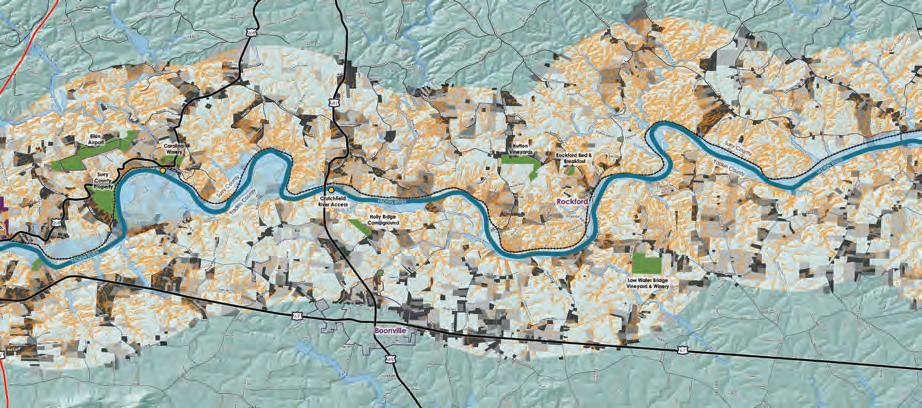
To determine the preferred trail route, the analysis maps along with public comments were analyzed in the field.
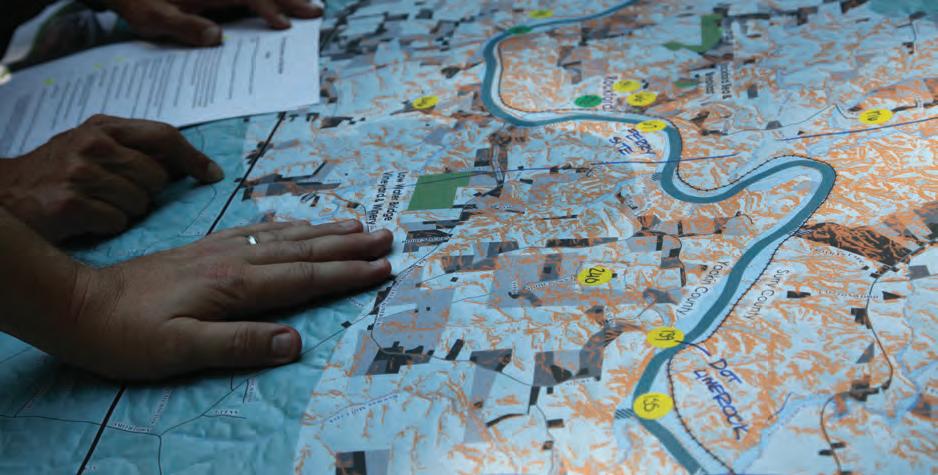
Each planning section description begins with the “Quick Facts”, includes a detailed map with a written analysis. Targeted trail users are identified for each sector, which, as noted in the previous chapter, has significant implications for trail easement acquisition and trail construction. Other discussion points include key opportunities for connectivity, barriers, and general feasibility.
Planning Section. A planning section is a distinct planning area within the larger plan. The Stone to Pilot Trail Master Plan has five (5) planning sections.
Planning Sub-section. Because of the large area covered within the Wells Knob and Yadkin River planning sections, these sections were further reduced to planning sub-sections.
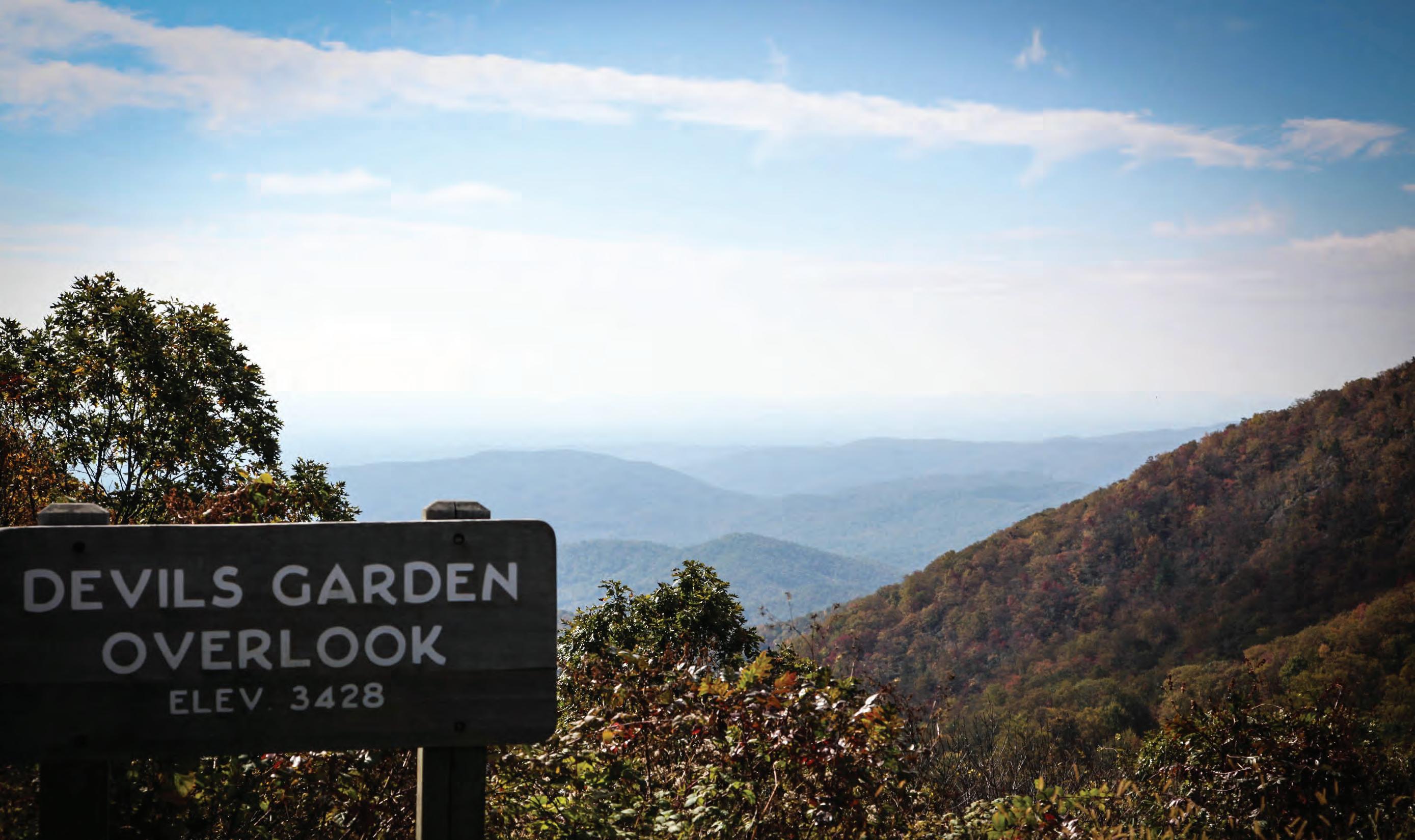
Quick facts:
(devils garden to Stone Mtn. Rd.)
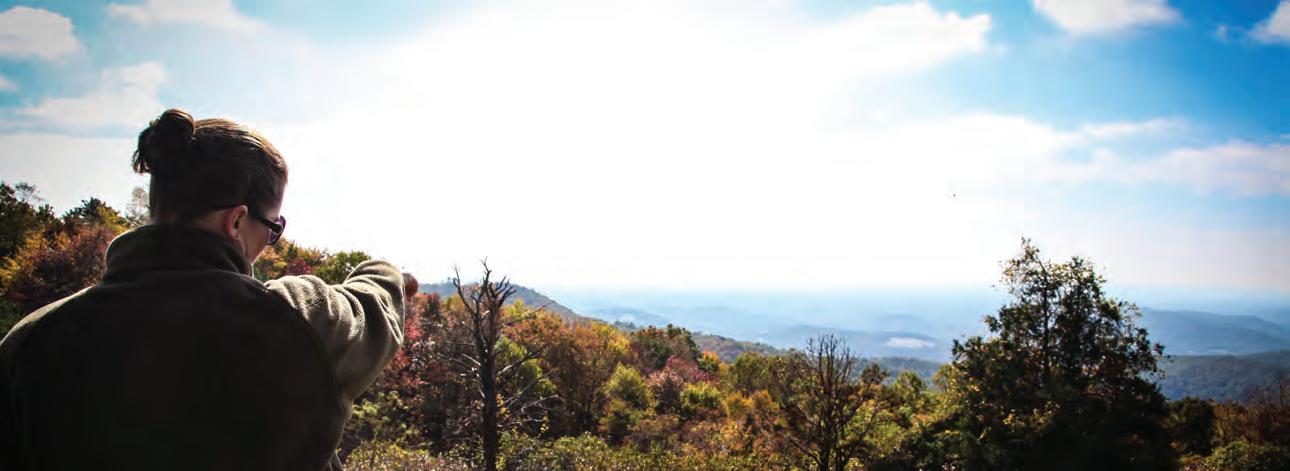
(Stone Mtn. Rd. to Traphill Rd. )
TRAIL TYPES: A & B (Transition @ Stone Mtn. Rd.)
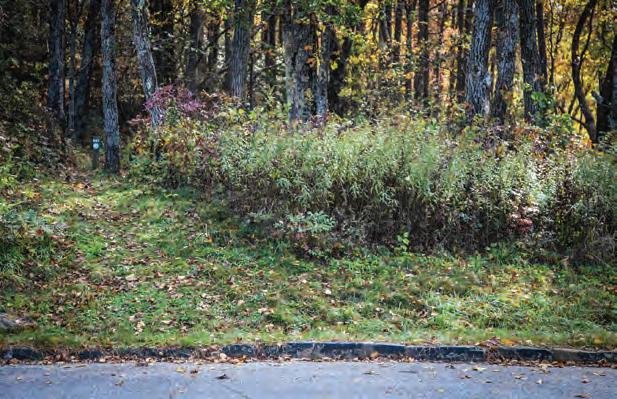
SEgMENT MANAgERS/ DCg*: nCdPR; Wilkes Co.; EVTA
TOTAL LENgTh: 10.7 Miles
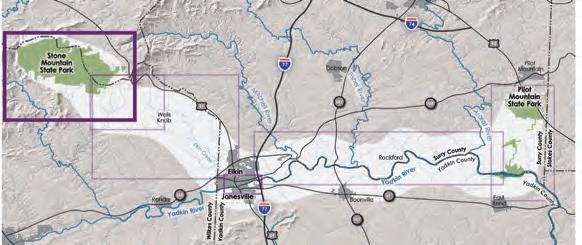
fEASIBILITY fACTORS:
HIgH ASSeT ConneCTIvITY
FAvoRABle envIRonMenT
SegMenT MAnAgeR CoMMITMenT
The Stone Mountain State Park Planning Sector begins in the jurisdiction of the National Park Service’s Blue Ridge Parkway. devils garden overlook, located at milepost 235.7 on the Blue Ridge Parkway, serves as the gateway of the MST to Stone Mountain State Park, which is managed by the North Carolina Division of Parks and Recreation. This gateway provides an opportunity to create a distinctive western entrance and exit for the Stone Mountain to Pilot Mountain State part section of the MST.
The MST entrance at Devils Garden Overlook provides an opportunity to create a distinctive gateway to the Stone to Pilot trail section.
*DCG- Delegated Community Group
The MST extends south through the heart of the state park, passing a primitive campground before accessing the Stone Mountain Road parking area. This section of trail is approximately 6.5 miles in length. From here, trail users must currently walk east along the Stone Mountain Road for 1.1 miles before reaching the lower Trailhead Parking area, which provides access to a host of State Park trails.
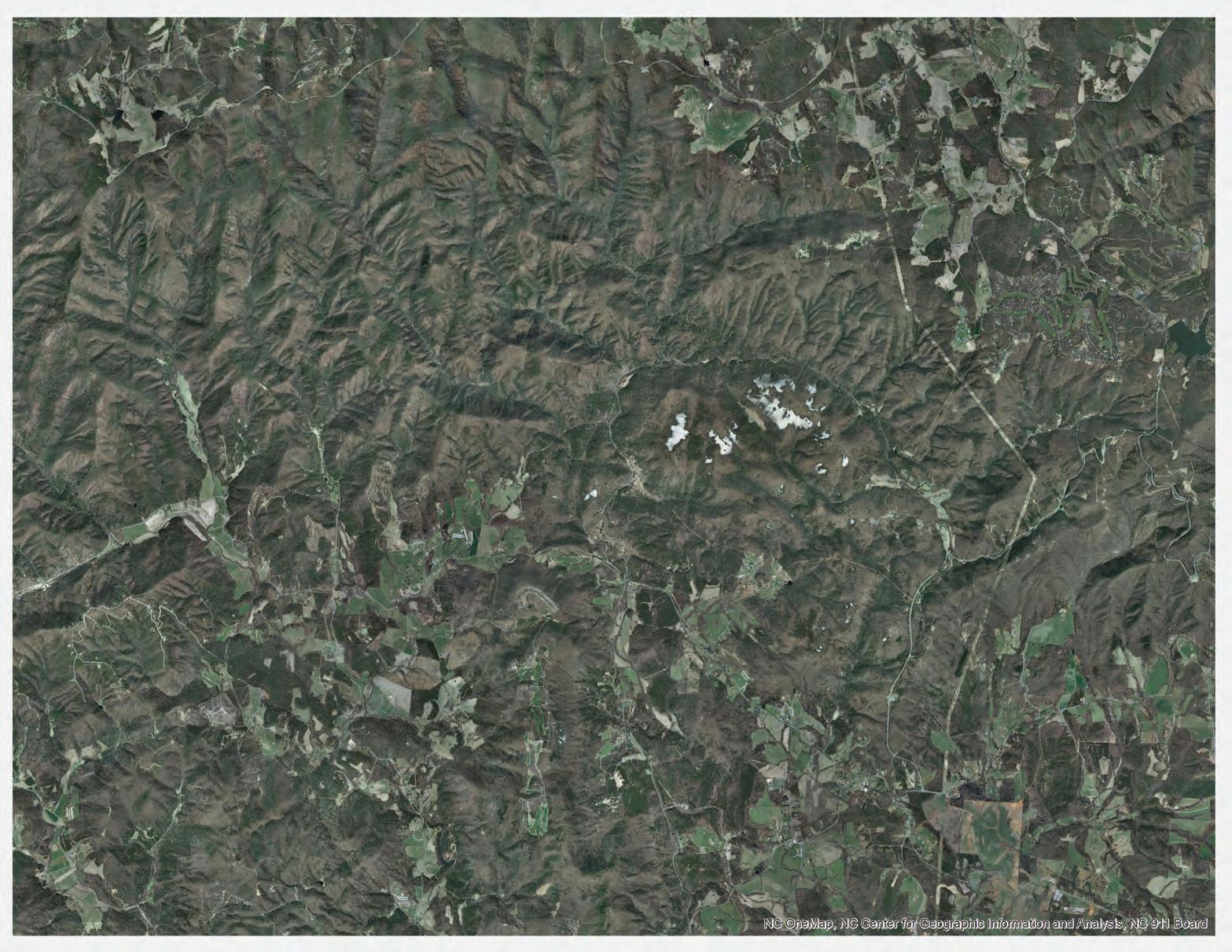
The recommended MST route utilizes the western portion of the Stone Mountain loop and the lower Falls Trail. From here, a new section of trail will need to be created linking the lower Falls Trail (along with the existing Bridle Trail to the west) to John P. Frank Parkway. At the intersection of lower Falls Trail and the Bridle Trail, the trail type transitions from hiking-only to hiking and equestrian.
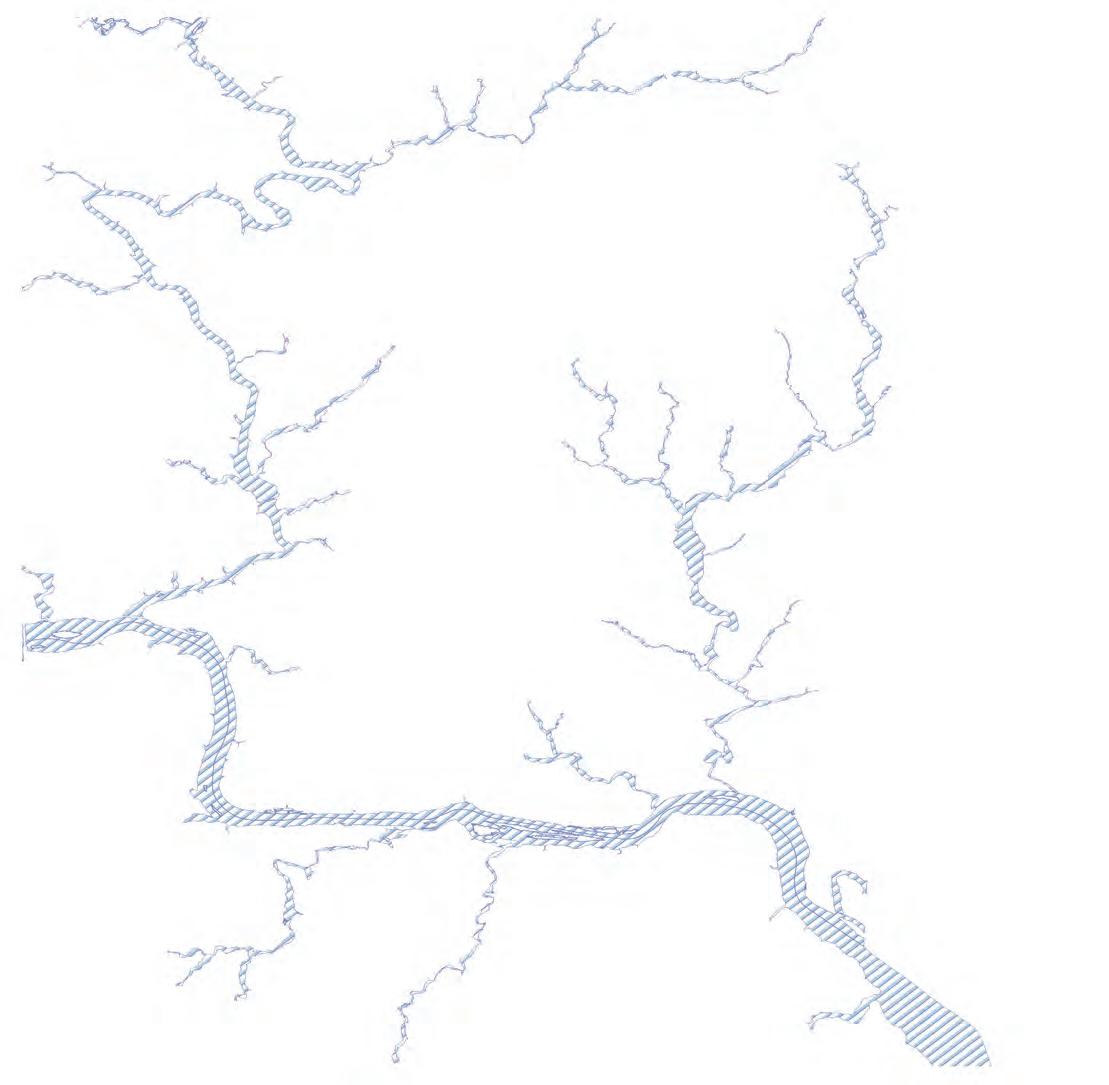
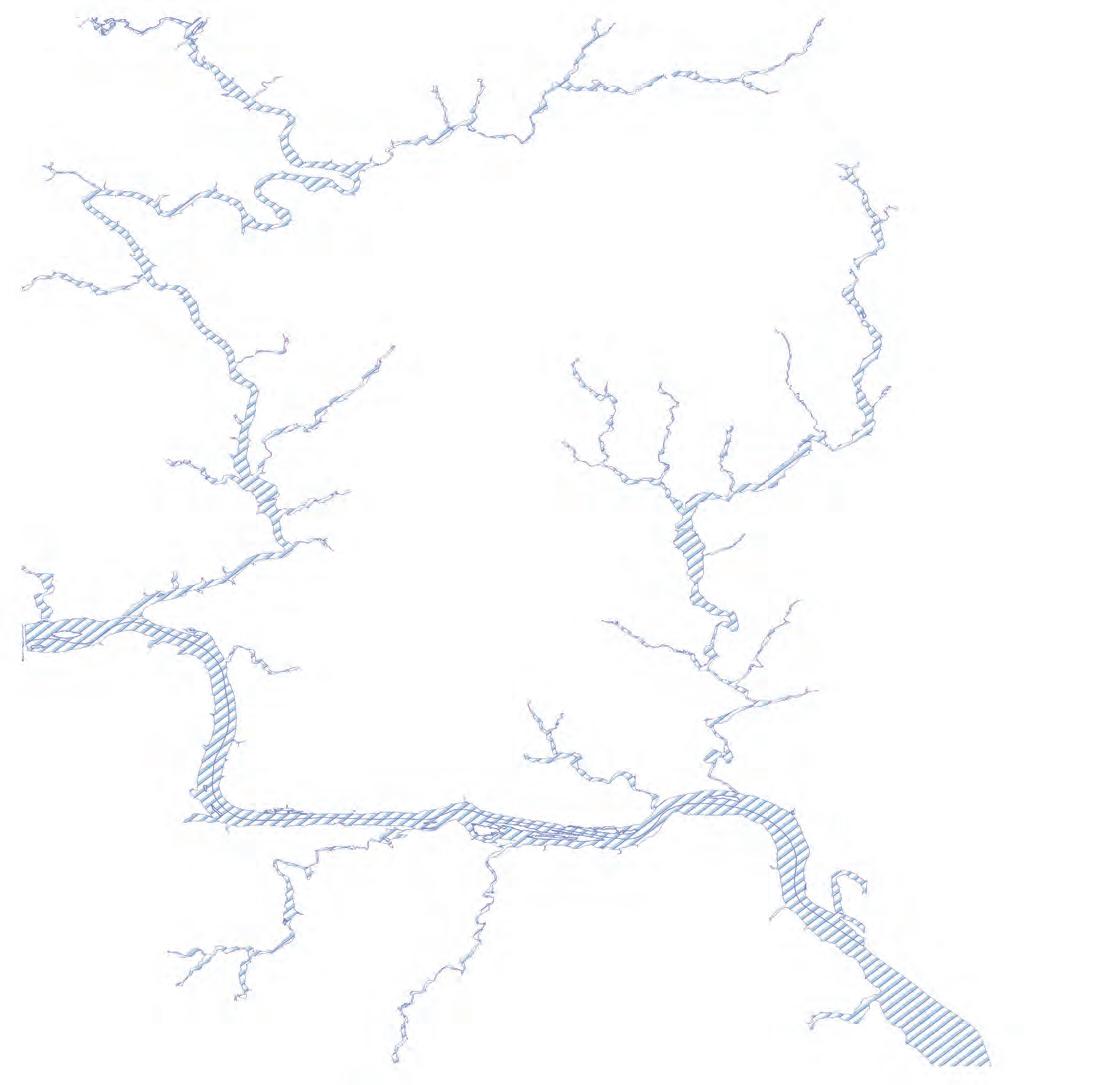


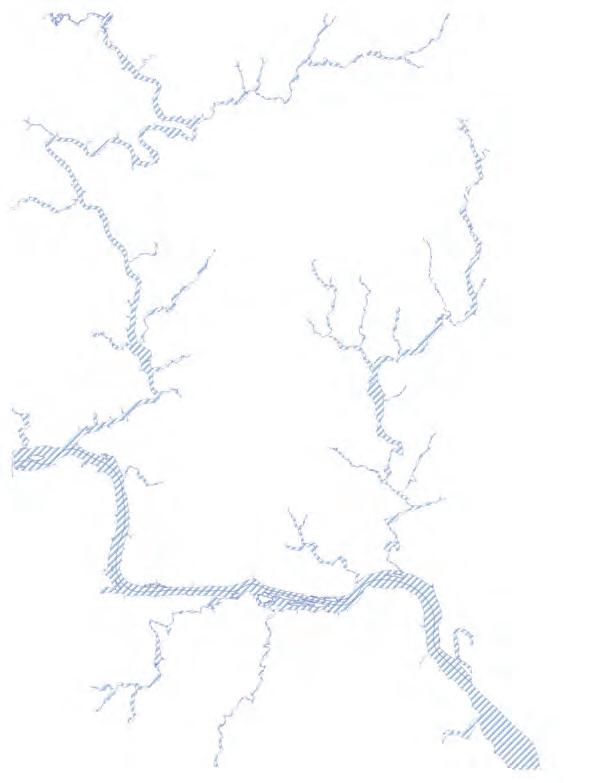




A formal trailhead will need to be created at the new trail intersection at John P. frank Parkway. This information kiosk will welcome new park visitors and inform those exiting that they are no longer within the State Park.
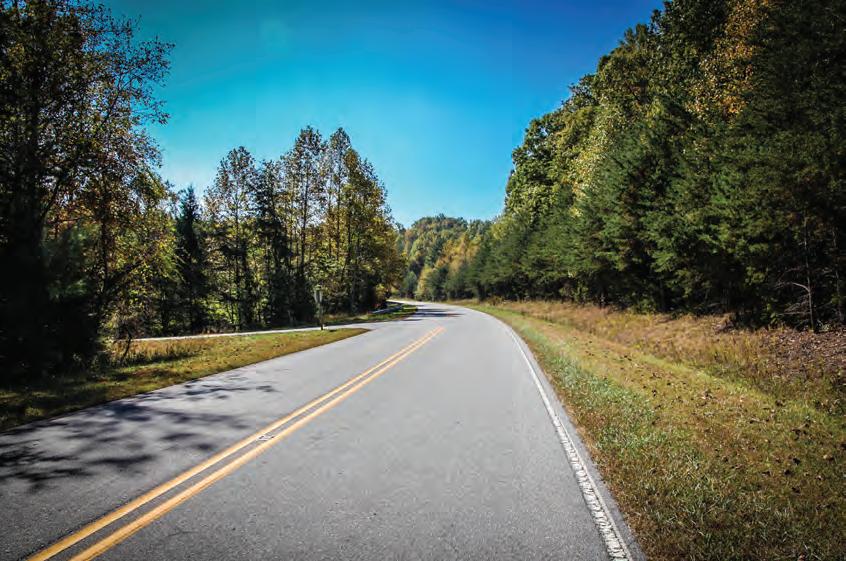
The Stone Mountain Loop trail is accessed from the Lower Trailhead Parking Area.
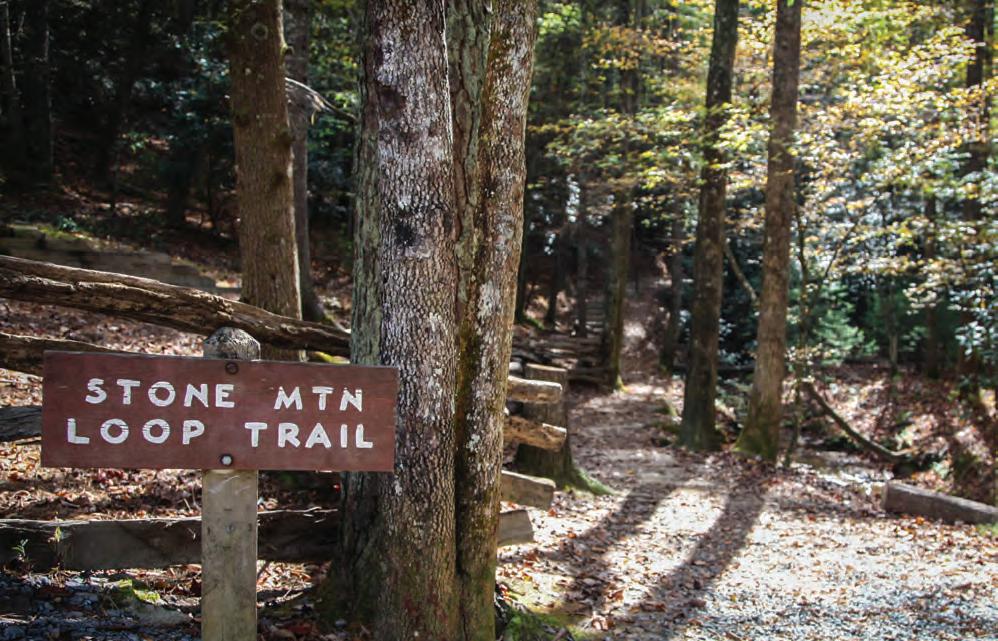
Signage and parking should be improved at the Stone Mountain Road trailhead.
1. Provide for hiking-only use from the Blue Ridge Parkway to the intersection of the lower Falls Trail, Bridle Trail, and proposed southern trail corridor.
2. Engage in a conversation with the National Park Service about improving signage related to the MST at Devil Garden Overlook.
3. Improve the parking area at Stone Mountain Road.
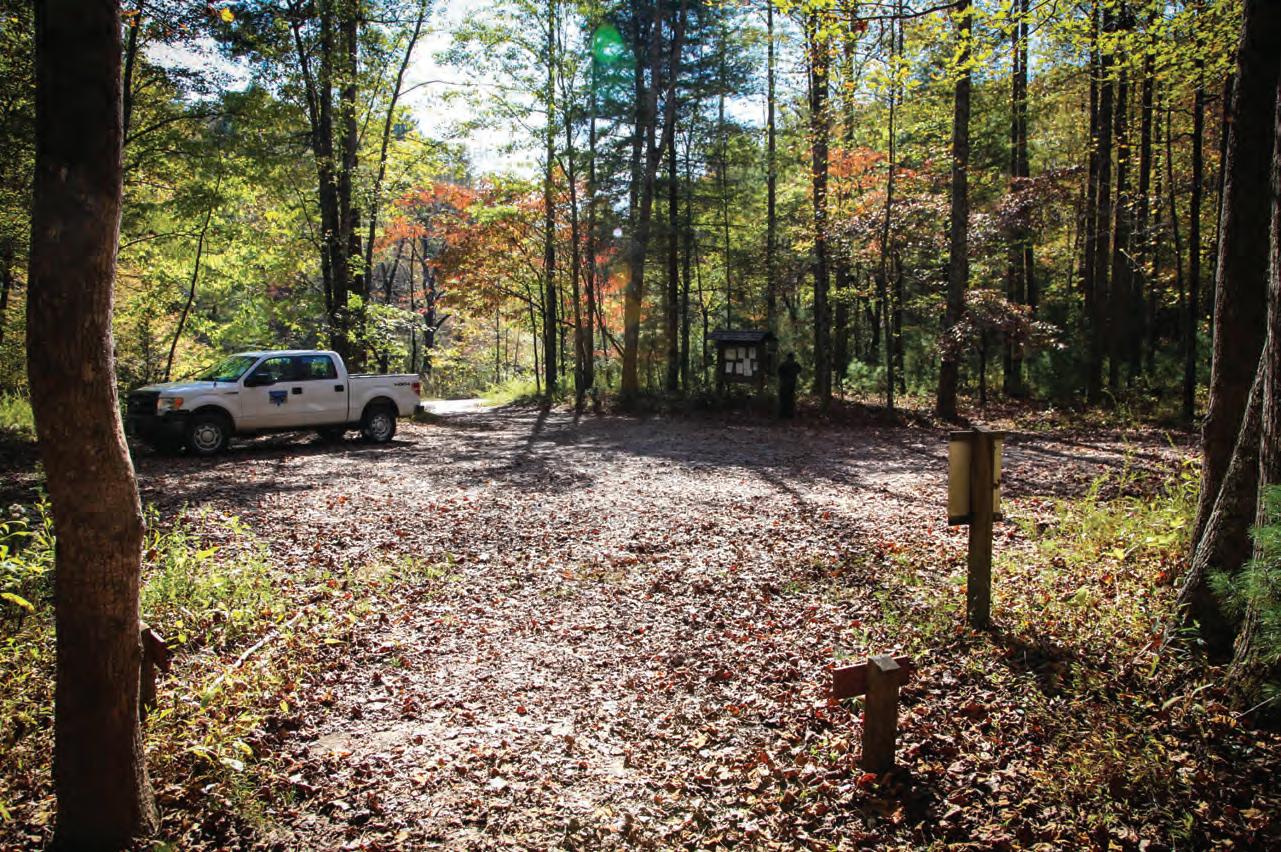
4. Conduct a detailed trail analysis to identify potential trail routes for removing hikers from Stone Mountain Road.
5. Construct a hiking and equestrian trail connecting the Bridle Trail to John P. Frank Parkway.
6. Construct a trailhead gateway at John P. Frank Parkway notifying users that they are entering/ exiting Stone Mountain State Park.
(Traphill Rd. to Carter Falls)
USER gROUP TARgET:
TRAIL TYPES:
SEgMENT
(Carter Falls to elkin Park)
The Wells Knob Sector extends approximately 16.8 miles from John P. Frank Parkway to the elkin Reservoir. This section is named after Wells Knob, a notable peak and natural resource asset situated near the geographic center of the planning section.
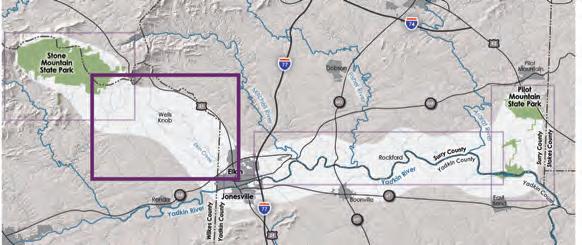
Because of its extensive length, this corridor is organized into three (3) planning sub-sections, including:
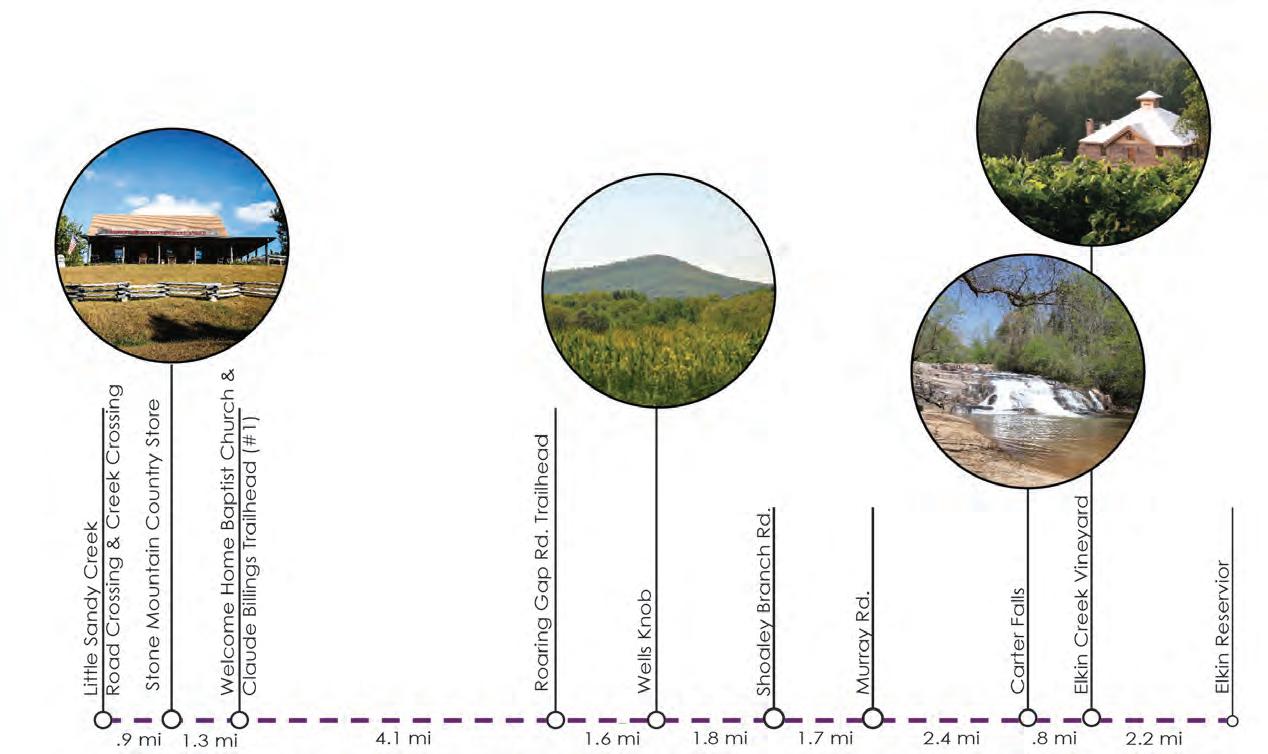
Sub-Section 2a: John P. Frank Parkway to Roaring gap Road
Sub-Section 2b: Roaring gap Road to Murray Road
Sub-Section 2c: Murray Road to elkin Reservoir
Elkin;
TOTAL LENgTh:
RELATIVE PARCEL
fEASIBILITY
HIgH
FAvoRABle
SegMenT
*DCG- Delegated Community Group

TRAIL TYPE: B
SEgMENT MANAgERS/ DCg*: Wilkes Co.; EVTA
TOTAL LENgTh: 6.3 Miles
RELATIVE PARCEL DENSITY: 0.69
fEASIBILITY fACTORS:
HIgH ASSeT ConneCTIvITY
HIgH RelATIve PARCel denSITY
FAvoRABle envIRonMenT
SegMenT MAnAgeR CoMMITMenT
*DCG- Delegated Community Group
EVTA continues to make considerable progress securing easements and constructing trail throughout this approximately 6.3 mile section.
Approximately 2.0 miles of trail are complete from John P Frank Parkway to Traphill Road. From the proposed trailhead gateway, which signifies the entrance and exit to Stone Mountain State Park, the trail utilizes Mosswood Road before paralleling John P Frank Parkway, connecting the Stone Mountain Country Store, and meandering southeast to Traphill Road and the future Claude Billings Trailhead.
From Traphill Road, a significant section of trail needs to be completed in order to provide connectivity to recently constructed trail in the Wells Knob area. The “potential trail corridor” noted on the map extends approximately 4.3 miles in length and highlights a corridor where large landholdings exist along with minimal environmental barriers. However, this route will still need to cross several roads, including Swaringen, Traphill Union, Willey Royal, and Roaring gap. There are also three (3) necessary stream crossings.
The trail will utilize Mosswood Road for approximately 0.7 miles.

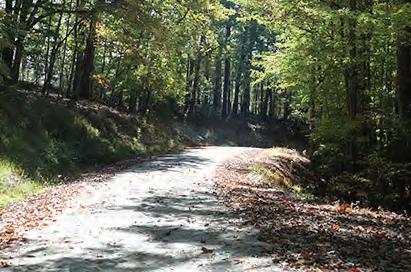
Stone Mountain Country Store will serve as an important restocking destination along the trail.
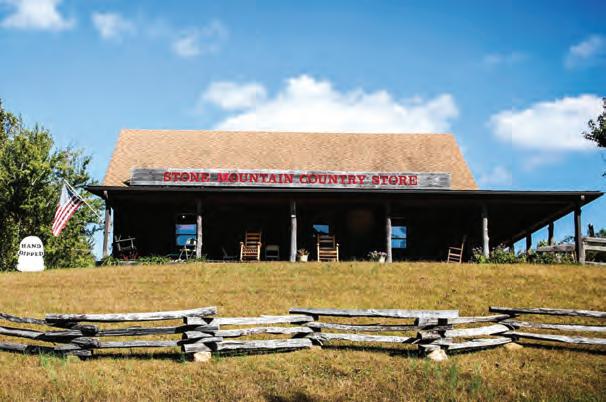








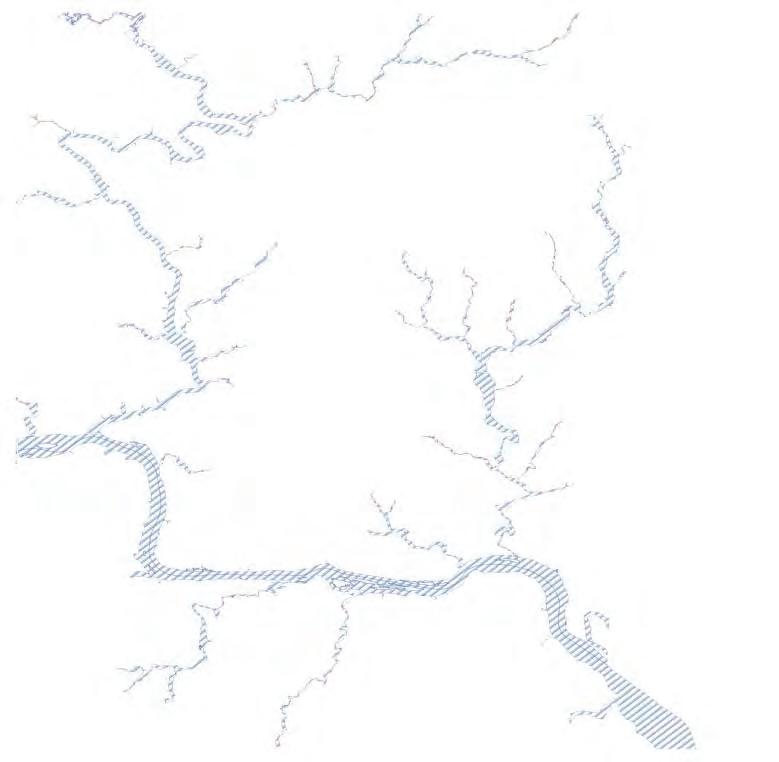
Quick facts:
TRAIL TYPE: B
SEgMENT MANAgERS/ DCg*: Wilkes Co.; EVTA
TOTAL LENgTh: 5.1 Miles
RELATIVE PARCEL DENSITY: 0.74
fEASIBILITY fACTORS:
HIgH ASSeT ConneCTIvITY
HIgH RelATIve PARCel denSITY
FAvoRABle envIRonMenT
SegMenT MAnAgeR CoMMITMenT
This sub-section from Roaring gap Road to Murray Road extends approximately 5.1 miles in length. At the center of the sub-section is Wells Knob, a significant geographic feature that serves as the highest point – 1,800 feet – between the Brushy Mountains and the Blue Ridge escarpment.
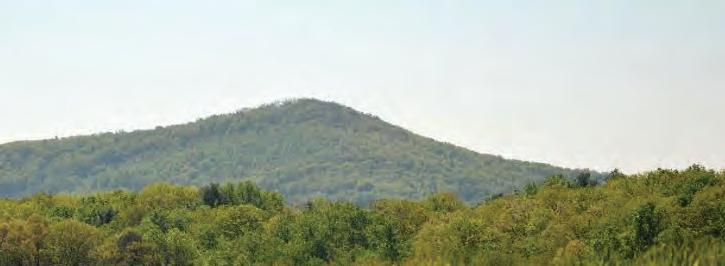
Several trail segments within this sub-section are now complete or under construction. In 2014, evTA completed a 0.9 mile section of trail from Roaring gap Road to Wells Knob Road. Also, the trail conveniently uses a portion of Shoaley Branch Road, a gravel road, for two-miles to connect directly to Murray Road.
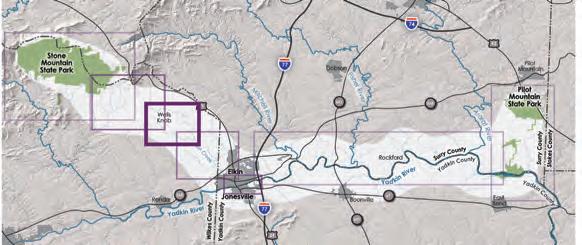
EVTA volunteers clearing a section of trail between Roaring Gap Road and Wells Knob Road.
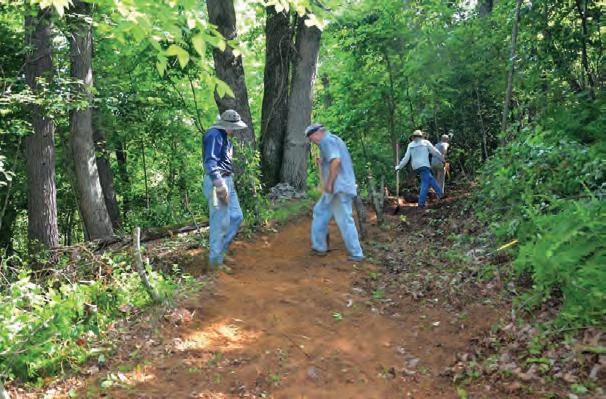
*DCG- Delegated Community Group
A 0.9 mile section of trail was recently completed at Wells Knob.
Provide for hiking and equestrian use throughout this planning sector.
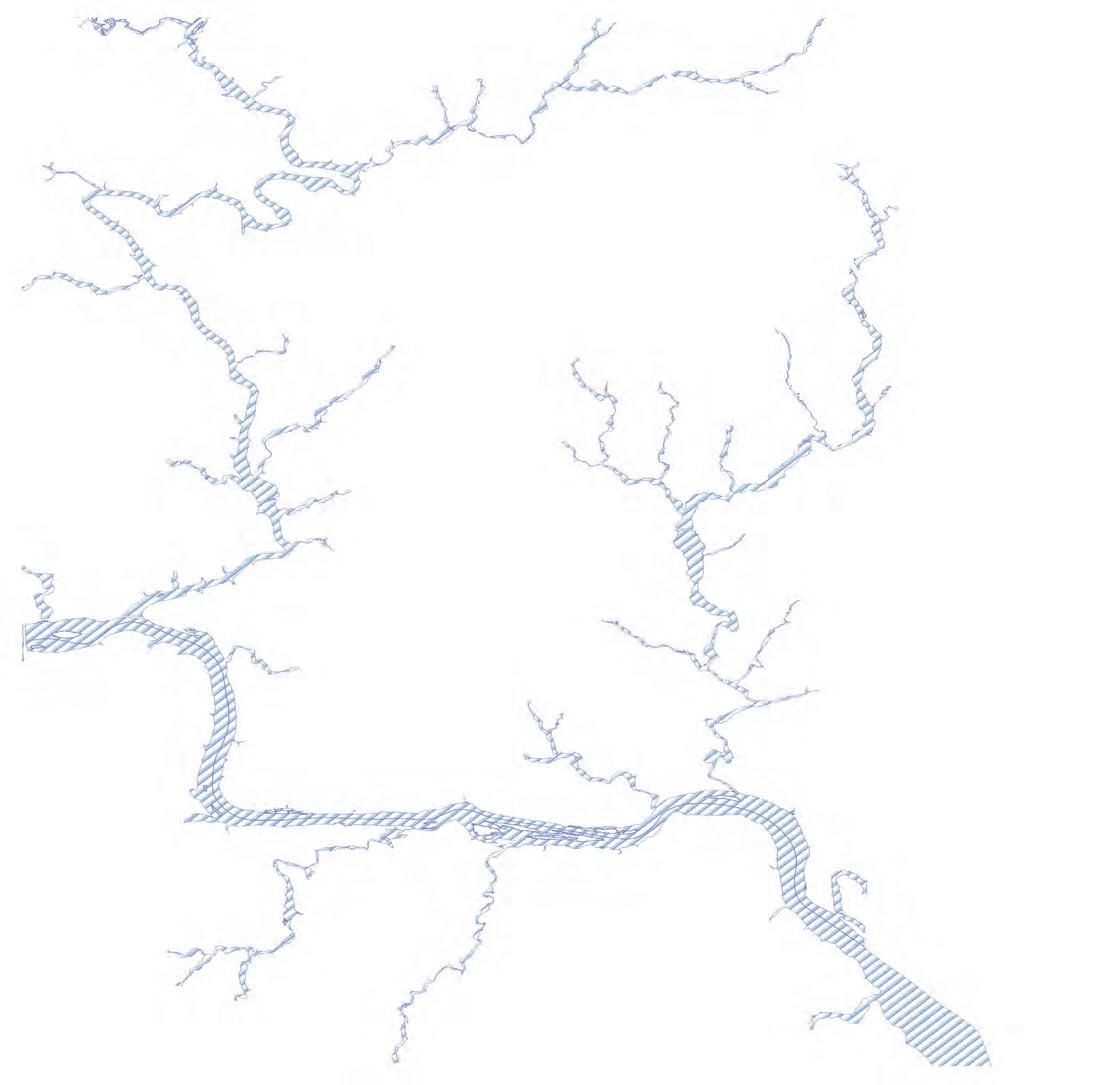



Explore a trail connector to rental cabins located east of Wells Knob.
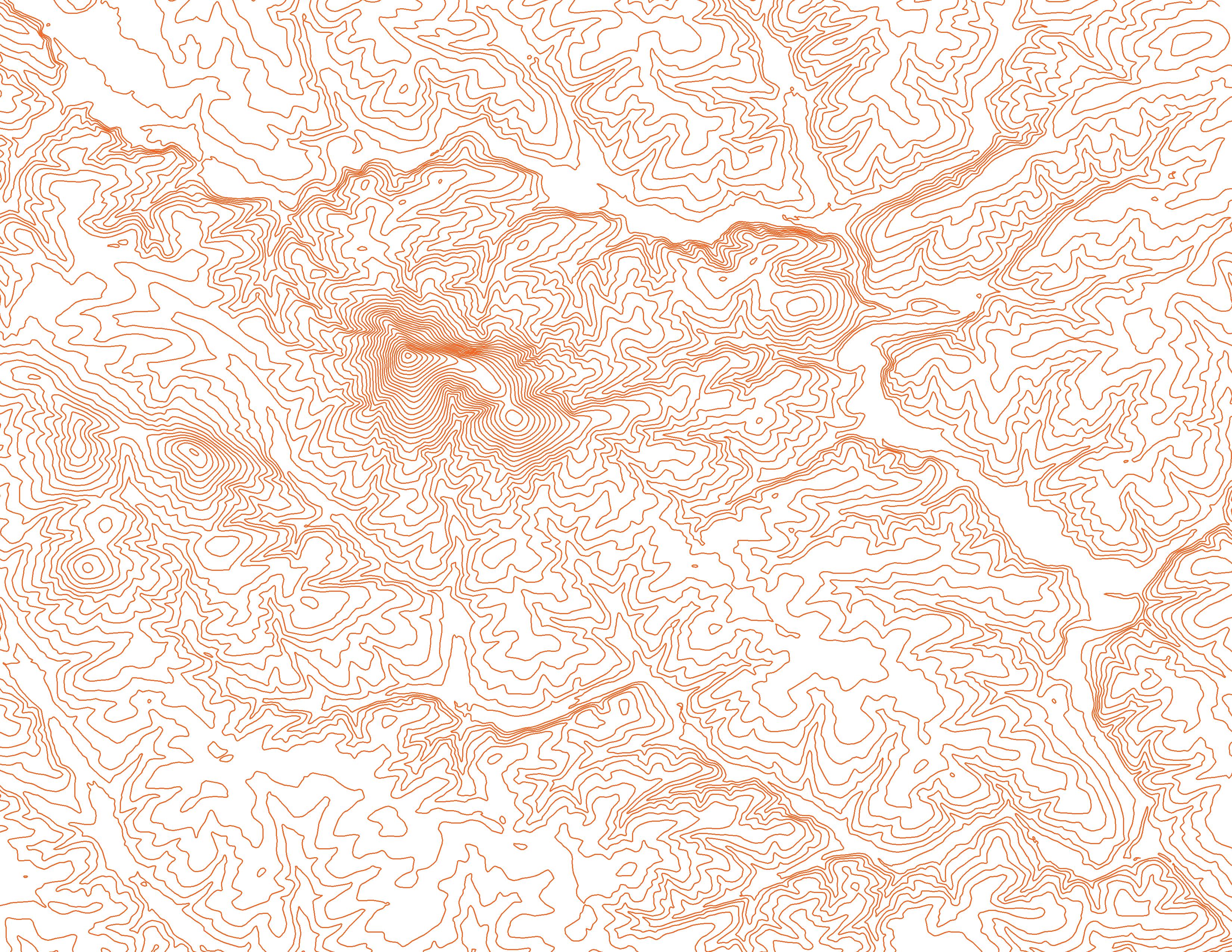
Work with planners to designate a hiking and equestrian path on Shoaley Branch Road.

e Shoaley Branch Road that would provide for a purpose-built trail away from vehicular traffic.
Create a designated vista and viewing area at Wells Knob, including educational signage about the viewshed and history of the area.
Quick facts:
Murray Rd. to Carter Falls)
USER gROUP TARgET:
(Carter Falls to elkin Park)
TRAIL TYPE: B & C (Transition @ Carter Falls)
SEgMENT MANAgERS/ DCg*: Wilkes Co.; Surry Co.; Elkin; EVTA
TOTAL LENgTh: 5.4 Miles
RELATIVE PARCEL DENSITY: 0.70
fEASIBILITY fACTORS:
HIgH ASSeT ConneCTIvITY
HIgH RelATIve PARCel denSITY
FAvoRABle envIRonMenT
SegMenT MAnAgeR CoMMITMenT
Section Study Area
*DCG- Delegated Community Group
The sub-section trail corridor extends approximately 5.4 miles, following elkin Creek, from Murray Road to the elkin Reservoir. From the north at Murray Road, the preferred primary route will parallel Elkin Creek and connect to Carter Falls where it’s recommended that the hiking and equestrian shared-use trail end. South of Carter Falls should transition to a multi-use greenway in preparation for entering the Town of Elkin’s municipal jurisdiction.
The area south of Carter Falls contains numerous assets and potential route options, each of which would provide an enjoyable user experience. The MST should continue along Elkin Creek connecting the Elkin Creek Vineyard and the existing multi-use trail
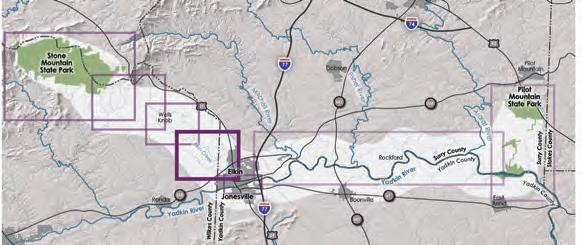
EVTA’s work includes this Highway 268 trail underpass.
EVTA members were out to capture the bridge construction over Elkin Creek.
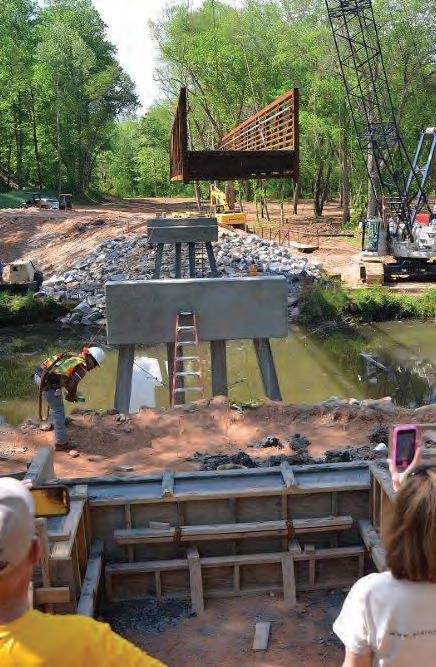
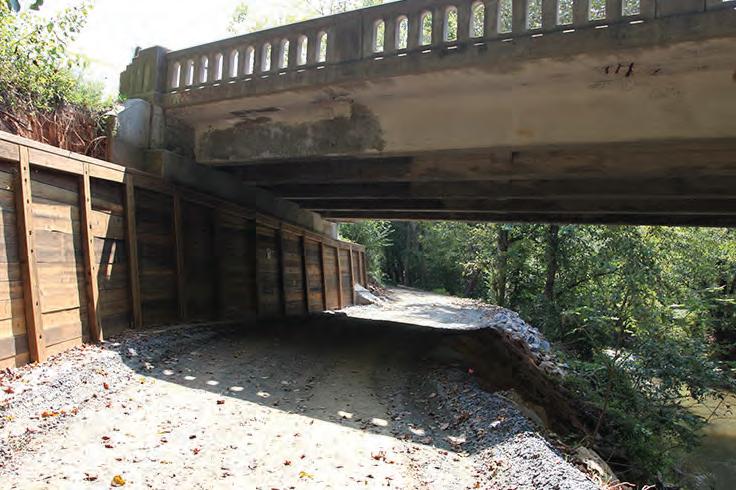
north of Elkin City Park. However, EVTA has already constructed a trail section near Grassy Creek Vineyards, creating a connectivity point for future trail development along Grassy Creek. Also, there is an opportunity to create a link from Grassy Creek Vineyard to Carter Falls creating a loop among these two assets and Elkin Creek Vineyard.
There are two land holdings within this sub-section that provide an opportunity for single-track purpose-built mountain biking trail. The “Pond loop” at the elkin Reservoir could serve as a beginner trail system, while the “Works loop” at the Elkin Center could provide a more advanced biking experience.





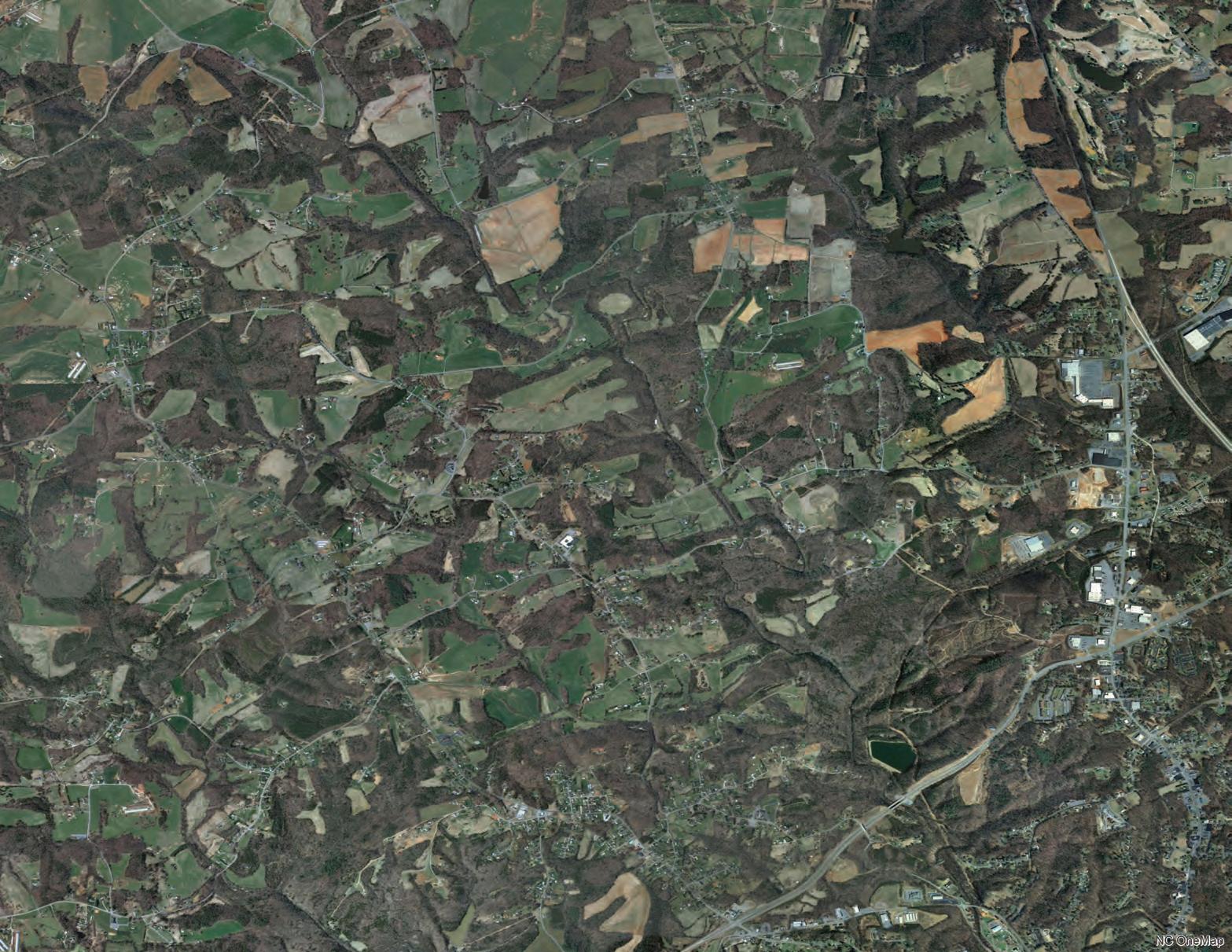
Five (5) trailheads should be explored within this area, including Carter Falls, elkin Creek vineyards, grassy Creek vineyards, elkin Public Works property, and the Surry Center.
Elkin Creek is navigable south of Elkin Creek Vineyard. Efforts should be made to formalize this paddle trail.
photo by others
Elkin Creek Vineyards is located at the confluence of Grassy Creek and Elkin River.
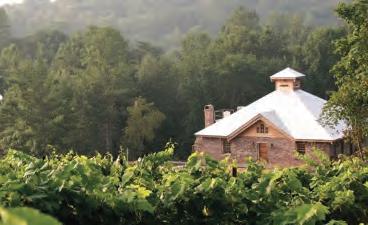
1. This area is prime for incorporating thematic trailheads, information kiosks, and other trail support facilities.
2. Create trailheads at the five (5) locations noted; the Carter Falls access must accommodate equestrian users.
3. Create a public river access area near elkin Creek Vineyards to formalize the Elkin Creek Paddle Trail.
4. As the trail is fully developed, monitor trail use and its effect on patronage to the two vineyards.
5. obtain expert advice for single-track mountain biking trail development.
6. Ensure that the two mountain biking areas are planned in concert, providing “progression” from one park to the other; the Pond loop should be beginner friendly, while the Works loop should provide more advanced options.
7. Consider providing naming rights for the “Pond loop” and the “Works loop” to raise money for the EVTA efforts.
Grassy Creek Vineyard has an existing 1.1 mile trail.
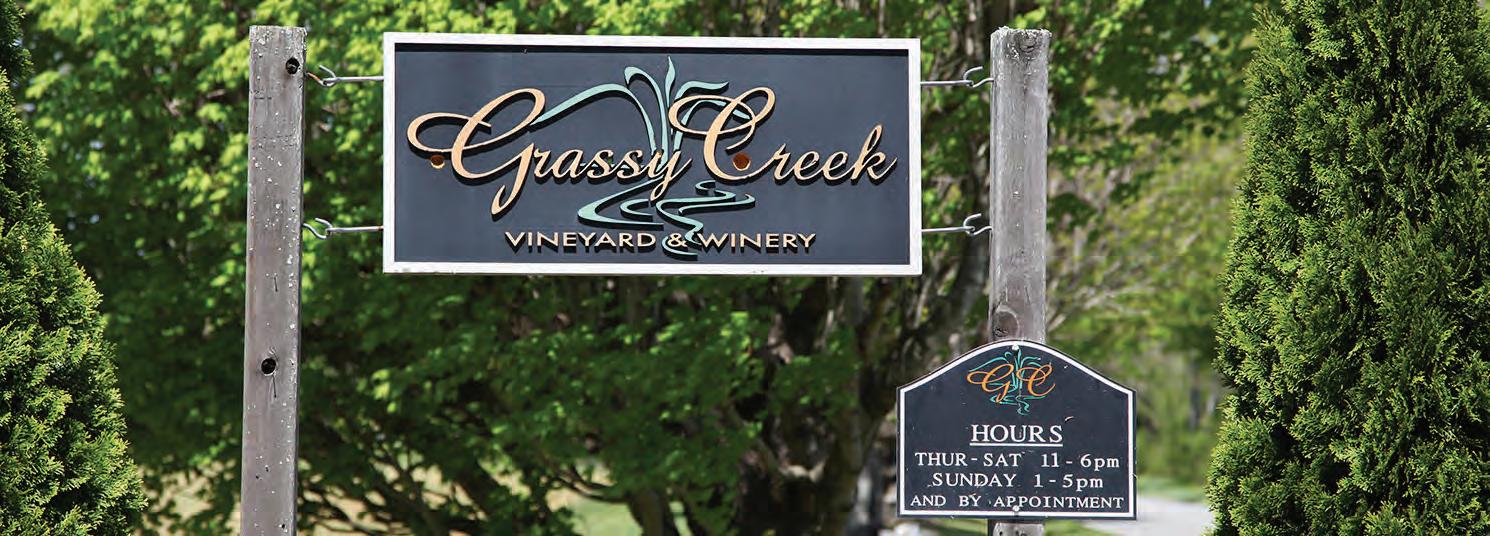
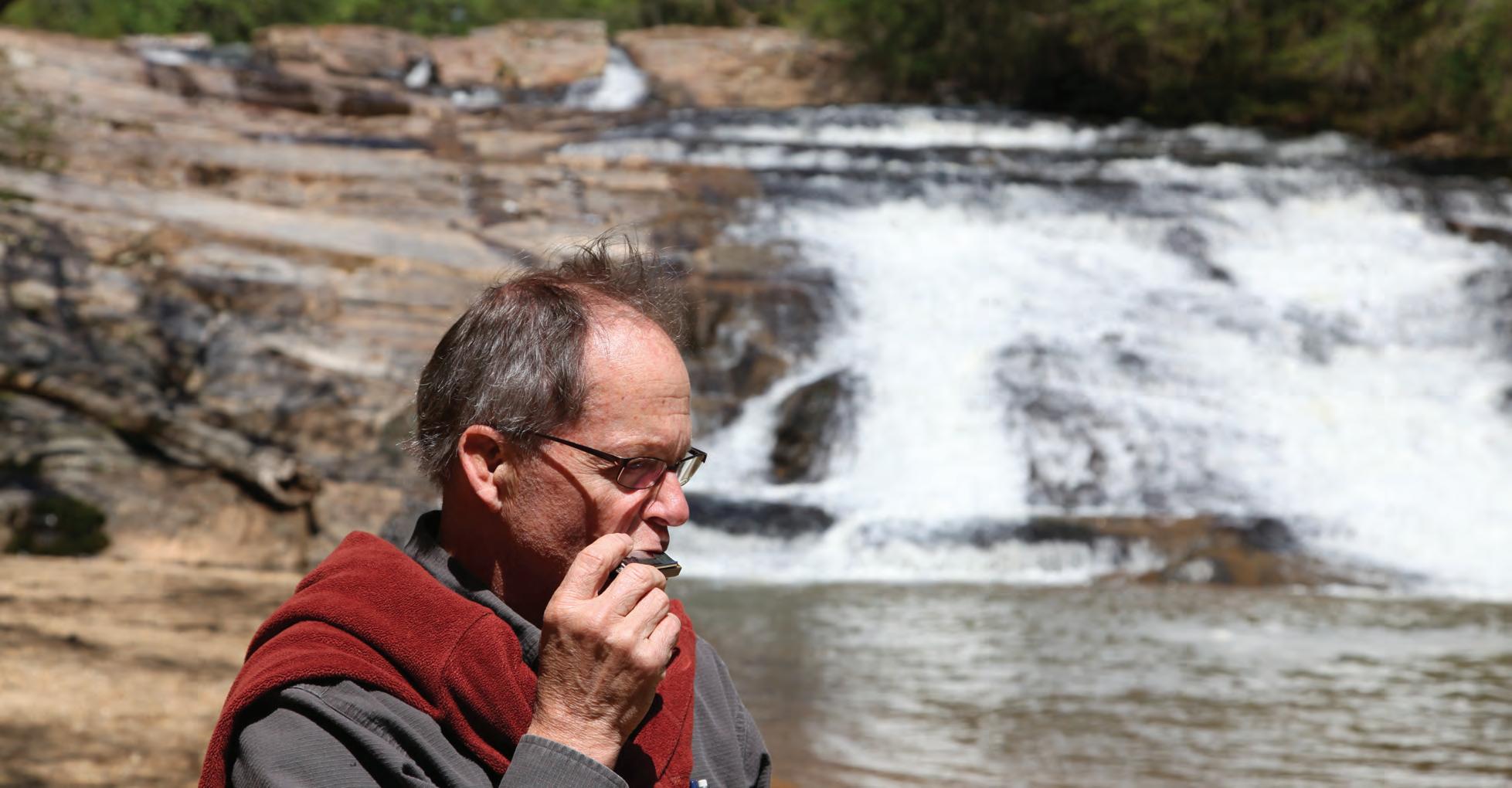
TRAIL TYPE: C
TOTAL LENgTh: 3.8 Miles
FAvoRABle envIRonMenT
The Trail Towns section extends approximately 3.8 miles from Elkin Municipal Park to “Interstate Park,” which is a working name for a 11.3 acre tract owned by the Town of elkin and located just east of I-77.
Trail currently exists in this section from Elkin Municipal Park to the operational railroad near the Yadkin River. From this location, the preferred trail route would bridge elkin Creek and link (spur) to the proposed Heritage and Trail Center. The Center would mark a significant transition for trail users, as they move from a predominantly rural setting into an urban core shared by two towns.
The communities of elkin and Jonesville are linked together by a shared history and the Yadkin River. Each town has been actively involved in planning efforts to convert their respective riverfront areas into recreational spaces that will compliment the river’s natural assets. The marriage of trails and towns is further strengthened here by the presence of the Yadkin River State Paddle Trail, which offers a series of formal river access areas downstream.
{The construction of a trail along both sides of the Yadkin River would result in the creation of a unique loop for trail users; such a loop is preferable and has broad public support.

The bridge at Highway 21 currently has five lanes, but could be redesigned to accommodate nonvehicular traffic, including the MST. This option is particularly compelling because the Town of Jonesville has secured a series of easements within their jurisdiction and south along the Yadkin River. Furthermore, there are multiple brownfield sites near Chatham Park in Elkin that could present challenges to trail development on the Elkin/Surry side of the river. Nevertheless, the construction of a trail along both sides of the Yadkin River would result in the creation of a unique loop for trail users; such a loop is preferable and has broad public support.
Because of the unique urban setting of this planning section, special design consideration is provided in subsequent pages for the following:
- Trail Towns Bridge Gateway
*DCG- Delegated Community Group
The MST’s route within these two towns must build upon a shared history and mutual hard work. Jonesville has developed open space, trails, and playground areas at its riverfront park, while Elkin has worked to use trails to connect its downtown retail center to its park and riverfront areas. Trail connectivity is critical among these two towns.
- Heritage and Trail Center
- Jonesville visitor Center
- Highway 21 Pedestrian Bridge
- Jonesville Riverside Park
- Jonesville easements and elkin Interstate Park Connector





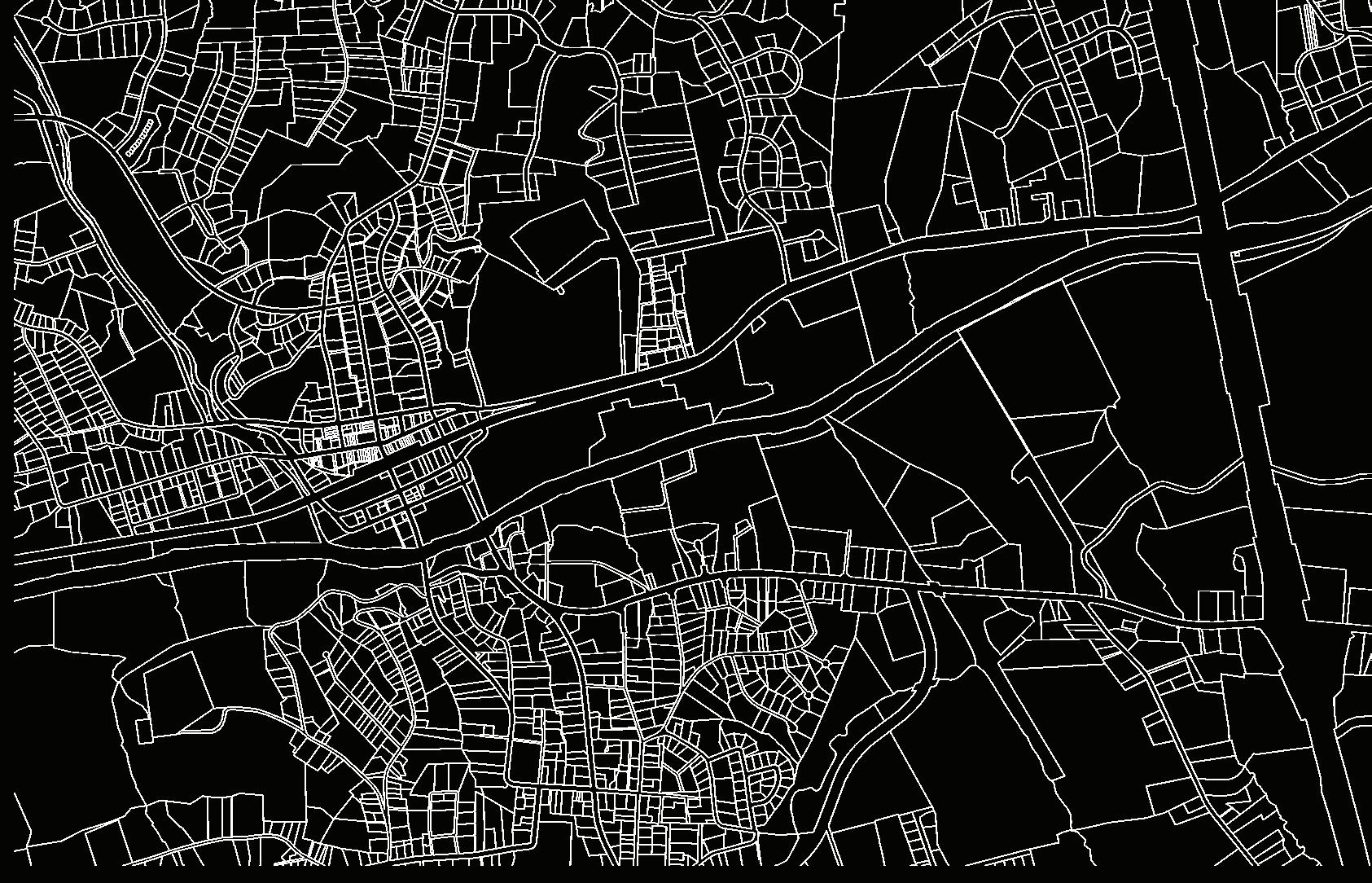








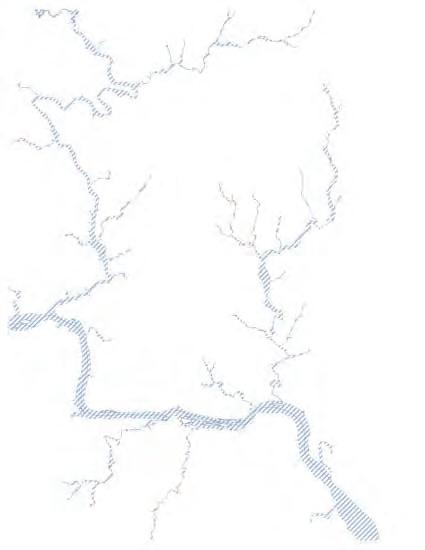


The bridge crossing over Elkin Creek will serve as a gateway into the Trail Towns Section and future Heritage and Trail Center. A trestle style bridge in this location would celebrate the region’s identity and sense of place. To the extent possible, such unique trail features should be incorporated throughout the trail when opportunities exist.
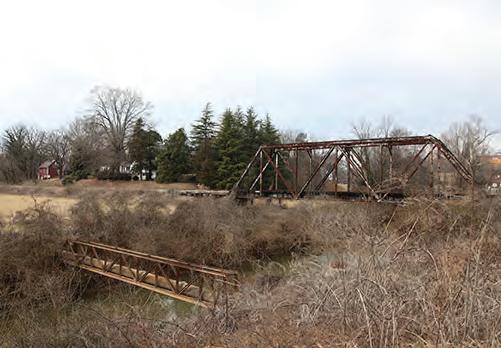
A major asset within this section is the future Heritage and Trail Center which will serve as a trail junction for the Mountains-to-Sea State Trail, Overmountain Victory national Historic Trail, Yadkin River Heritage Corridor, e and A Rail Trail, Yadkin River Paddle Trail, elkin History Walk, and the elkin literary Walk.
The rendering above was produced during the Smith-Phillips Design Workshop.


The existing Jonesville visitor Center will serve as an important MST trailhead and will provide easy access for trail users.
The Jonesville Visitor Center will serve as a major trailhead for the MST.
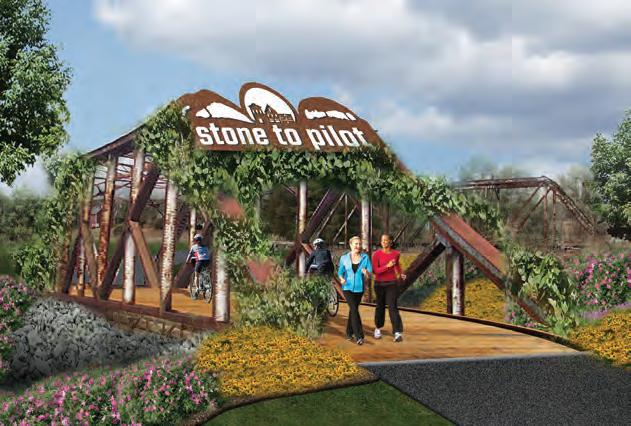

 photo by others
photo by others
By repurposing the existing Highway 21 bridge, nonvehicular traffic can be accommodated and the MST can serve as a profound connection between the two towns. This proposal not only addresses the practical challenge of crossing the Yadkin River, but also acts as a bold symbol - one that unites Elkin and Jonesville as destination-quality trail towns.
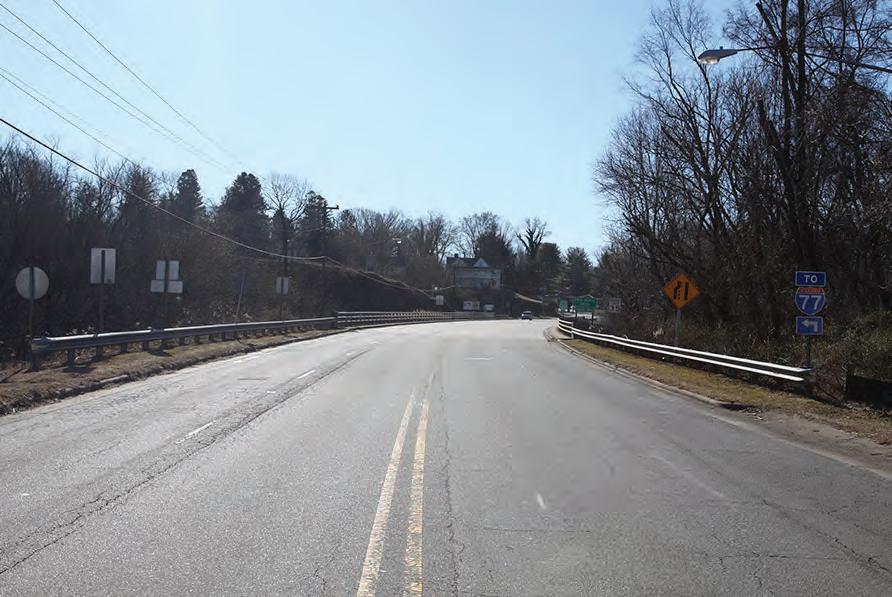


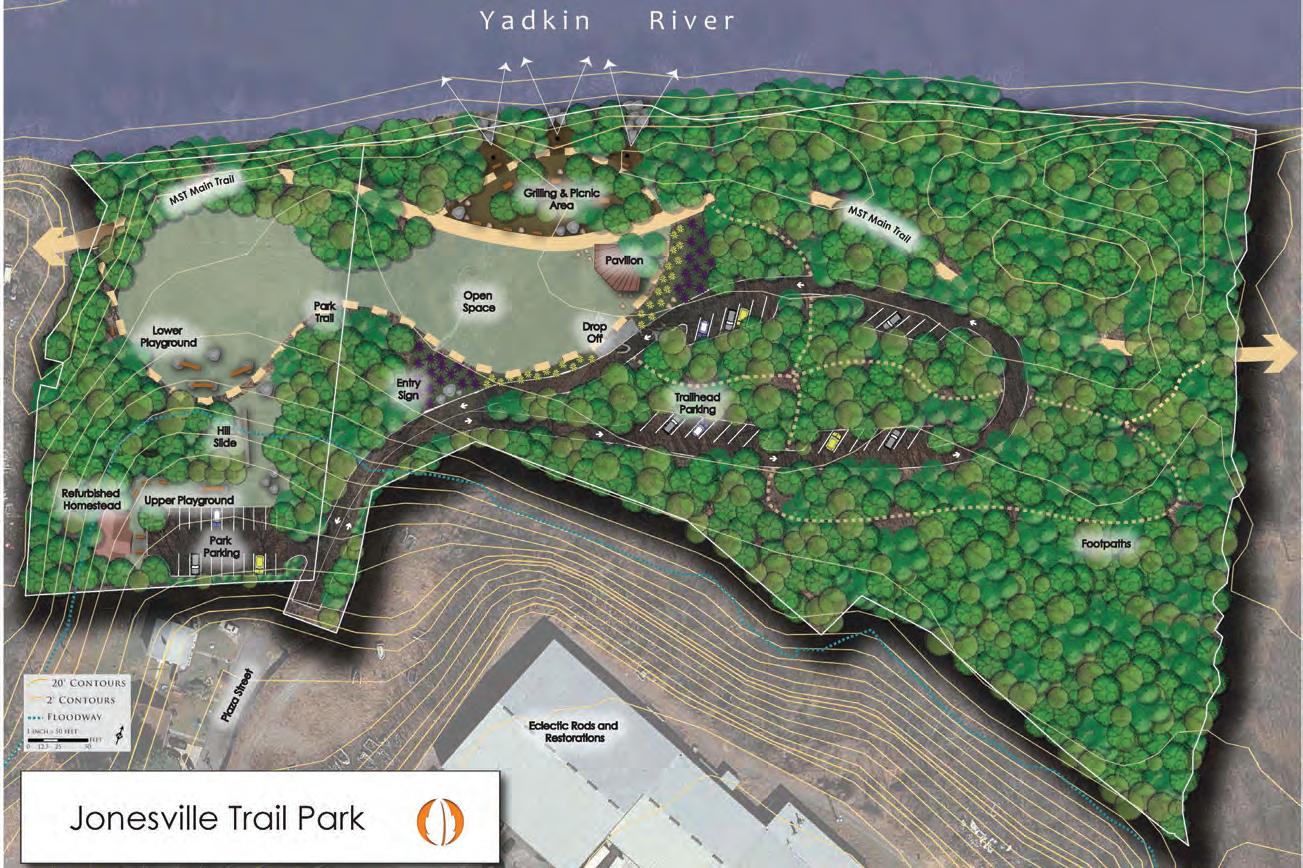
The Town of Jonesville currently possesses nearly two (2) miles of trail easements along the Yadkin River. The western terminus of these easements is anchored by a town-owned 10.5 acre tract, which provides a unique opportunity for a riverside park and a major MST trailhead.
Jonesville owns an undeveloped 10.5 acre tract adjacent to the Yadkin River.

The Town of Jonesville’s easements extend just beyond Interstate 77. However, pending steep slopes on the south side of the Yadkin River will require bridging the Yadkin River near the I-77 bridge to connect to a 11.3 acre tract (Interstate Park) owned by the Town of Elkin.
A suspension bridge utilizing the I-77 bridge foundation, such as the one constructed in Richmond, va, could provide a unique solution for bridging the Yadkin River.
Interstate Park will serve as a major trailhead and community park.
1. Design and construct trails to the multi-use greenway standard to ensure access to a broad range of users, creating the greatest economic impact possible.
2. Approach NCDOT about redesigning the Highway 21 bridge so that two lanes are converted for non-vehicular traffic use and serve as a part of the official MST.

3. Work with nCdoT to explore the best options for spanning the Yadkin River near I-77.

4. Incorporate the regionally adopted wayfinding and signage plan (see chapter
The Pedestrian Bridge at the James River visitor Center in Big Island, vA is supported by a Blue Ridge Parkway motor bridge foundation. A similar idea was proposed at the public workshop. Although an engineering study is needed to determine the feasibility of such a bridge, this concept could provide the vital connector for the trail towns loop.
4) into the existing and proposed Trail Towns section’s trails and parks.
5. Jonesville should develop a long-range plan than helps to establish a defined town center and main street to better accommodate trail users and other visitors.
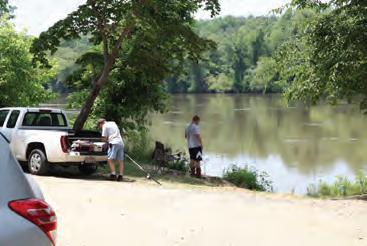
USER gROUP TARgET:
Surry Co.; Yadkin Co.; elkin; Jonesville, Boonville; evTA; Rockford Preservation Society; Sauratown Trails Association
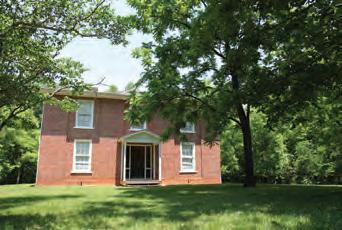

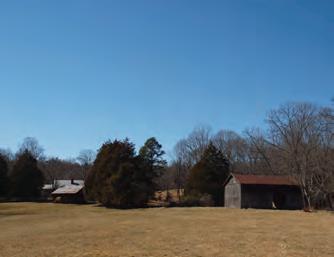
The Yadkin River Section extends approximately 25.7miles from I-77 to Shoals River Access. This section is named after the Yadkin River, a natural resource asset that serves as the backbone of the planning section.
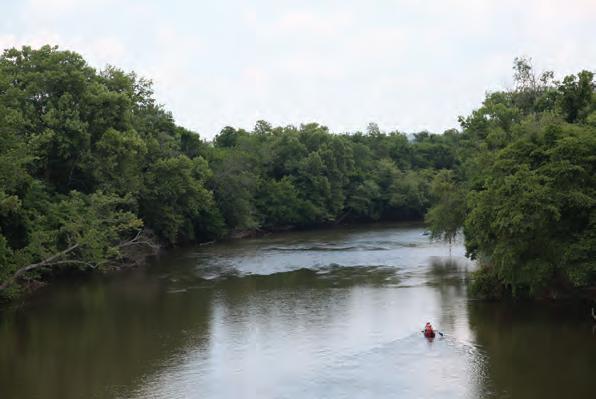
Because of its extensive length, this corridor is organized into six (6) planning sub-sections, including:
Sub-Section 4A: Interstate Park to Riverview ln.
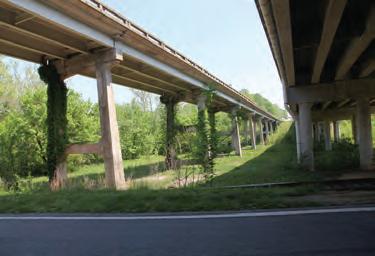
Sub-Section 4B: Riverview ln. to Surry County Property
Sub-Section 4C: Surry County Property to Shores Access
Sub-Section 4D: Shores Access to Rockford
Sub-Section 4E: Rockford to Siloam Rd.
Sub-Section 4f: Siloam Rd. to Shoals River Access
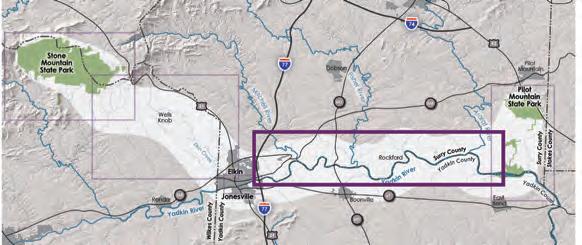
TOTAL LENgTh:
RELATIVE PARCEL DENSITY:
fEASIBILITY fACTORS:
HIgH ASSeT ConneCTIvITY
HIgH RelATIve PARCel denSITY
FAvoRABle envIRonMenT
SegMenT MAnAgeR CoMMITMenT
*DCG- Delegated Community Group
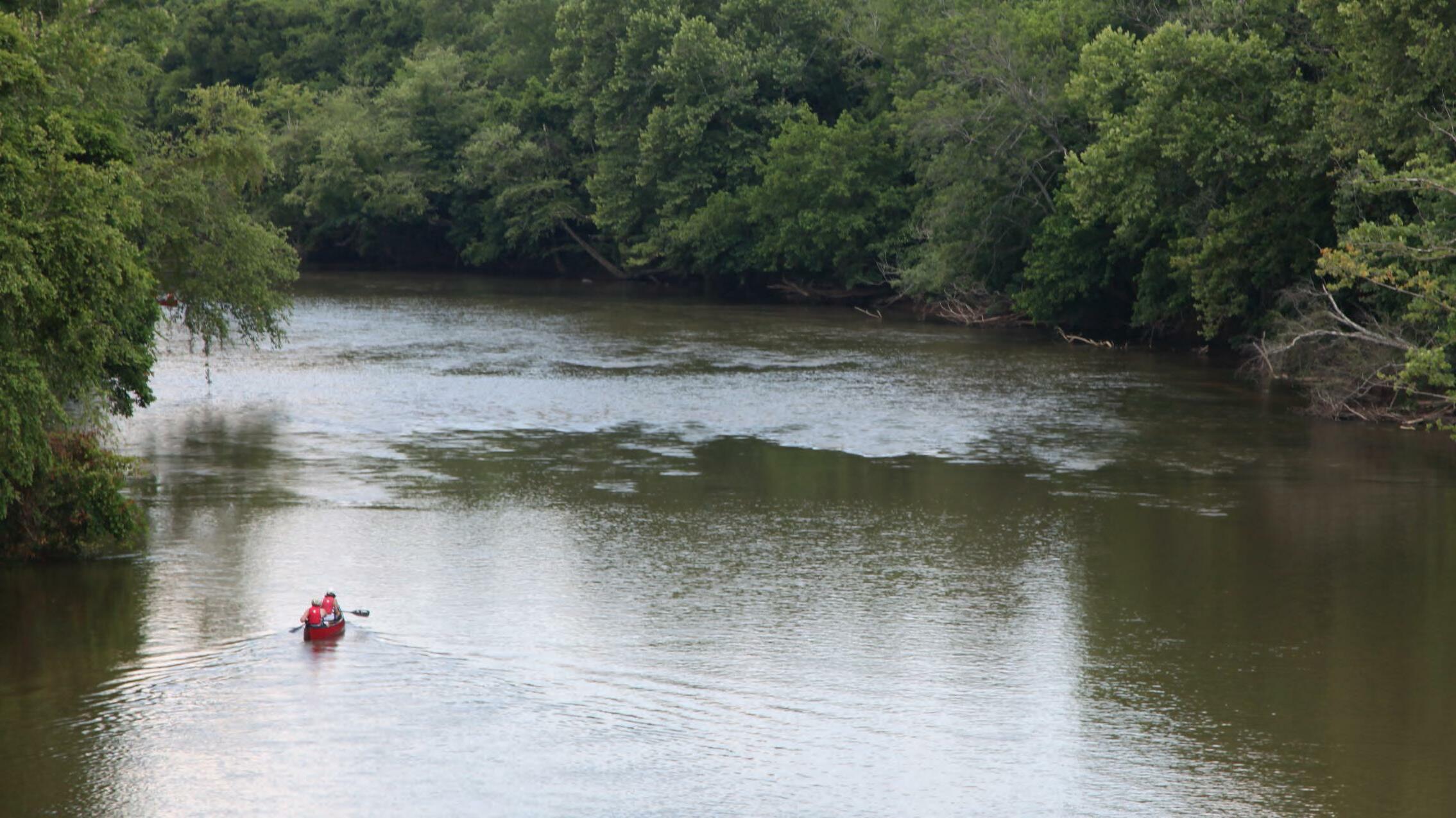
Quick facts:
USER gROUP TARgET:
TRAIL TYPE: C
SEgMENT MANAgERS/ DCg*: Surry Co.; Elkin; EVTA
TOTAL LENgTh: 1.0 Miles
RELATIVE PARCEL DENSITY: 0.56
fEASIBILITY fACTORS:
HIgH ASSeT ConneCTIvITY
HIgH RelATIve PARCel denSITY
FAvoRABle envIRonMenT
SegMenT MAnAgeR CoMMITMenT
*DCG-
This sub-section extends approximately 1.0 mile from Interstate Park to River view lane and has two (2) necessary stream crossings, including one over Turkey Creek.
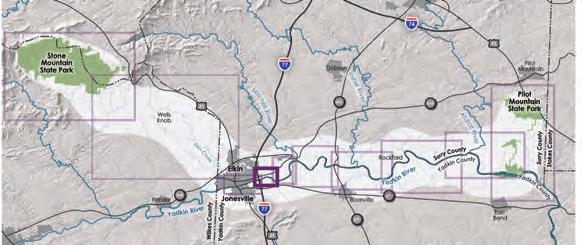
The trail corridor narrows significantly near River view lane. However, its feasible to traverse this “pinch point,” provided the railroad operator approves the design and encroachment within its right of way.

The “pinch points” exhibits on the subsequent pages provide alternatives for creating a safe and environmentally friendly bicycle and pedestrian environment.
The planning team observes the “pinch point” area between the railroad and Yadkin River.
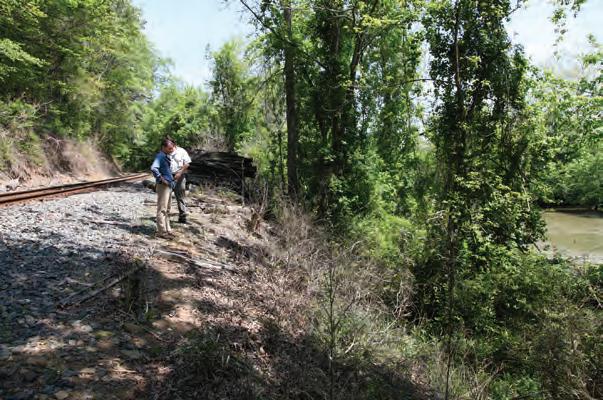
Interstate Park will serve as the transition from the Trail Towns loop to the Yadkin River section.
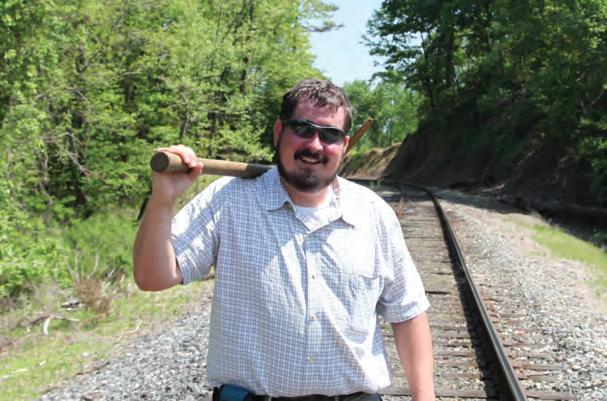
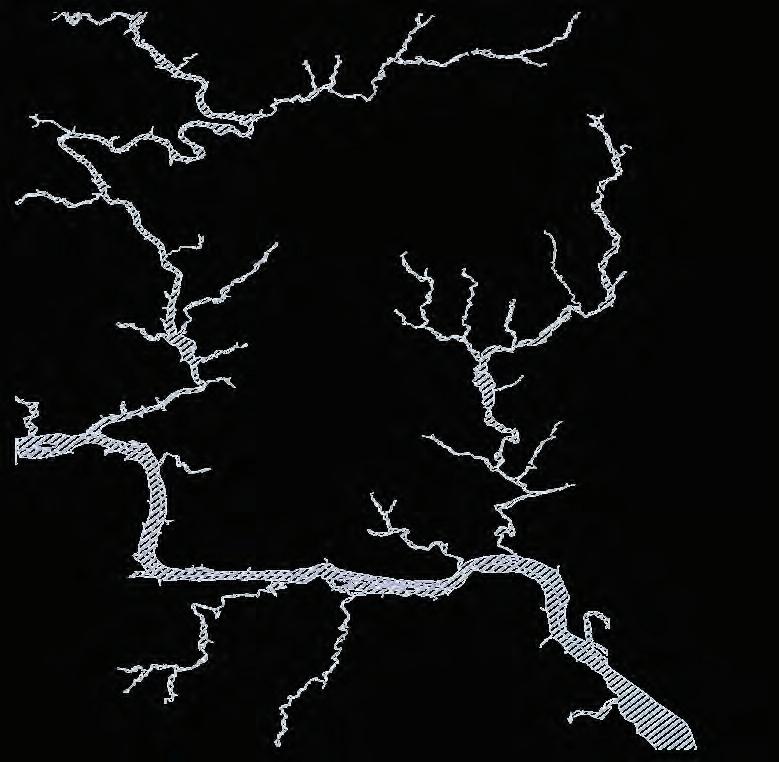







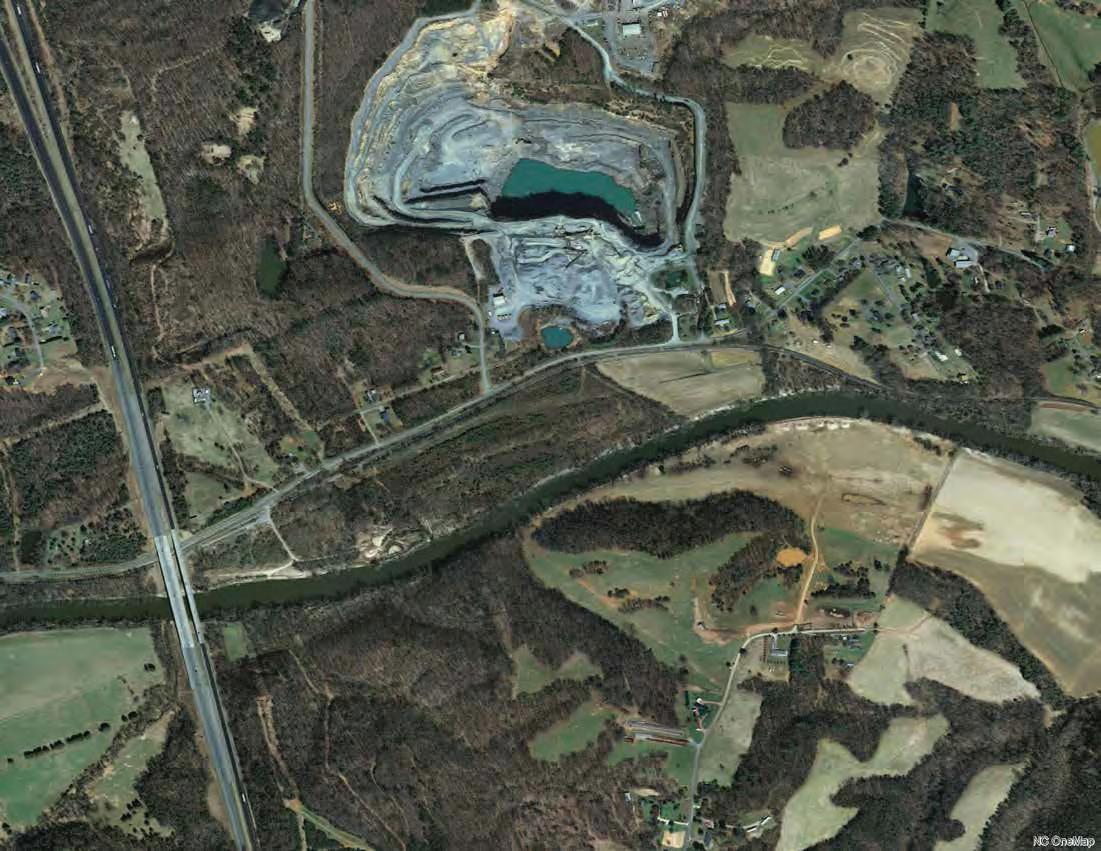
The trail “pinch point” highlights a section of trail with challenging environmental factors including the railroad corridor and steep topography.
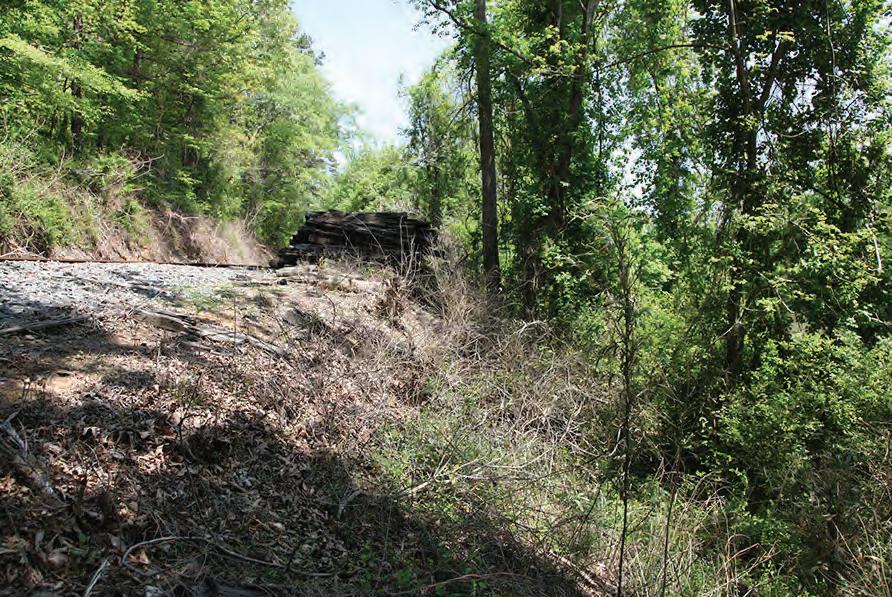
Detailed survey work is required in order to determine the best design solution, but two conceptual design solutions are presented: one with a retaining wall and one with a raised boardwalk. Although the boardwalk alternative is more costly, it may be necessary due to the narrow streambank.
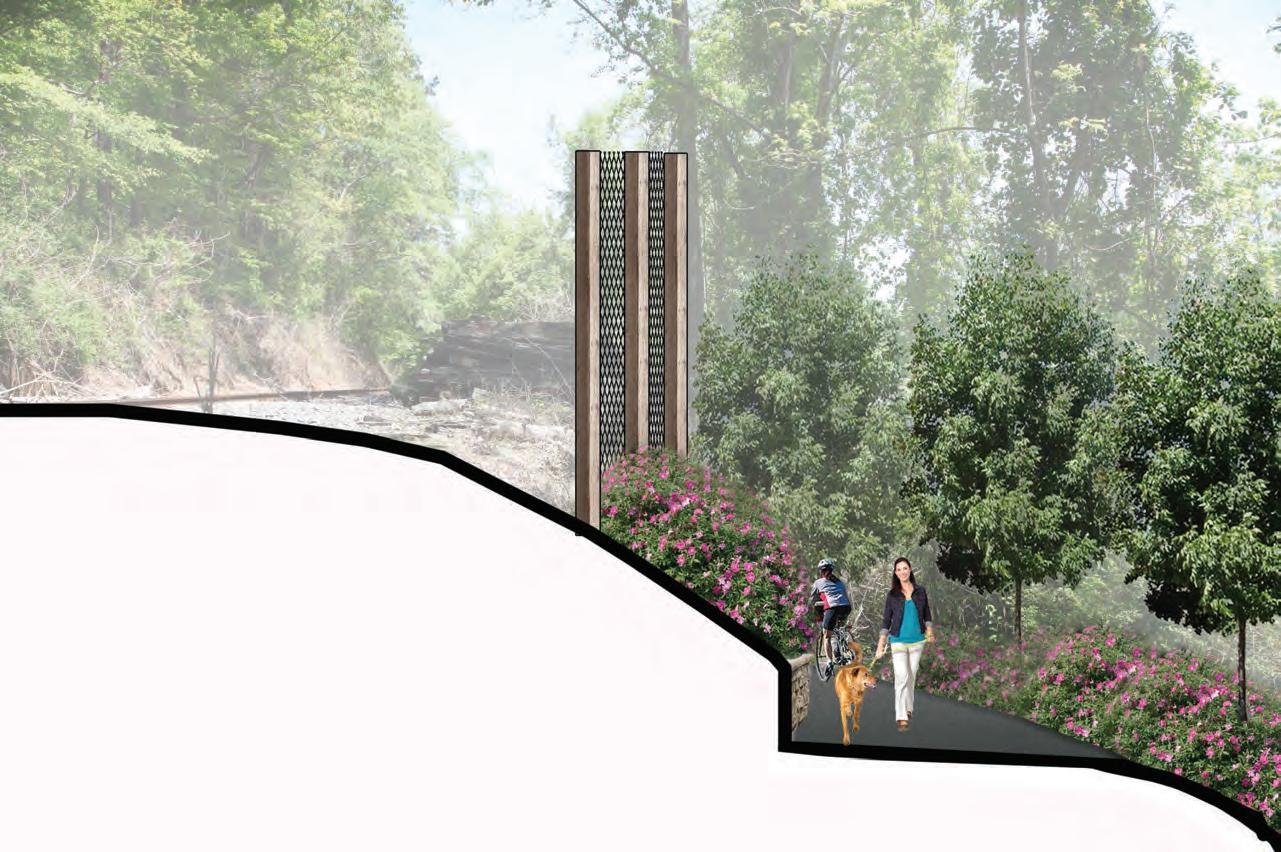
BoARdWAlK
Fencing to be 8 feet higher than rail line
native landscaping in riparian zone
Boardwalk will minimize disturbance

Signage speci es users to walk their bikes through this section
Bollards will encourage users to slow down and read signage
Quick facts:
TRAIL TYPE: C
SEgMENT MANAgERS/ DCg*: Surry Co.; Yadkin County; EVTA
TOTAL LENgTh: 2.4 Miles
fEASIBILITY fACTORS:
*DCG- Delegated Community Group
This trail sub-section from River view lane to Surry County property extends approximately 2.4 miles. Formal trailheads are recommended for both the east and west termini of the section. Beyond the Surry County Property, it will be difficult to maintain the preferred multi-use trail design while keeping the trail on the northern side of the Yadkin River. Thus, a major bridge (#17) is recommended within the sub-section, placing the trail in Yadkin County jurisdiction.
There are three (3) trailhead options that serve as the western terminus of sub-section 4b. The first potential trailhead – 18a – would utilize the east elkin Full gospel Church parking lot from the east. Trailhead option 18b would be located at the intersection of gaston lane and Highway 268. The third potential trailhead –18c – would be located near Willowbrook lake , but would also require a crossing over Highway 268
The preferred trail route continues on the north side of the Yadkin River passing a steep, but feasible area and several new and existing culverts before reaching the Surry County Property. A formal trailhead is recommended on the Surry County Property near Highway 268.
A trail could easily be constructed parallel to the fence line extending from trailhead 18a toward the railroad.
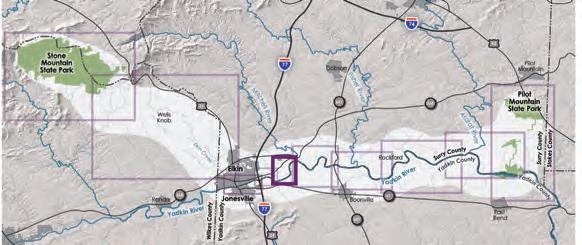

Surry County officials are building relationships with railroad operators to ensure implementation within this subsection.

a potential bridge
area





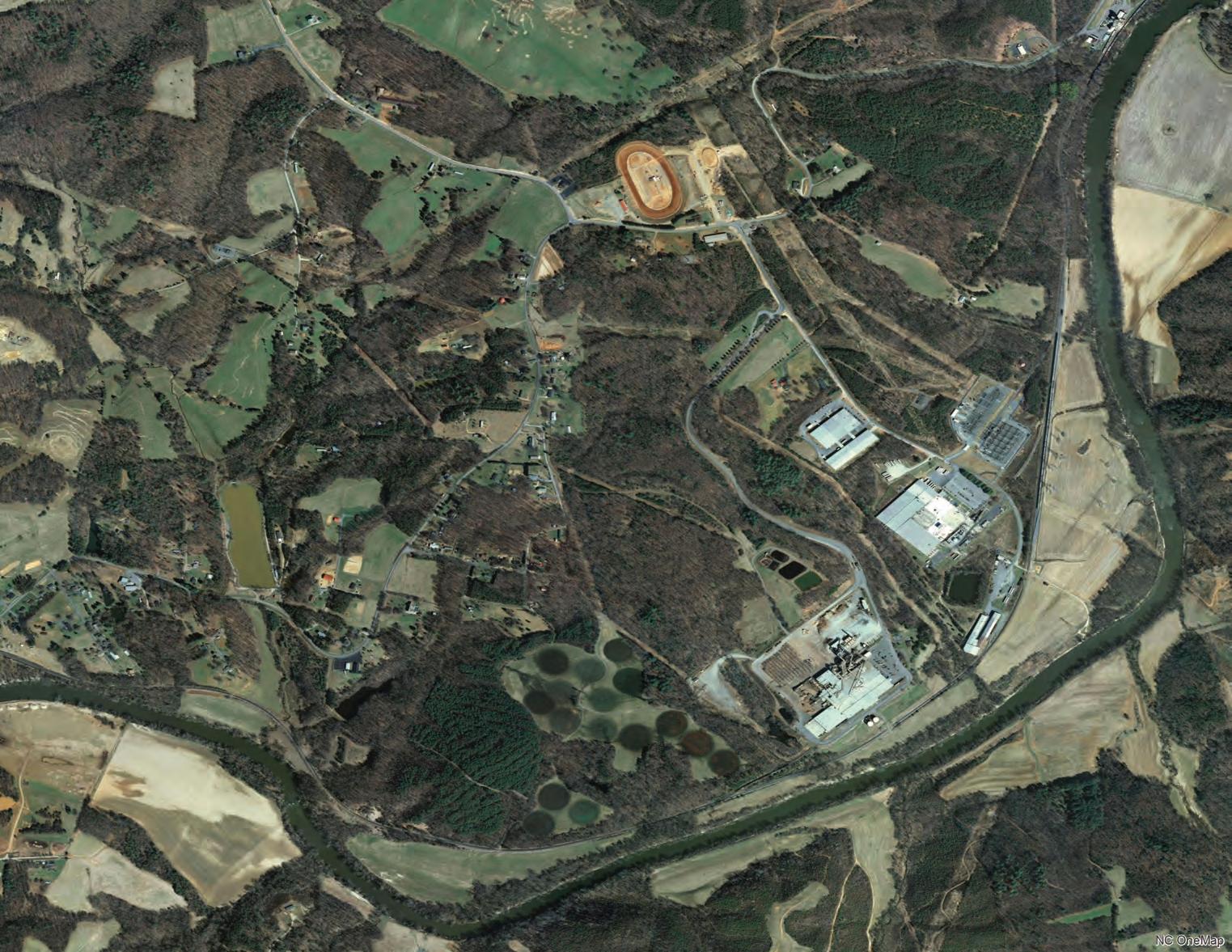
3. From Surry County Property
a







4. Since Recreation Trails
grant funding is being sought for this section, begin developing construction documents and engineering plans.
Surry County currently owns an approximately 120 acre tract that serves as the eastern terminus of this sub-section. While much of this property will be sold, the county plans to retain a trail easement and trailhead parking area for the MST.

due to environmental barriers, including Highway 268 and the Wayne Farms Plant, a bridge crossing is necessary over the Yadkin River to provide for a multi-use trail.

The construction of trailhead #19 should incorporate stream enhancements and stormwater best management practices.






























Sub-sections 4c-4f are comprised primarily of rural and agricultural land uses. Agricultural land adjacent to the Yadkin River is ideal for greenway development, provided fencing or other measures are incorporated to adequately protect private property.
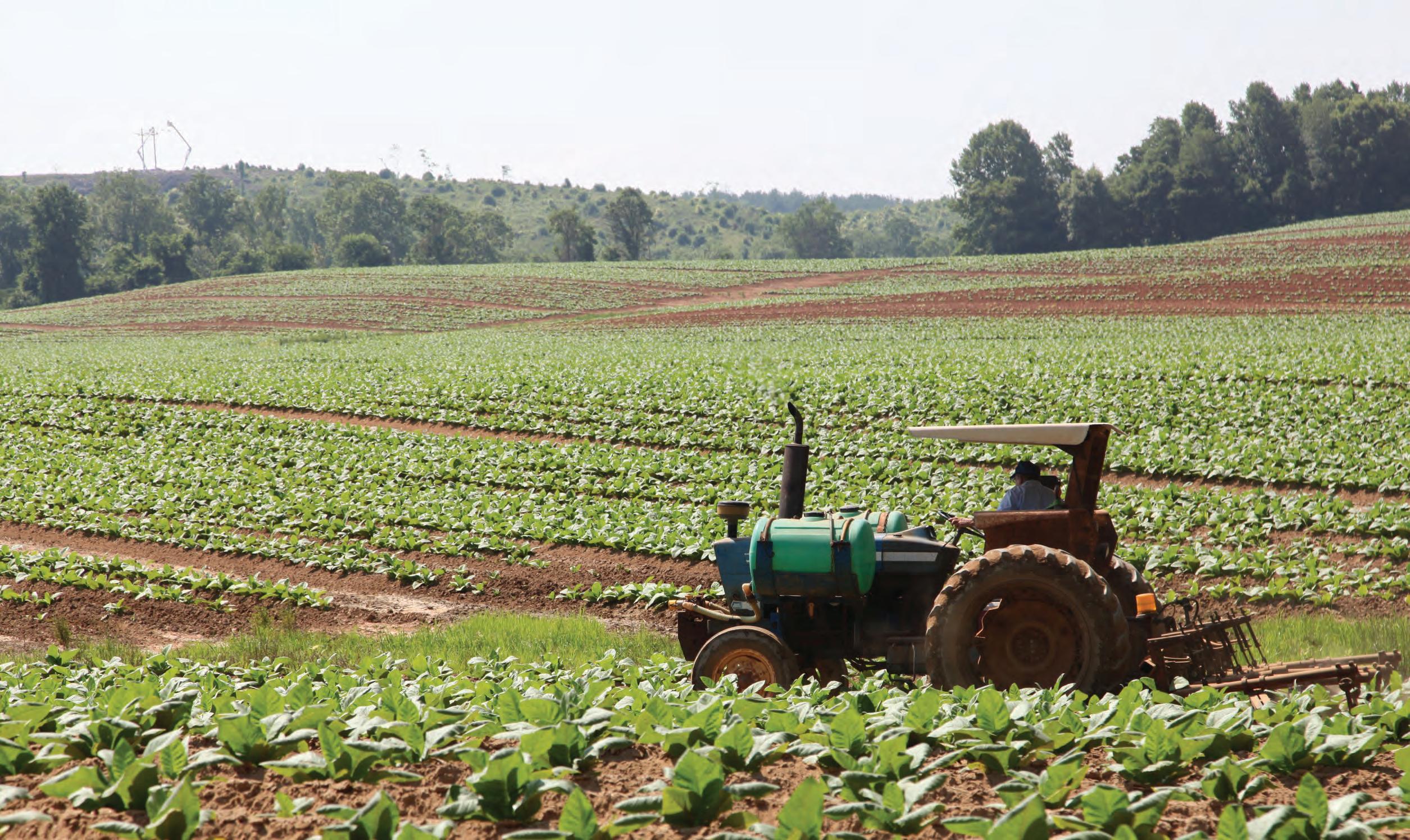
Quick facts:
TRAIL TYPE: C
SEgMENT MANAgERS/ DCg*: Surry Co.;Yadkin Co.
TOTAL LENgTh: 6.2 Miles
RELATIVE PARCEL DENSITY: 1.85
fEASIBILITY fACTORS:
HIgH ASSeT ConneCTIvITY
HIgH RelATIve PARCel denSITY
FAvoRABle envIRonMenT
SegMenT MAnAgeR CoMMITMenT
This sub-section from Surry County property to the Shores River Access extends approximately 6.2 miles. The Carolina Winery, Mitchell River Paddle Access, and the Shores River Access are all major community assets found within this section.
From the west, the preferred trail alignment includes bridging the Yadkin River to the south and connecting to the Yadkin County side of the river to ensure the development of a multi-use trail.
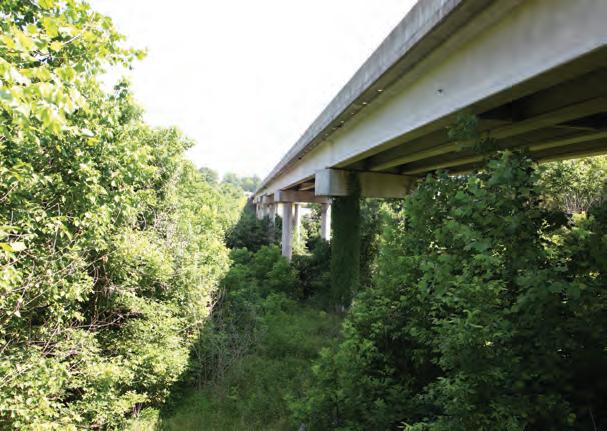
Crossing to the south side of the Yadkin River is required here because of the presence of Wayne Farms, the railroad and Highway 268.
Considering the aggressive efforts of Surry County and EVTA to implement the trail sections from Surry County Property west to Elkin, this section from Surry County property east to Shores River Access represents a major priority focus area for Yadkin County.
An alternative trail route should be pursued further on the northern side of the Yadkin River and beyond the Surry County Property, but will need to be constructed to the single-use hiking standard or the dual-use hiking and equestrian standard depending on landowner willingness and environmental factors.
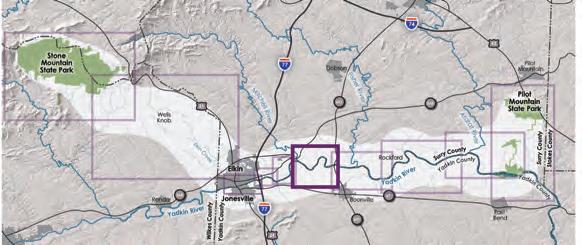
Trail construction is feasible underneath Highway 601.
Tobacco remains a major crop in Yadkin County.

This area

be recognized
a priority focus area for











in
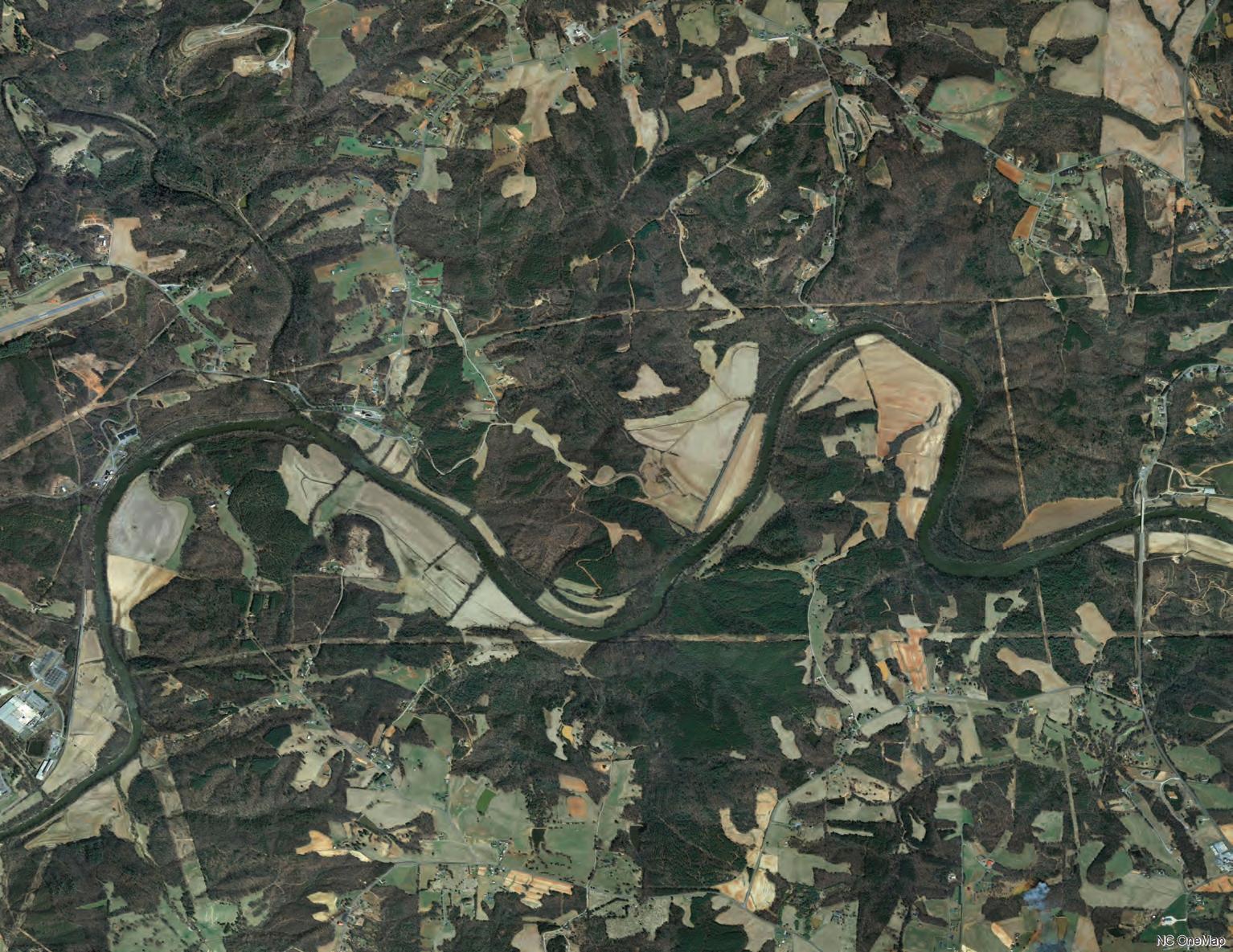
Explore a hiking trail from Surry County Property to Carolina
and the Mitchell River

From Surry County Property
#19), explore a northern equestrian trail.
explore a potential spur hiking/ equestrian trail along Duke Energy corridor.
Remain committed to a multiuse trail design and a bridge over the Yadkin River to the south side of the Yadkin.
Quick facts:
TRAIL TYPE: D
SEgMENT MANAgERS/ DCg*:
TOTAL LENgTh: 5.2 Miles
RELATIVE PARCEL DENSITY: 1.35
Surry Co.;Yadkin Co.; Boonville; Rockford Preservation Society
The Shores River Access to Rockford sub-section extends approximately 5.1 miles in length. The subsection is bound to the east by U.S. 601 and to the west by the Rockford Road bridge. The Shores River Access provides an opportunity for a major MST trailhead and transitions from a multi-use trail to a multi-use greenway with parallel equestrian trail.
This sub-section includes a variety of assets, including Hutton vineyards, Rockford Bed & Breakfast, Holly Ridge Family Campground, and the Town of Boonville.
Possible trail spurs to Boonville include corridors connecting the Holly Ridge Family Campground and another along Tanyard Creek.
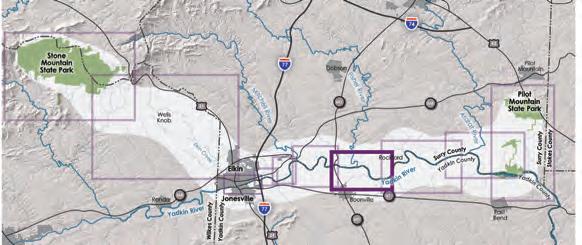
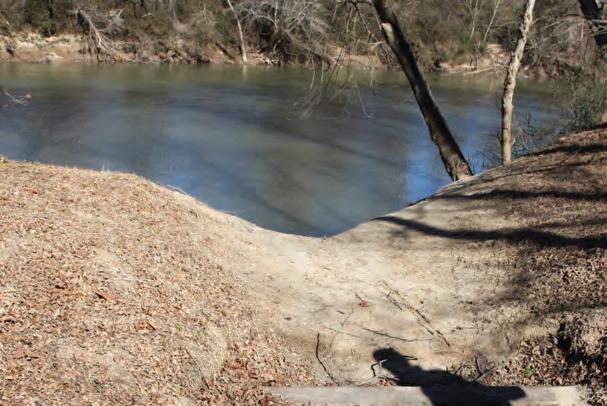
Due to an approximately 1/2 mile area of steep slopes on the south side of the Yadkin River, an alternate route paralleling Tanyard Creek Road should be explored.
fEASIBILITY fACTORS:
HIgH ASSeT ConneCTIvITY
HIgH RelATIve PARCel denSITY
FAvoRABle envIRonMenT
SegMenT MAnAgeR CoMMITMenT
*DCG- Delegated Community Group
Holly Ridge Family Campground could serve as an important connection point between the MST Trail and Boonville.
Shores River Access recently obtained a Recreational Trails Program grant and will soon be receiving site improvements.














1. Recognize Boonville as an official Stone to Pilot Trail Town and priority for trail connectivity.
2. . Explore the expansion of the shores river access into an equestrian trailhead
3. Provided adjacent landowner willingness exists surrounding the Shores River Access, this location should serve as an anchor for connecting Boonville into the trail system.

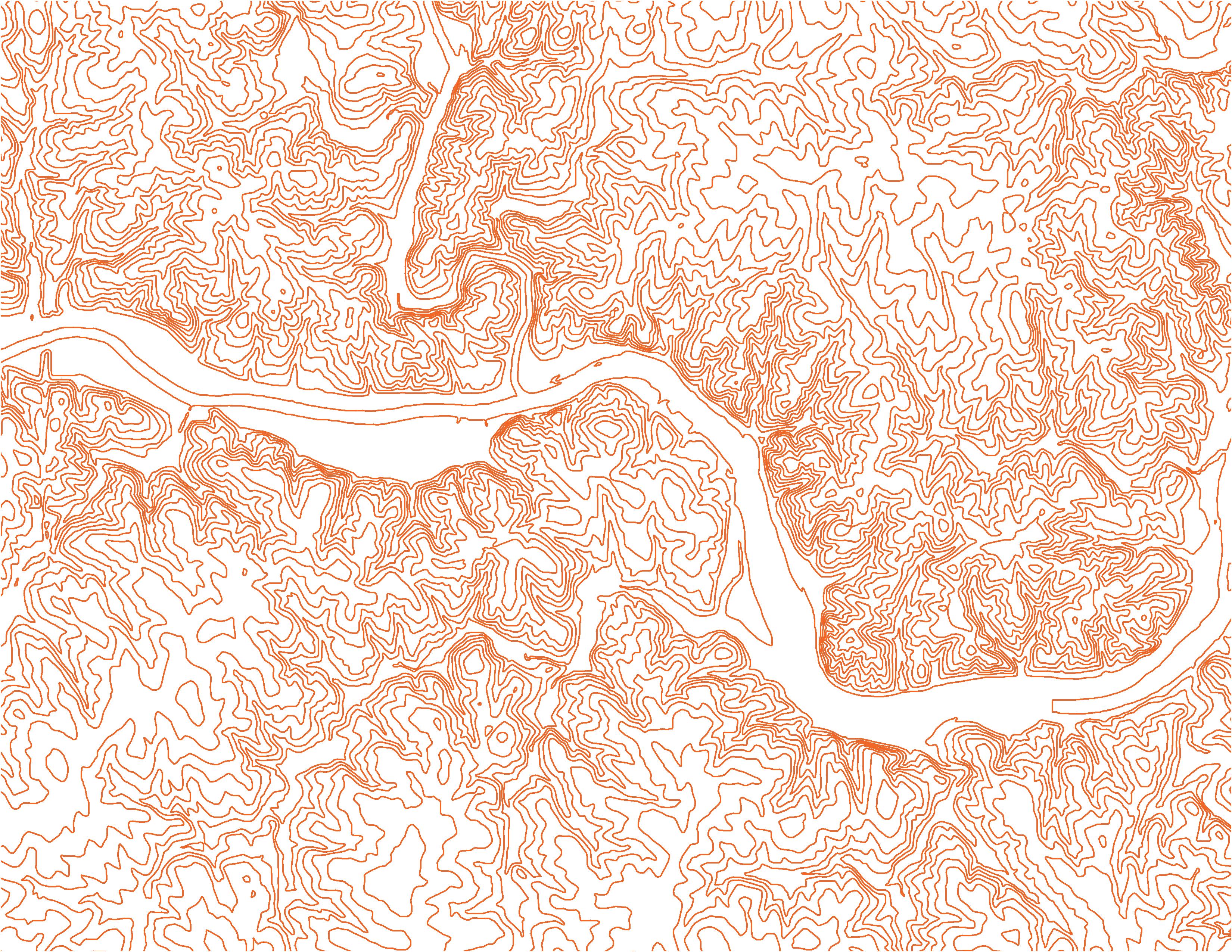

3. explore a suspension bridge utilizing the Highway 601 bridge foundation supports (similar to the I-77 bridge proposed at Interstate Park in the Trail Towns section).
4. explore potential trail connections parallel to Tanyard Creek Road in an effort to avoid the steep slopes section.
Group/ Trail Type

TRAIL TYPE: D
SEgMENT MANAgERS/ DCg*:
This section from Rockford to Siloam Road is approximately 8.42 miles in length. Although this sub-section has a relative parcel density of 1.77, there are considerable environmental constraints such as numerous steep slopes, pinch points, and the railroad on the northern side of the Yadkin.

Surry Co.;Yadkin
Co.; Rockford Preservation Society; Sauratown Trails Association
TOTAL LENgTh: 6.8 Miles
RELATIVE PARCEL DENSITY: 1.42
fEASIBILITY fACTORS:
HIgH ASSeT ConneCTIvITY
HIgH RelATIve PARCel denSITY
FAvoRABle envIRonMenT
SegMenT MAnAgeR CoMMITMenT
The potential trail corridor on the south bank of the Yadkin River has one (1) necessary stream crossing: Bowman Mill Creek. The potential trail corridor on the north bank has two (2) necessary stream crossings: West double Creek and Candiff Creek.
Sub-section 4e includes a number of assets, including Rockford Bed & Breakfast, the Rockford Preservation Society, Yadkin River Adventures, Historic Richmond Hill nature Park, which includes the Historic Richmond Hill law School, and riverfront property off of old limerock Quarry drive owned by nCdoT.
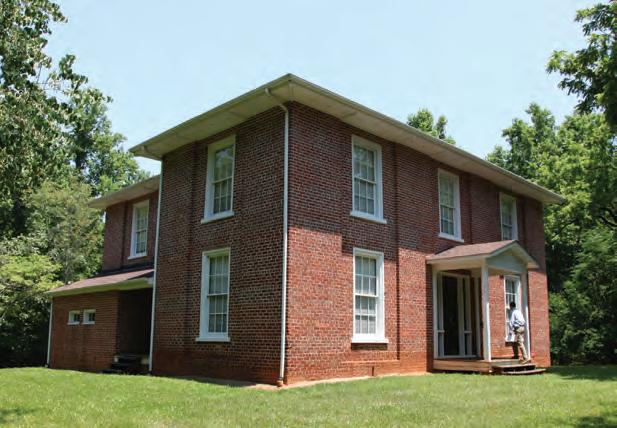
Possible spur trails include Rockford Bed & Breakfast to the Yadkin River and connecting the trail system to Historic Richmond Hill nature Park, possibly via the limerock property owned by nCdoT.
The Historic Richmond Hill Law School is a key feature at the Richmond Hill Nature Park.
From Siloam Road Bridge, paddlers are seen enjoying the Yadkin River.
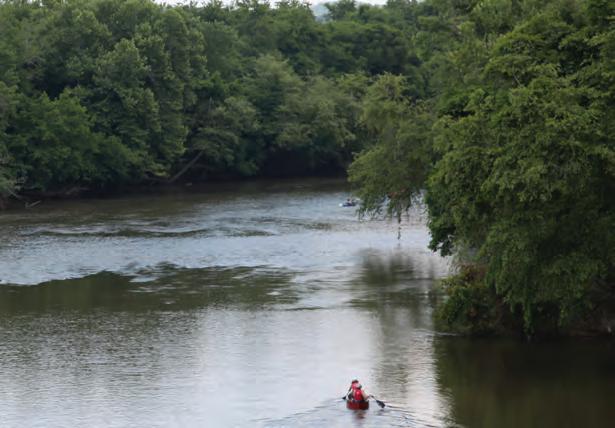
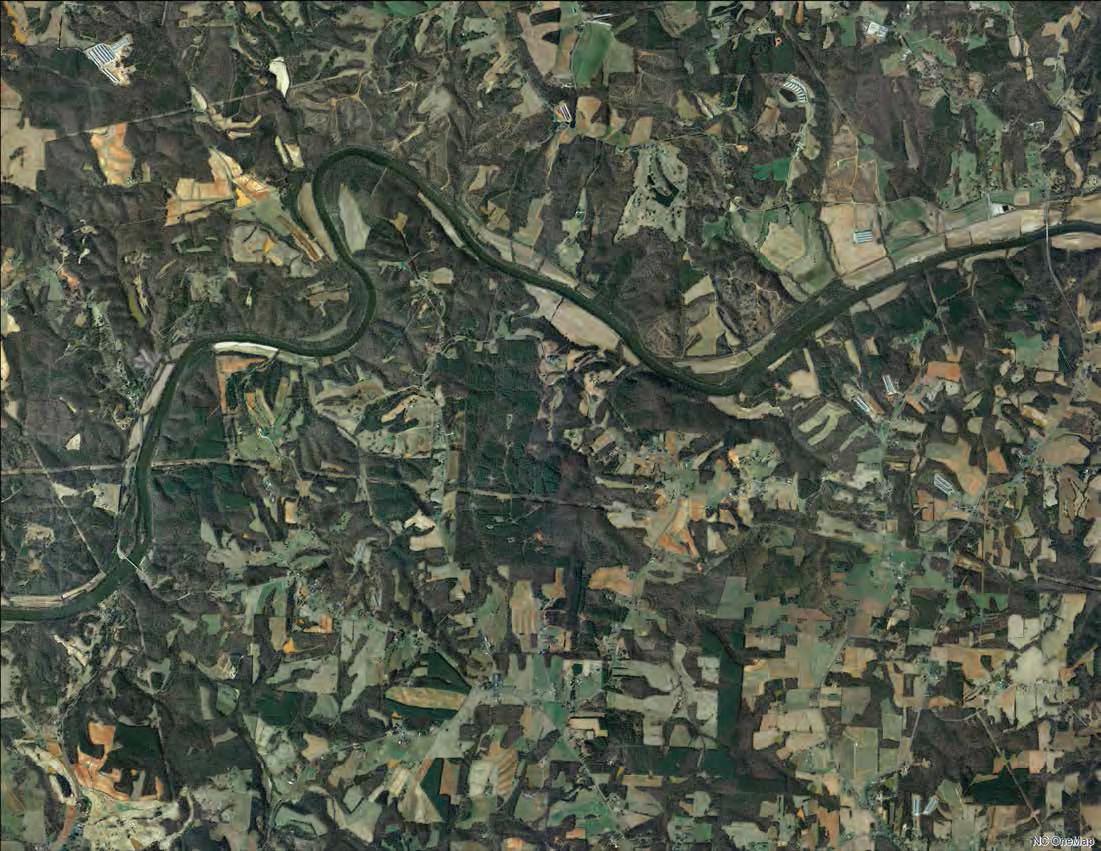
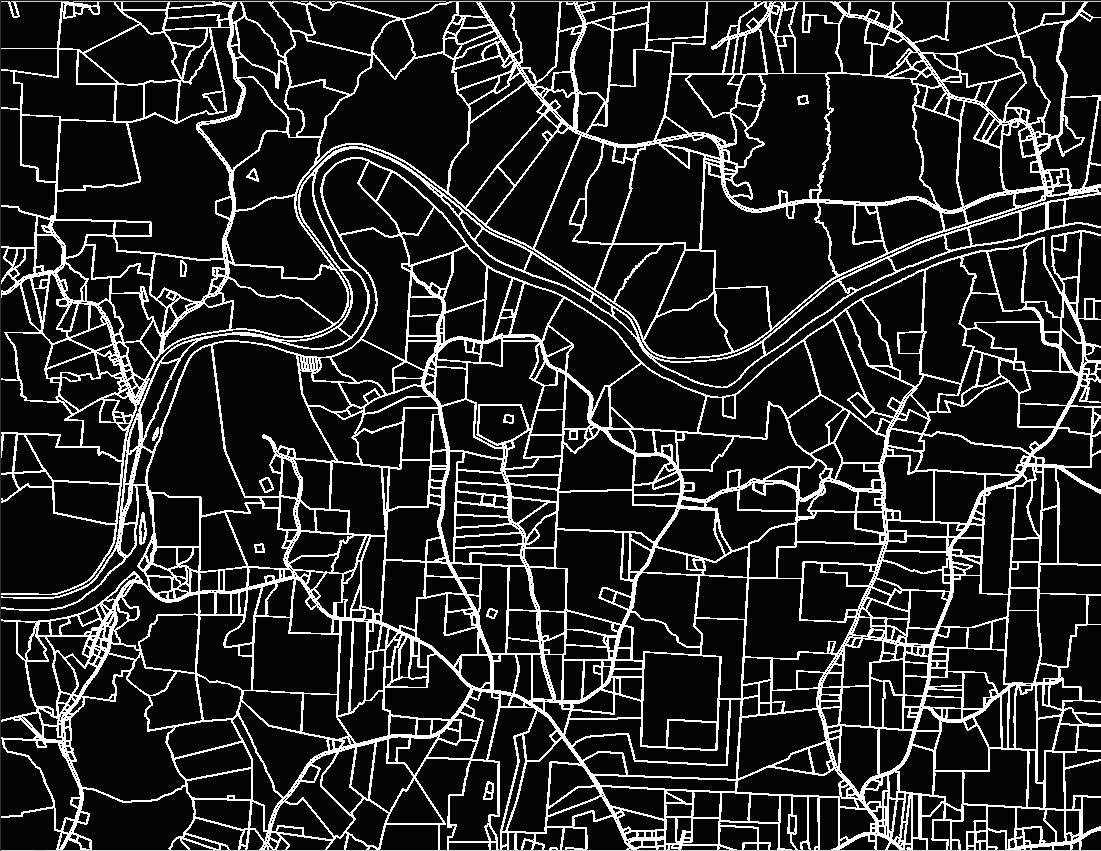

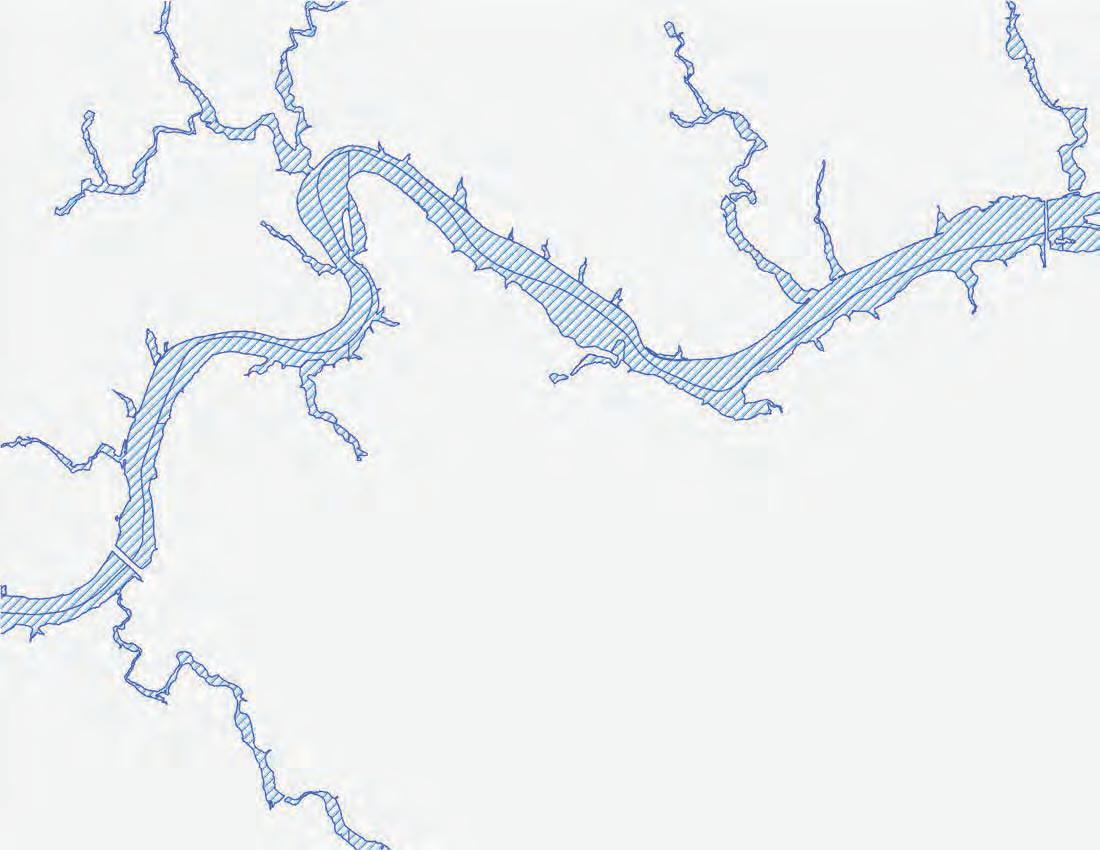













Quick facts:
TRAIL TYPE: D
SEgMENT MANAgERS/ DCg*:
Surry Co.;Yadkin Co.; nCdPR; Sauratown Trails Association,
This section from Siloam Road to Pilot Mountain State Park extends approximately 4.2 miles in length. A western trailhead should be explored near the Siloam Road Bridge. To the east, and connecting to Pilot Mountain State Park, are four (4) possible trailheads and connectivity points, including Shoals Community Recreation Center to the north (#25), Houser Road Parking (#24), Shoals River Access (#22), and Ivy Bluff Parking lot (#23).
preferred multi-use trail standard.
An alternative route on the north side of the Yadkin River and along the Ararat River, connecting to Shoals Community Center and then Pilot Mountain should continue to be explored, but the preferred multi-use trail standard will be difficult to maintain along this corridor.
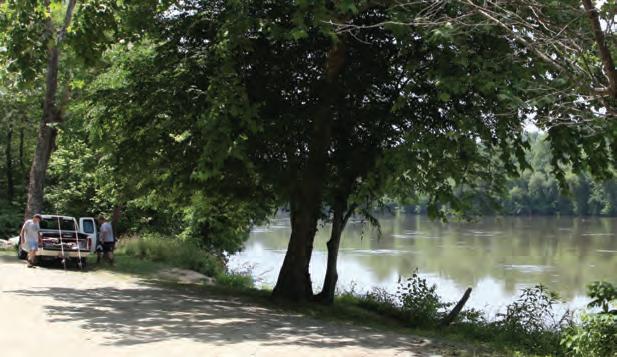
TOTAL LENgTh: 4.1 Miles
RELATIVE PARCEL DENSITY: 0.90
fEASIBILITY fACTORS:
HIgH ASSeT ConneCTIvITY
HIgH RelATIve PARCel denSITY
FAvoRABle envIRonMenT
SegMenT MAnAgeR CoMMITMenT
*DCG- Delegated Community Group
Although trail users would be required to cross the Yadkin River to access Pilot Mountain State Park, the preferred trail alignment is south along the Yadkin River and will connect to Shoals River Access or Ivy Bluff Parking lot. This access will serve as a terminus for the
Shoals River Access presents a major trailhead opportunity.

There was a strong interest in the Stone to Pilot Workshop to connect Shoals Community Recreation Center with Pilot Mountain State Park.
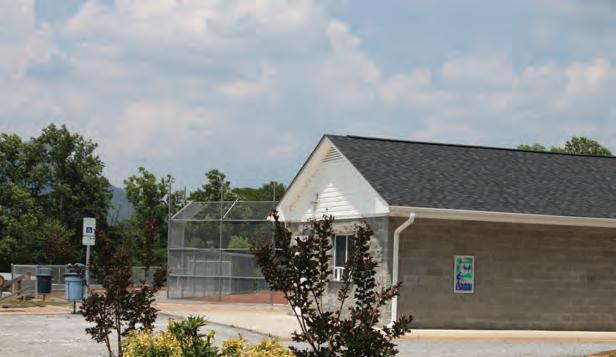
project
a trailhead at
establish
explore
detailed planning efforts
















Ivy Bluff Parking lot toward Siloam Road
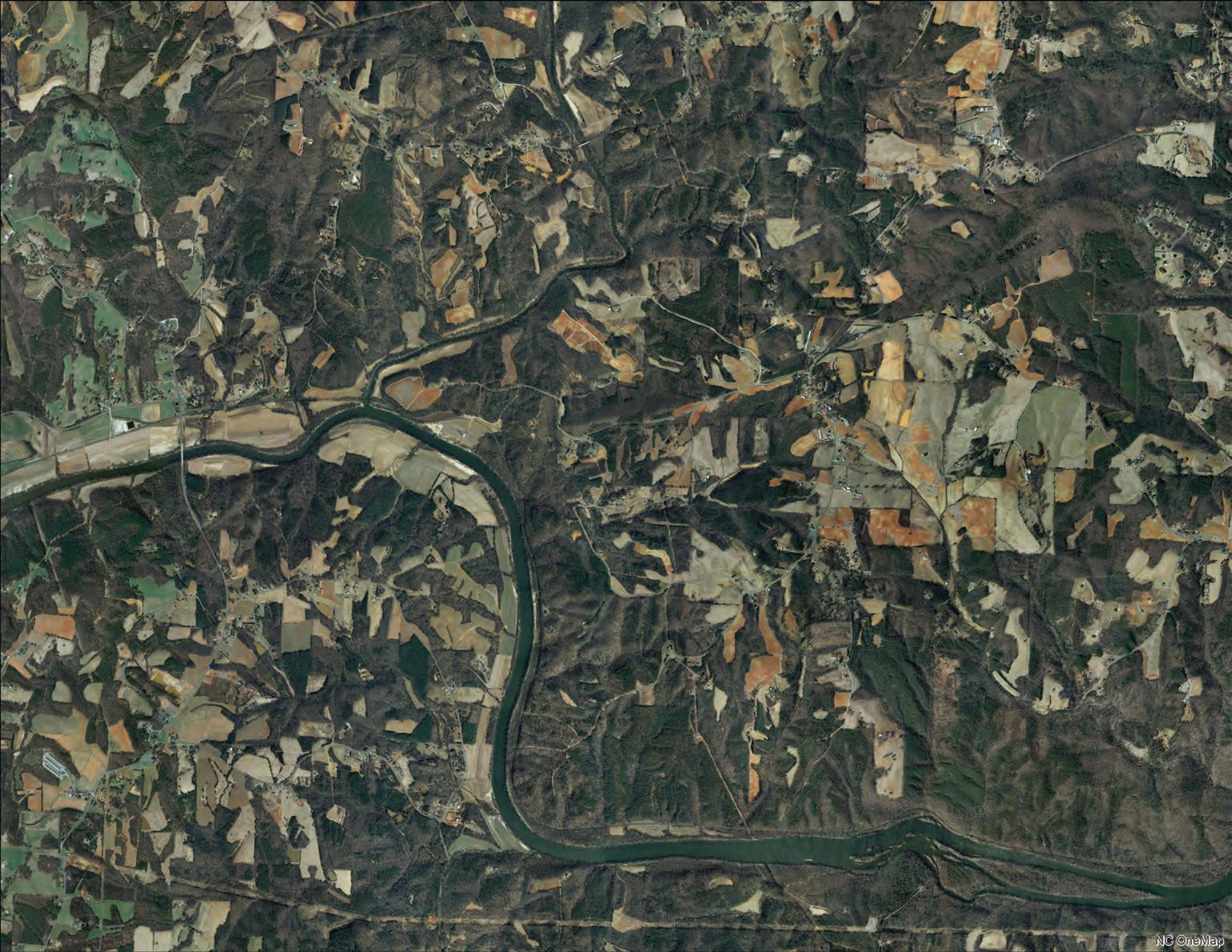
a hiking-only trail route

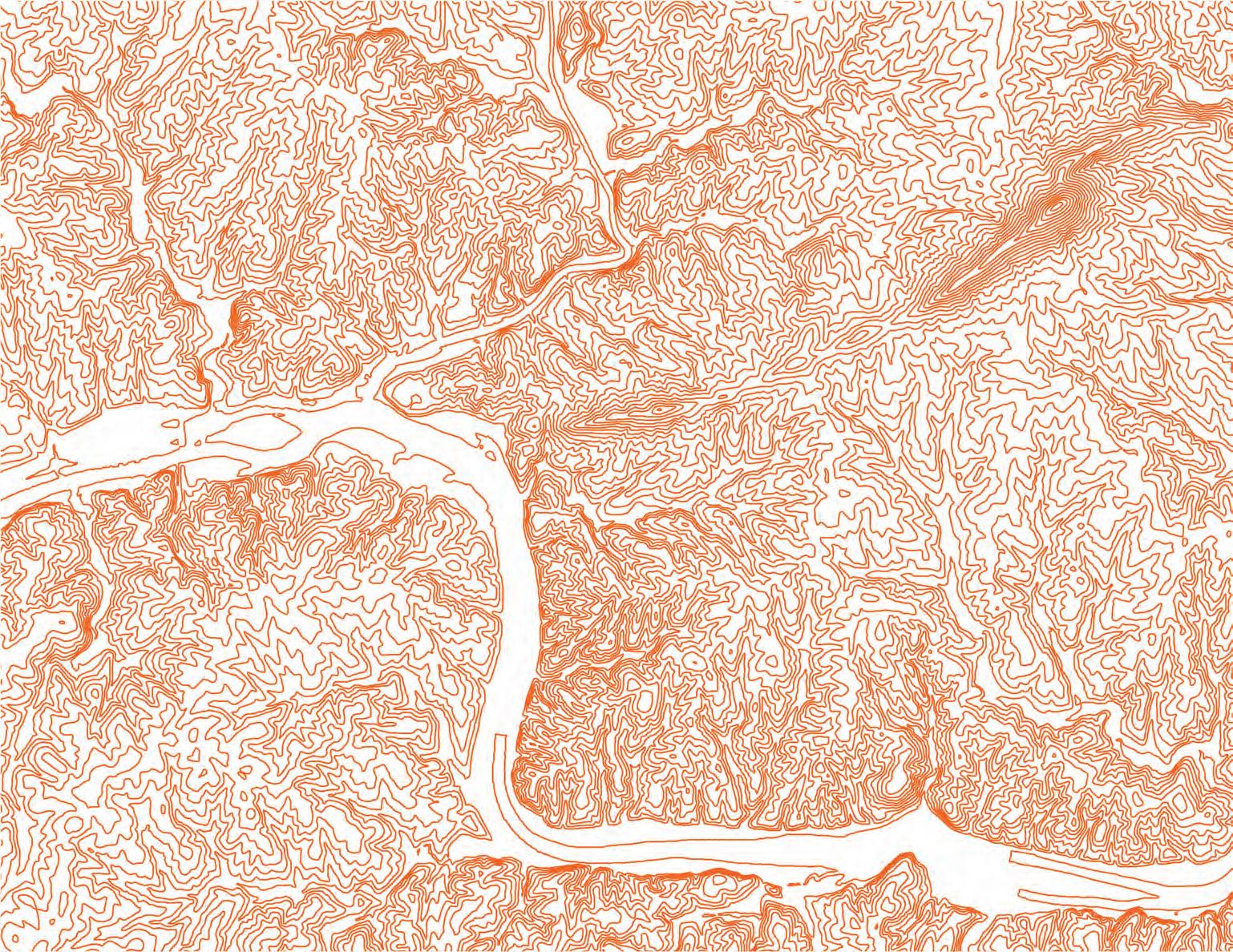
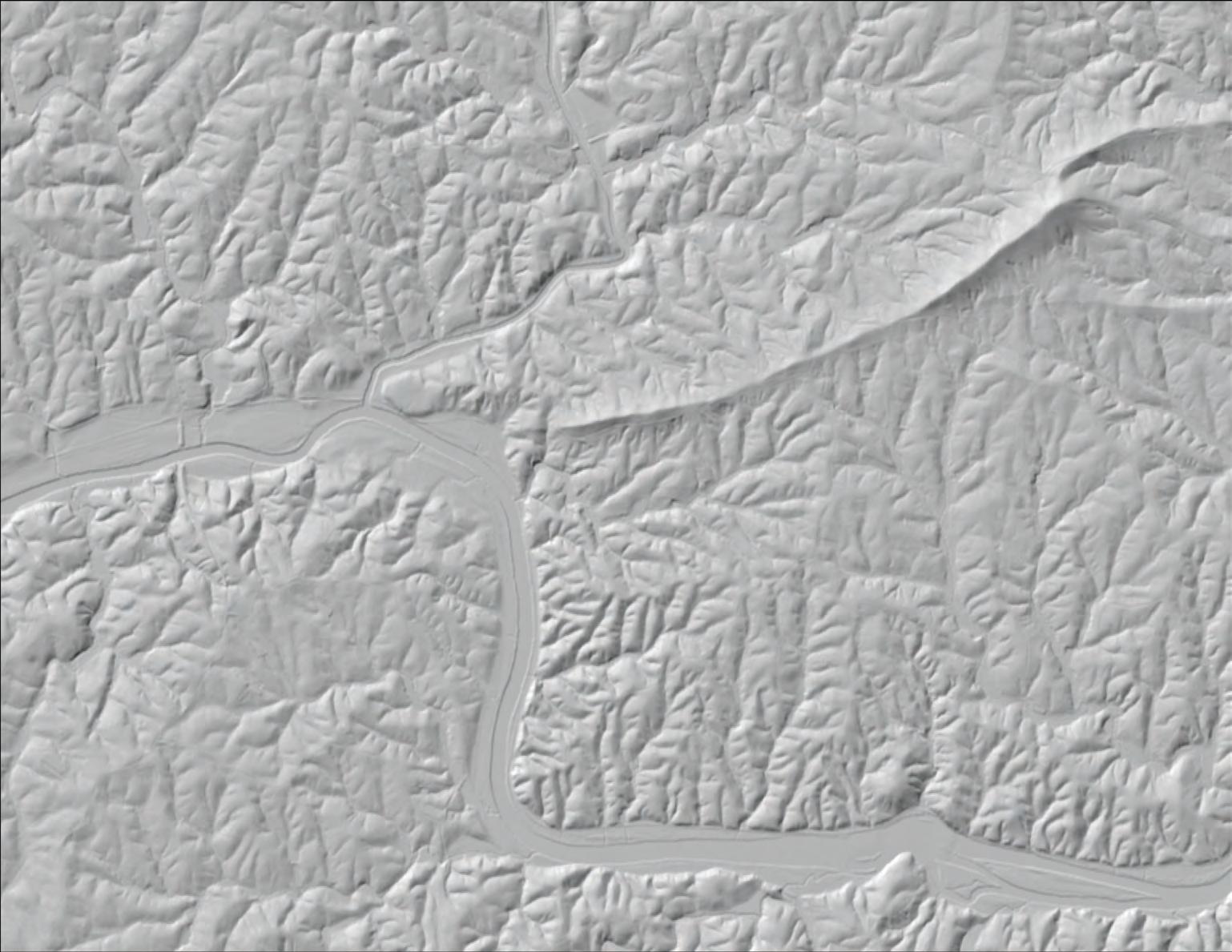
Shoals Community
Center
the Pilot Mountain State Park Corridor
Shoals River Access to Ivy Bluff
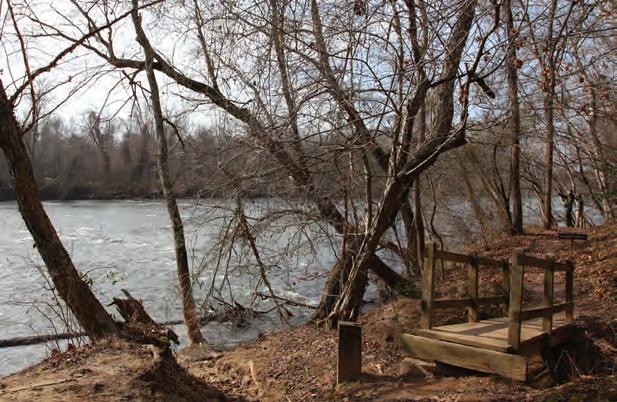
Ivy Bluff to Hauser Rd.
Hauser Rd. to Surry line
Surry line to Highway 52
@ Shoales River Access
TRAIL TYPES: d, B, & A (Transitions @ Ivy Bluff, Hauser Rd. lot, and Surry line lot)
SEgMENT MANAgERS/ DCg*:
Three potential routes exist to connect into the Pilot Mountain State Park Planning Sector: Shoals River Access/Ivy Bluff Parking lot; north of the Yadkin River; and Shoals Community Recreation Center. The most favorable route would connect on the southern side of the Yadkin River at the Shoals River Access/Ivy Bluff Parking lot. This route provides adequate conditions for the preferred multi-use greenway with parallel equestrian trail standard.
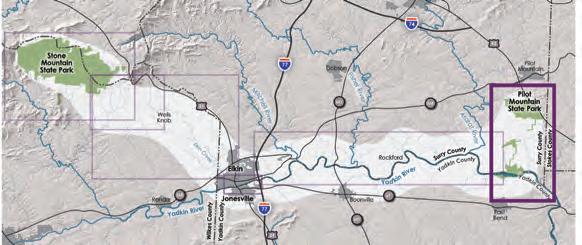
TOTAL LENgTh: 15.41 Miles
fEASIBILITY fACTORS:
nCdPR; Friends of Sauratown Mountains
Pilot Mountain State Park already contains an approximately 12.2 mile section of designated MST. Within the park, the trail will consist of multi-use greenway with parallel equestrian trail type, hikingonly or equestrian & hiking trails.
Looking south, an island in the Yadkin River can be seen from Pilot Mountain State Park trails.
HIgH ASSeT ConneCTIvITY
FAvoRABle envIRonMenT
SegMenT MAnAgeR CoMMITMenT
*DCG- Delegated Community Group
Pilot Mountain is one of the most notable geographic features in North Carolina.

The multi-use trail standard will end at the Ivy Bluff Parking lot (#23). From the Ivy Bluff Parking lot, the current Pilot Mountain State Park trail system requires fording the Yadkin River in order to continue north into the park. An optional series of three bridges (#19) would allow hikers to safely cross the Yadkin River.
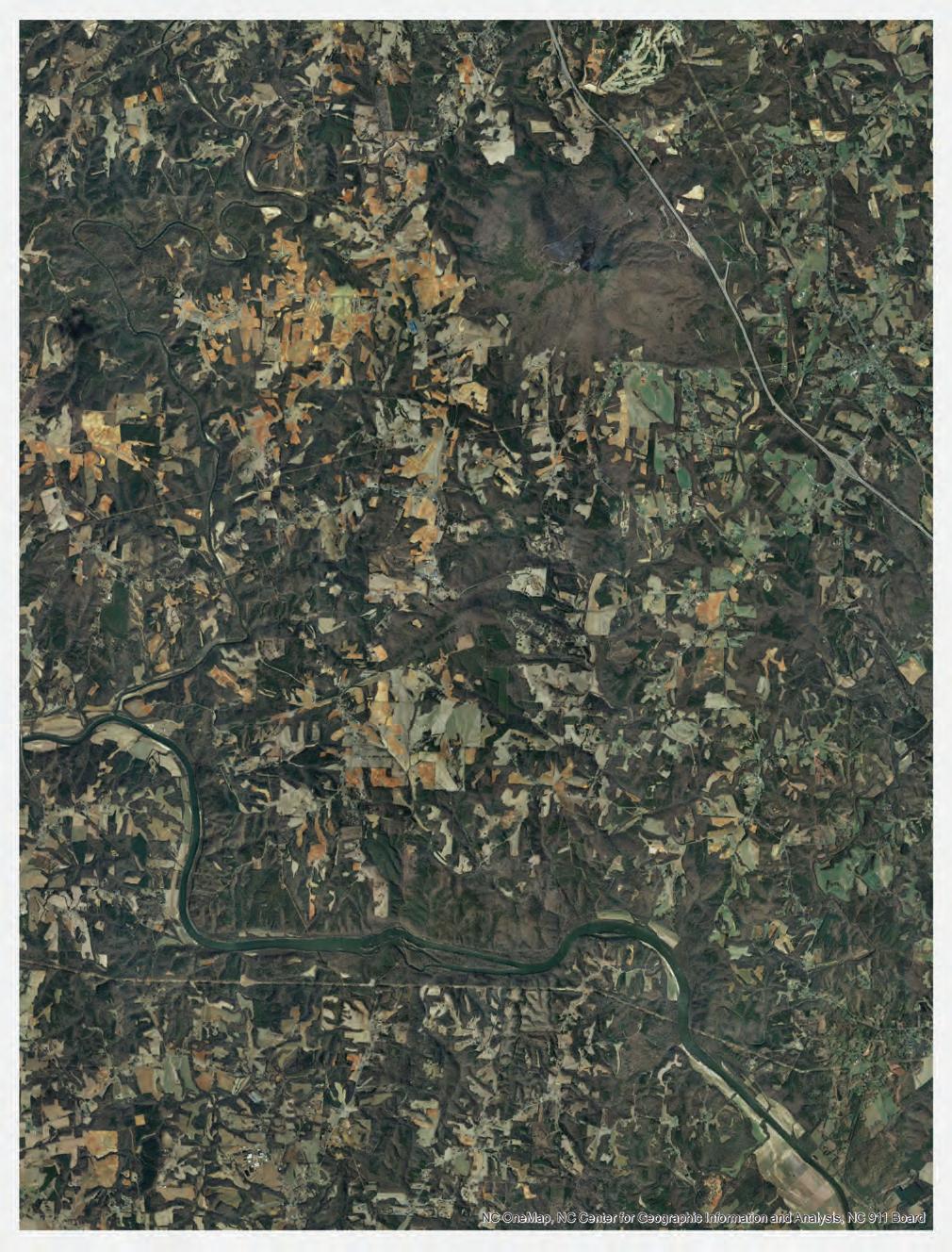
The trail is hiking-only from Ivy Bluff Parking lot to Hauser Road Parking lot where the Corridor Trail transitions to hiking and equestrian for 6.6 miles before reaching Surry line Parking lot (#26). Within the Corridor Trail, five road crossings (#20 - #24) exist where appropriate wayfinding signage should be installed to signify motorists.
In the northern section of the park, referred to as the Mountain Section, the state is currently working to reroute the Mountain Trail which also serves as a hiking-only section of the MST. A visitor center is proposed at Highway 52 and provides an opportunity to create a distinctive entrance and exit for not only Pilot Mountain State Park, but also the MST.

1. Identify a hiking-only trail route connecting Shoals Community Recreation Center to the Pilot Mountain State Park Corridor Trail.
2. Reroute the Mountain Trail to the south, providing for a more sustainable and user friendly trail segment.
3. Incorporate signage into new and existing facilities at Pilot Mountain State Park to communicate the presence and location of the MST to all user groups.
4. Although beyond the study area of this plan, explore a trail connector from Pilot Mountain State Park to the Town of Pilot Mountain.

5. Conduct a detailed bridge study for crossing the Yadkin River connecting Yadkin County and Surry County.




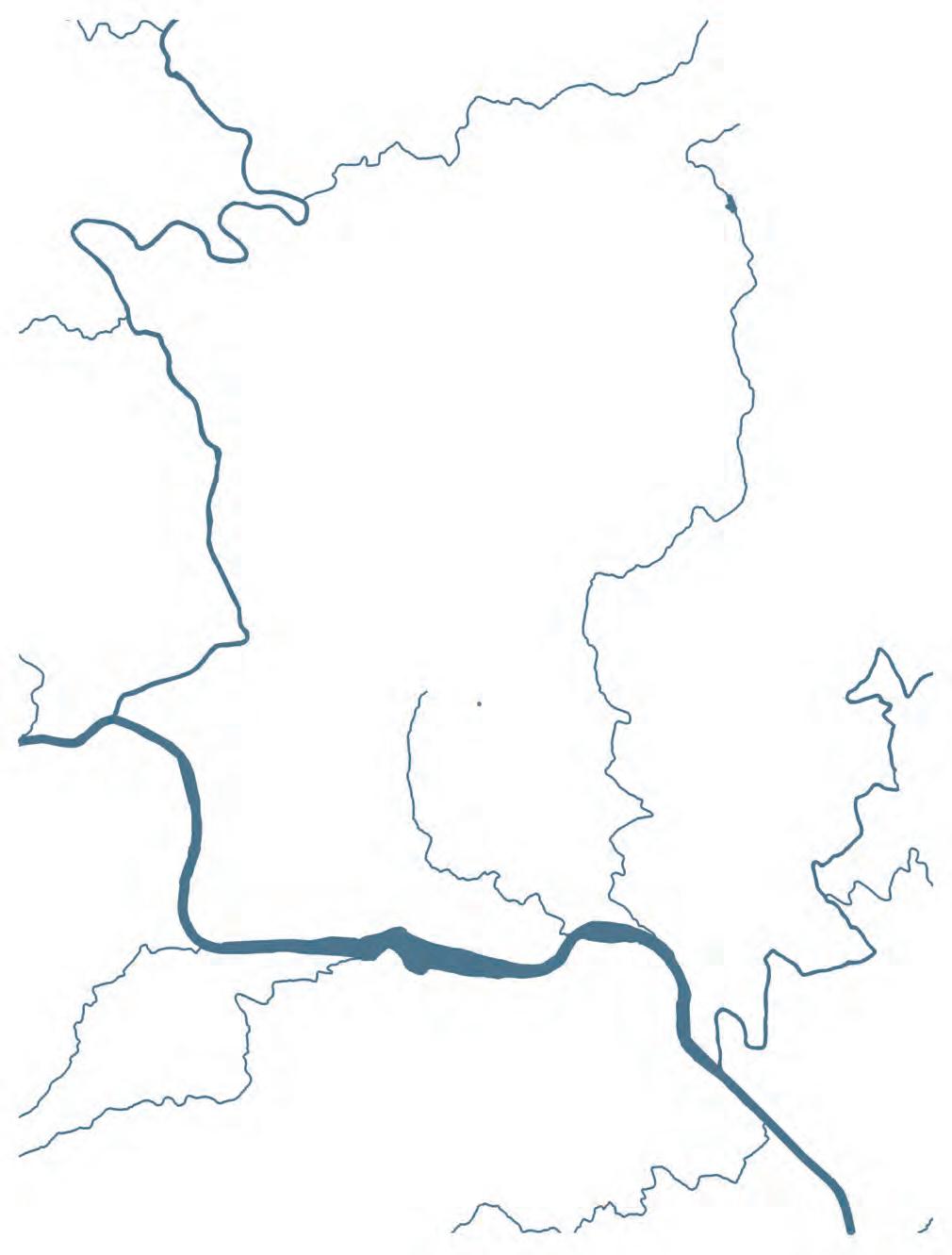
6. outside of Pilot Mountain State Park, work to incorporate the Yadkin valley Heritage Corridor signage and wayfinding designs for all existing trails, parking lots, and road crossings.
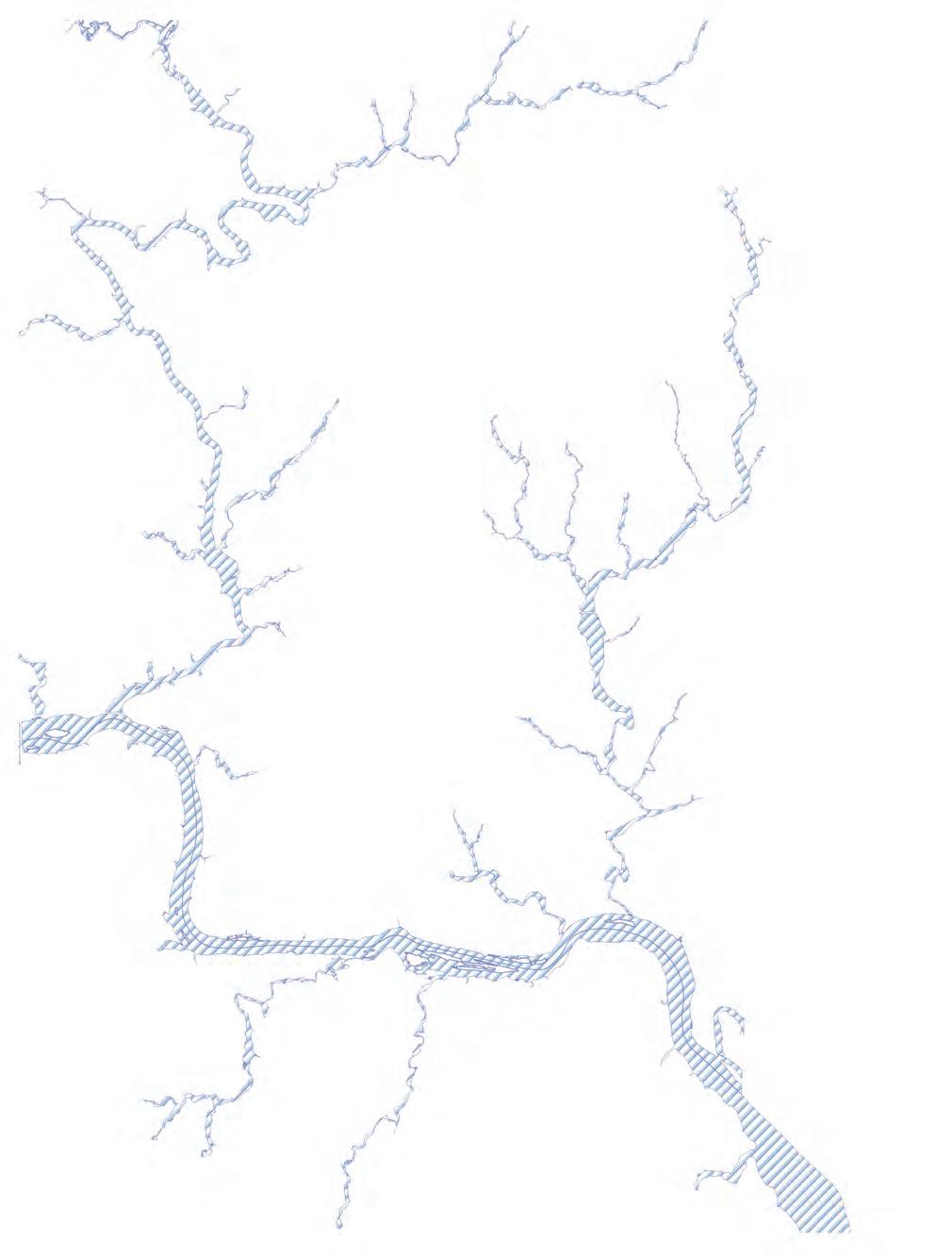
The Trail Profile exhibit (see page right) provides a comprehensive overview of the trail user groups and trail types proposed throughout the study area.
Upon completion, the trail will provide for approximately 70 miles of designated MST. However, of this distance, only 16.9 miles (23%) of the trail will be hiking-only.
17 miles (23%) of the trail will serve as multi-use greenway designated MST extending from the west at Carter Falls, through elkin and Jonesville, and along the Yadkin River before connecting to Shores River Access.
23.5 miles (32%) of MST designated trail will serve equestrian users in addition to hikers. Approximately 9.5 miles of designated MST equestrian trail currently exists at Pilot Mountain State Park. This plan calls for approximately 17 miles (23%) of new equestrian and hiking MST designated trail extending from the intersection of the Bridal and lower Falls Trails in Stone Mountain State Park south to Carter Falls in Surry County. This plan does recommend exploring an equestrian trail north from the trailhead and parking area planned at the Surry County Property as noted in Planning Sections 4B and 4C.
16 miles (22%) of the proposed trail will be comprised of a multi-use greenway with a parallel equestrian trail. This segment extends from Shores River Access to the Ivy Bluff Parking lot in Pilot Mountain State Park.
A significant portion of the study area includes the state designated Yadkin River Paddle Trail. With the development of river access areas beginning at Elkin Creek’s Carter Falls to the confluence of the Yadkin River Paddle Trail, collectively this study area provides for approximately 28.5 miles of navigable river.
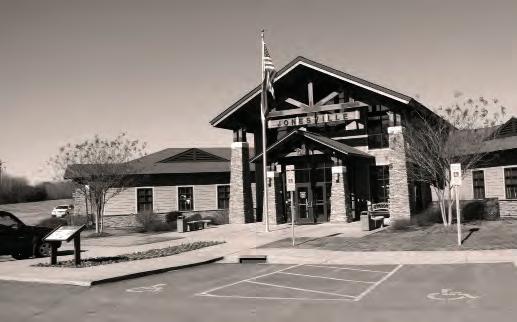
1. Segment Managers and Delegated Community Groups Areas of Responsibility
2. Trail Section Implementation Priorities
3. Local Government Trail Support Spectrum
4. Objectives
The North Carolina Division of Parks and Recreation (NCDPR) is working to identify a Segment Manager for every section of the Mountains-to-Sea State Trail (MST) across the state.
A governmental entity that agrees to be the responsible agency willing to make a particular section of the MST a reality, including planning, land acquisition, design and management of this section of the trail.
While NCDPR’s preference is for local governments to serve as the official Segment Manager, they do welcome the delegation of this authority to private non-profit organizations such as Elkin Valley Trails Association (EVTA). In such a case, the organization is referred to as a Delegated Community Group (DCG) by the Segment Manager. This delegation takes place through a Memorandum of Understanding (MOU) between the Segment Manager and DCG. An example MOU can be
found in the appendix.
{Having received official endorsements from Wilkes County, Surry County, and the Town of Elkin, EVTA has clearly become a primary Delegated Community Group in the Stone to Pilot study area.
The successful implementation and long-term maintenance of the MST from Stone Mountain State Park to Pilot Mountain State Park will require extensive collaboration and coordination between Segment Managers, NCDPR and FMST.
Furthermore, each of these government entities has agreed to hold trail easements upon their negotiation by EVTA and provide staff support to further trail development efforts. In addition to EVTA, this plan identifies the Rockford Preservation Society and Sauratown Trails Association as potential DCGs.
The two additional local governments in the study area – Town of Jonesville and Yadkin County – have also recognized the importance of the MST through policy, planning, and action. The Town of Jonesville has secured approximately 1.83 miles of easements and fee-simple property along the southern portion of the Yadkin River. Yadkin County’s adopted Parks and Recreation Plan references the need for greenway development and the opportunity for connecting trails to Pilot Mountain.
The North Carolina Division of Parks and Recreation has a N.C. State Trails program that provides technical assistance, offers grant opportunities and works to develop successful partnerships with local conservation and recreation advocates. For more information, visit http://www.ncparks.gov/About/trails_main.
The Friends of the Mountains-to-Sea Trail (FMST) serves as a critical resource and partner for all Segment Managers and DCGs. This organization helps train volunteers in trail construction techniques, provides chainsaw certification classes, assists with grant writing to acquire tools and supplies, and continually works to advocate and educate the public about the importance of this trail.
However, the FMST’s most vital role could be their well-organized efforts to maintain trail segments after they are implemented. FMST serves as the umbrella to sixteen (16) task forces that now maintain 500 miles of existing foot trail. Nine (9) of these task forces, including EVTA, are also building new trail in the Mountains and Piedmont. Others are maintaining existing trail.
eight (8) Segment Managers
three (4) Delegated Community Groups
within the Stone Mountain to Pilot Mountain State Park study area that
responsibility for the specific
trail listed in Chapter 6.
Segment Managers/ DCGs and their corresponding areas
responsibility are listed in the table to the right.
The Priority Table (right) identifies Segment Managers and Delegated Community Groups (DCGs) along the Stone Mountain to Pilot Mountain State Park trail route and indicates trail section construction priorities, ranging from Priority 1 to 2, with Priority 1 being the highest.
The prioritization table establishes a division of labor in alignment with each of the ten (10) Segment Managers’ and DCGs’ respective geographic focus areas. Also, some organizations have considerable trail development momentum within particular areas where their efforts must stay focused; this notion provides a rationale for why a planning section might be a Priority One for one organization, but that same section might be Priority Two for another. The priority focus areas are discussed below for each Segment Manager and DCG.
NCDPR manages the two state parks located within the study area. Stone Mountain State Park is noted as Priority One because of the significant MST trail building momentum taking place by EVTA south of the park. Also, only a small section of designated MST exist within Stone Mountain State Park, while a significant section of MST is designated throughout Pilot Mountain State Park, which is identified as a Priority Two focus area. NCDPR’s focus for Pilot Mountain will be to work with other Segment Managers and DCGs to determine how best to connect into the park’s west side.
Wilkes County’s political jurisdiction only extends within Section Two of the study area. This county has provided authority to EVTA to work with landowners and to construct trail within its jurisdiction. Wilkes County has agreed to legally hold all trail easements on behalf of EVTA throughout Section Two. As discussed later, Section Two is a Priority One focus area for EVTA.
Surry County and its Recreation Department are making significant strides with landowners to establish the MST along the Yadkin River. SubSections 4a and 4b represent areas immediately east of the Trail Towns Section. Because of the opportunity to link county areas into Elkin and Jonesville, these sub-sections remain a major priority. Furthermore, the Surry County Recreation
Wilkes County
Surry County
Yadkin County
Priority
Stone
Sub-Section 4a-4b Sub-Sections 4d-4f
Sub-Section 4c Sub-Sections 4d-4f
Town of Elkin Trail Towns
Town of Jonesville
Town
Boonville
Towns
Sub-Section
Towns; Sub-Section 4a-4c
Sub-Section
Sub-Section
NCDPR
STA
Department has received landowner endorsements along these sections, which if built, could spawn further landowner willingness to the east in SubSections 4d and 4f, which are the Priority Two areas for Surry County.
The Yadkin County’s Sub-Section 4c will build upon Surry County’s Sub-Section 4b efforts to link the trail west into the municipal areas of Elkin and Jonesville. Sub-Section 4c is the first area east of the municipal areas in which the preferred trail route extends into Yadkin County. Furthermore, there are no other DCGs that have agreed to focus within this Sub-Section with the exception of EVTA, which will need to focus their efforts elsewhere for years to come. Sub-Sections 4d and 4f are noted as Yadkin County’s Priority Two focus areas. The County should work with DCG’s to construct trail that links rural areas with Pilot Mountain State Park. As noted in the table, 4d and 4f are Priority One focus areas for Boonville and STA, respectively.
The Town of Elkin and Town of Jonesville will need to maintain focus within their jurisdictions, which includes the whole of the Trail Town Planning Section. A complete MST within these municipal areas will become a hub for trail activity and economic development.
Town of Boonville should work will Yadkin County leadership to develop trail within Sub-Section 4d and
along the south Yadkin River that spur directly into the municipal jurisdiction of Booneville.
EVTA’s focused efforts throughout Section Two have resulted in various new sections of trail, multiple trail bridge installations, the procurement of significant private funds and grants, and a high level of trust among landowners throughout the region. Throughout the planning process, EVTA leadership expressed their determination to remain primarily focused on Section 2, while assisting when opportunities presented themselves throughout the larger study area (i.e. a landowner wants to provide an easement). EVTA’s Priority Two focus areas include Trail Towns and Sub-Sections 4a, 4b, and 4c. The organization’s expressed long-term goal has been to primarily focus from Stone Mountain State Park, to Elkin, and then to the Mitchell River, which is located within Sub-Section 4c.
Rockford Preservation Society’s (RPS) primary focus is not trail development, but preserving and restoring historical building throughout their historic village. However, RPS is willing to establish a committee that can work alongside Surry County and other DCGs to develop new trail. Sub-Section 4e is anchored by Rockford and serves as the RPS Priority One focus area. Sub-Section 4f, the RPS Priority Two focus area, would provide for a connection from the Village to Pilot Mountain State Park.
Sauratown Trails Association (STA) has expressed a willingness to assist will developing a trail, including equestrian user access, west of Pilot Mountain State Park. Although STA’s continues to work primarily in Stokes County, their Priority One focus area within this study area includes Sub-Section 4f.
Friends of Sauratown Mountains (FSM) has developed an ongoing relationship with Pilot Mountain State Park and Hanging Rock State Park (east of study area) to assist with MST trail development and maintenance. FSM should continue to work alongside officials at Pilot Mountain State Park to continue improving the MST and establishing an official connection into the Park’s west side.
Creating destination-quality trail systems can often require a significant commitment from local government Section Managers, including staff time and often local funds. However, efforts must be made to partner with local trail organizations and enthusiasts to assist with planning, fundraising, and relationship development with landowners. As
with any other public project, financial and human resource costs must align with public benefit. Each jurisdiction must evaluate their staff capacity, political will, and financial ability to invest in developing their local trail system.
The benefits of creating a trail system are farreaching, particularly if such a system can incorporate portions of such an extensive statewide effort like the Mountains-to-Sea Trail. Counties and towns throughout North Carolina are investing in trail systems to attract and retain young families, to provide healthy and safe places for families and the elderly to walk or run, and to create connectivity and healthy transportation choices that link neighborhoods, public spaces, and business centers.
Collectively, trail and greenway
Fee
Hold Easement
Property
development is a crucial component for economic development, maintaining quality of life that is competitive with other communities, and creating a built environment that supports healthy living.
Trail
The Trail Support Spectrum illustrates the incremental steps local governments can take to support trail development.
Collectively, trail and greenway development is a crucial component for economic development, maintaining quality of life that is competitive with other communities, and creating a built environment that supports healthy living. Efforts to build the MST along the Yadkin River corridor have been well-supported in locally adopted plans, including those related to parks and recreation, land use,
transportation, and health. Leaders must continue to educate local citizens on how greenways and trails help meet these identified public needs, while working creatively with local trail organizations
to help provide human resource capacity and effectively communicating to grant-making organizations. While some local jurisdictions have made significant investments in trail development thus far, all local government leaders must continue to climb the “Trail Support Spectrum,” which includes five (5) incremental and progressive steps noted in the graph (left).
Segment Managers should work together to identify, educate, and assist trail champions along the MST planned route from Stone Mountain State Park to Pilot Mountain State Park.
To increase their capacity, Segment Managers should develop an MOU (see example in appendix) with a DCG and commit to a minimum Level 3 on the Trail Support Spectrum.
Establish a Joint Segment Manager/DCG Taskforce dedicated solely to implementing this section of the MST. The Joint Segment Manager Taskforce should begin with creating a landowner outreach plan and consider promotional material, such as a video, that educates local landowners on the importance of the trail.
Each segment manager and DCG should continue to work with commercial businesses (wineries, bed and breakfasts’, etc.) that have a vested interest in economic development associated with the completion of the MST.
Throughout each stage of the plan’s development, the planning team ensured that the public’s knowledge would be included in this plan.

Town of Jonesville
Town of Boonville
Wilkes County
Surry County
Yadkin County
North Carolina Division of Parks and Recreation
Stone Mountain State Park
Pilot Mountain State Park
Elkin Valley Trails Association
Yadkin River Heritage Corridor Partnership
Friends of the Mountains-to-Sea-Trail Rockford Historical Society
Sauratown Trails Association
Friends of Sauratown Mountains
Yadkin Valley River Keepers
Yadkin Valley Trail Riders
Land Acquisition:
Fee Simple or Easement. Must protect floodplain areas. Greenway trails and other park areas are allowed.
N/A`
Not specified, but 20% is competitive February 1st
nC Water Resources (www.ncwater.org)
Recreation Trails program (ncparks.gov/About/grants/main.php)
River access areas or greenways along rivers
N/A 50% January 1st and June 1st
All types of trails and greenways $100,000 25% February 1st
parks and Recreation Trust Fund (ncparks.gov/About/grants/main.php)
All types of parks, trails, and recreation facilities $500,000 50% February 1st
Bikes Belong Foundation Trails and Greenways $10,000 20% May 24th
nCdOT Transportation plan
For Bike and pedestrian projects
Bike and Pedestrian Projects – both engineering and construction
N/A (for major projects) 20% generally N/A
General assets such as public land or parks were identified by using tax records through GIS. Additionally, key stakeholders noted many of the assets. Lastly, the public workshop allowed citizens to note any assets within the study area.
Section Geographic Area Assets River Access
Section 1 Stone Mountain State Park Stone Mountain State Park
Stone Mountain Country Store
Section 2 Wells Knob Wells Knob
Stone Mountain State Park
Samuel Johnson
Historical Graveyard
Welcome Home Baptist Church Rental Cabins
Elkin Creek Vineyard
Grassy Creek Vineyard
Works Loop at Surry Center
Pond Loop at Elkin
Reservoir
Carter Falls
Section 2A John P Frank Parkway to Roaring Gap Stone Mountain State Park
Samuel Johnson
Historical Graveyard
Stone Mountain Country Store
Welcome Home Baptist Church
Section 2B Roaring Gap Road to Murray Wells Knob
Rental Cabins
Section 2C Murray Road to Elkin City Park Carter Falls
Grassy Creek Vineyard
Elkin Creek Vineyard
Pond Loop at Elkin
Reservoir
Works Loop at Surry Center
Trail Towns Elkin City Park to Interstate Park Elkin City Park Crater Park River Access
Proposed Heritage and Trail Center Crater Park
Jonesville Trail Park
Jonesville Visitor Center
Interstate Park
Section 4 Yadkin River Corridor Surry County Property Shores River Access
Carolina Winery Rockford River Access
Elkin Municipal Airport Proposed Mitchell River Access
Town of Elkin Property
Town of Jonesville Property
Holly Ridge Family Campground Hutton Vineyards
Rockford Bed & Breakfast
Historic Richmond Hill Nature Park Limerock
Shoals Community Recreation Center
Section 4A Interstate Park to Riverview Lane
Section 4B Riverview Lane to
Surry County Property Town of Jonesville Property
Surry County Property
Section 4C Surry County Property to Shores River Access
Surry County Property Proposed Mitchell River Access
Town of Elkin Property
Elkin Municipal Airport Carolina Winery
Section 4D Shores River Access to Rockford Holly Ridge Family Campground Shores River Access Hutton Vineyards
Rockford Bed & Breakfast
Section 4E Rockford to Siloam Road Historic Richmond Hill
Nature Park Rockford River Access Limerock
Section 4F Siloam Road to Pilot Mountain State Park Shoals Community Recreation Center
Section 5 Pilot Mountain State Park Pilot Mountain State Park Shoals River Access
(A-4) Public Workshop: March 20, 2014 Attendance
Over 80 citizens attended the public workshop. Those who chose to sign-in are listed to the right.
Clyde Colwell
Pat Colwell Bob Larson Melanie Jones Mike Poston Andrew Mackie Anna Black Julian Adam McComb Sam Bishop LuAnn Bryan John Lanman Jim Hallsey Jennie Hallsey Dell Mendenhall Jenny Mendenhall Larry Wagoner Rita Wagoner Amy Phillips Charles Triplett Becky Triplett Paul Carter Don Bergely Teddy Norman Dale Atkinson Marty Garris Henry Key Susan Rose Steve Noga
Leslie Schlender
Joseph Hicks
Dale Caveny Tom Bastable
Andrew Garner Tommy Holcomb Richard Moore Jeff Yockel Marilyn Colvin Emily Grogan Seven Mierisch
(A-5) Public Workshop: March 20, 2014 Ideas, Insights, Barriers, and Big Ideas
1. Connecting to Pilot via option #1 utilizes trail within entire park
2. Mailboxes along the trail (mile markers) notes left for others
3. Cantilever access along the outside of the main bridge so bike and ped traffic is separated and you maintain traffic flow
4. Canoe access
5. There is land/room for a backpack campground
6. There are many Indian rock weirs in the river. See Yadkin Pee-Dee River Trail map and brochure. They’re not often described as rock dams, but Indians built them to catch fish thousands of years ago
7. NC Civil War Trail markers in Elkin and Jonesville
8. NC Civil War trail marker is in Rockford
9. Ferry site at Rockford and other places along river
10. 1000 foot canal left from 1835 Yadkin River navigation project (part of Yadkin Island’s State Park)
11. Jonesville-Elkin fjord just above Gwyn McNeil bridge was a major animal, Indian, early settlers crossing (Judy Wolfe is Jonesville History Center’s chair)
12. The bluffs on the south side of Yadkin river have ruins of old homes, such as Wood-ruff
13. Mountain Bike Trail
14. Stone Mountain maintain bike trail
15. 9-hole disc golf Elkin side bridge from Heritage Center across to OVT (west)
16. Bike and ped through town
17. Put more focus on the paddle trails of the Yadkin River and more focus on the boat ramp/launch at Elkin’s Crater Park
18. Bike, ped, and horse friendly; Open some trails to bikers now and look at positives of OVT [Overmountain Victory Trail] at Kerr Scott bike friendly [?]
19. Add YVHC logo at entrance of Yadkin Valley
20. Overnight indoor accommodation for hikers (example: a hostel)
21. Elkin-Jonesville bridge depicts arches over the pedestrian portion of Bus 21, Historical perspective, Bus 21 originally had a covered bridge; A truss-system to silhouette a covered bridge instead
22. Instead of arches at Elkin Jonesville bridge to walk under, create wooden truss to mimic old covered bridge
23. Road route for bicycles Austin-Traphill road to Traphill Road to Old 21 South to Elkin.
24. Include “Paddle trails” or “river trails” in the trail concept. It’s a natural paddling-tohiking, biking, riding
25. Trail could follow Stoney Ridge to Ararat River
26. Blaze trail (signage) down Main St.
27. Ask Sparta (Alleghany) to connect with trails at Wells Knob or Stone Mountain (Side trail, buy would allow another county to be involved)
28. Lime Rock now owned by the state DOT; State Park was interesting this for canoe camp
29. Connect Pilot Mountain Park to Shoals recreation
30. Need a large group meeting to assess progress regularly
31. Connect MST via PMSP corridor to Shoals Community Recreation Center - Could provide access to Disc golf trail, hiking trails, etc.
32. Bring trail through Shoals Community Rec Center
33. State park sign at Hwy 21-Elkin follow Pilot Mountain lead to add biking too
34. Bring MST down PMSP corridor trail and the .25 mile over to Shoals Community Rec Center
35. Spur trail to McRitchie and Jones Von Drehle Wineries down old farm road between Thurmond and Wells Knob (Ask Jim Poteat)
36. Potential parking/trailhead
37.View of Pilot Mountain from the river is a real surprise! Looks close enough to touch, but it’s about 4 miles away. (Contact Paul Canter at Rockford Outfitters)
38. Keep cyclists first!
39. Many birds and water mammals (otters), insects (dragonflies), and butterflies can be seen from the river
40. Bike friendly connector
41. Put a pedestrian bridge here
42. Develop fishing and camping areas in conjunction with proposed canoe access
43. Put pedestrian bridge where old “Elkin” bridge was
44. Yadkin River - Provide canoe/kayaks to hikers to easily float part of their hike (multi-day hikers) Elkin to ? Fees (rentals) could fund it and provide EVTA some additional funds.
45. Designated trail stops along trail route near historic or Civil War markers
46. Horse trail around Elkin, also need parking for trailers and camping
47. Portable toilets along trail
48. Need designated or assigned people to keep areas of trail clean. Maybe folks that live in the trail area.
49. Develop parking and camping areas for horse riding
50. Appoint clubs or groups to maintain trails
51. Trailhead parking (gravel lot)
52. Hitching posts at trail head and places of interest (i.e. prime spot, store, etc)
53. Hitching posts at campgrounds (that you already know about)
54. Horseback riding on all trails in town limits
55. Horseback riding on all trails in town limits
56. Parking and camping for horse trails
57. Bridges to accommodate horses
58. Pit toilets
59. Pit toilets
60. Bathrooms at campgrounds
61. Bridges to accommodate horses
Trailhead parking
Hitching posts
Bathrooms at campgrounds
Horses on trails in city limits
Additional trailheads along Wells Knob sector - horse trailer accessible and hitching posts
67. Perhaps hang suspended bridge under either I-77 bridge or Gwyn McNeil bridge
Include horseback riding on all trails
Multiple pit toilet stations along trail
NC Kiosk at Devils Garden as you enter Stone Mountain to include a map
Mountain biking; Parking/Trail head
Single track moutain bike trails off of the main trail
Promote Richmond Hill; site of a famous law school operated by Justice Richmond Persen (1806-1878)
Bring forward paddleway and access; boaters can be serviced at trails center too
Barney Hill, a historic Community of Colon, could be a good trail stop
An old millstead on the river, Reps Mountain Mill, ripples in water were named for county newspaper, “The Yadkin Ripple”
Tanyard Creek Trail from the river to Boonville, via the Coram Falls and Abandoned Town of Dan’s
Mountain bike trail at Stone Mountain
Provide all major trail use types: Hike, horse, bike, canoe
Develop side trails along old logging road South of main crossing. Two landowners will provide access
Construct large bridge for multi use across Grassy Creek (can secure extra funding if bridge supports tractors for access to both sides)
82. Connect with a spur trail to Boonville and bike trail throughout the scenic part of Yadkin County
83. How can trail tie into Ararat River Greenway in Mount Airy?
84. North Yadkin Canoe Access needed
85. Have the trail go through or near Rockford (the old historic county seat), bringing attention to this long neglected area
86. NC Civil War Trail marker at Siloam
87. Possibly take trail up to Upper Falls, then to picnic area then by old home site to horse trail, bringing hikers by campground
88. Bridle/hiking trail continued along the Yadkin River going West
89. Build horse trail from stone Mountain horse trail to NC WRC campground as alternative MST route
90. Connect Doughton Park Trails to the horse trail at Stone Mountain then onto Stone Mountain Trails (Wells Knob trail)
91. Take trail south of Widows Creek TH past Old church to old campground then go up old trail to Wolf Rock then down Cedar Rock for Views
92. Need template for structure, signage, and bridges. These need to be in different sizes, capacity, and themes for construction. Provide drawings, materials, and approximate cost. This provides guidance to individual groups who are raising money, support, and performing construction. This also provides continuity of look and feel for the various sections that will be built at different times. The templates form a coordinated design guide and manual for many different groups to work from and the project looks as one master plan.
93. Bridges and major structures need ability to provide the businesses and individuals that provide materials or funding significant visibility - help secure funds
94. Need to coordinate designated “TAG” areas along trails that can be used for
school education - “TAG” notes a significant place, event, description of artifacts, nature, etc. “TAG” can be read by smart phone. This hooks to links of audio of historical memories video of events, reenactments, text, and pictures describing rocks, plants, trees. Need to plan out significant features and coordinate local groups to collect and catalogue the material. Get older people to record their memories of significant places
95. Staying north of the Yadkin R gives access to Pilot without having to cross the Yadkin
96. Mailboxes help with documentation (day use, weekend hikes, or long distance)
97. Need to develop both sides of the river so you can quickly create a long loop for biking, walking, and running. The area is fairly flat and provides a less demanding bike loop for cruisers- Need two crossing points across the river - This provides both towns ability to have formal runs and walks and also gives route with some mileage to provide good exercise while staying local
98. There is a historic building on park land about 75 yards from corridor trail
99. Stoneman Raiders visited in 1865 (Chris Hartley’s new book on Stoneman’s raid, published in 2011) (Judy Wolfe is Jonesville History Center’s chair) Stoneman’s Raiders and General Stoneman himself stopped here. There is an active Rockford preservation society
100. Several maps locate these ferry sites
101. Huge potential for increased recreational uses
102. Floodplain east of Elkin could mean camping
103. Need hostel/overnight accommodations to anchor as trail town
104. Widen road for bike/ped
105. Funding for better ramp to launch kayaks and boats that is safe and sturdy. BIKEHIKE-PADDLE destination that is safe
106. Open up trails to all users (better economic benefit)
107. Need bikes for Cheerio to Stone Mountain to Traphill road.
108. Outfitter needed
109. Great field at corner of Elkin Creek and Yadkin river; place rope bridge to cross
110. Trail town presentations need to be given to every Board of Realtors from Alleghany to the coast, especially in Wilkes, Surry, Alleghany, etc. They know which properties may be available for sale and/or easements. Awareness is fundamental.
111. This area is full of a variety of wildlife. Maybe add information on the wildlife in the area.
112. Park is interested in this property
113. Existing trail/sidewalk needs improvement (It is in poor shape)
114. Loop trail would benefit both communities, I hate back-tracking on a trail
115. More ownership from DOT to DENIL
116. Have trails in works at park
117. Access to small corner store in Shoals at corner of Stoney Ridge Rd and Shoals Road
118. .25 miles from PMSP access; 18 holes disc golf, store, restrooms, trails, ballfields
119. Users don’t want to be excluded in trail concepts. Better for all if included
120. 18 holes disc golf, ball fields, trail
121. Cyclists need trails! Biggest user group after hikers with nowhere to go
122. Please include these animals and the quality of the river water itself
123. Cycling is the way forward in recreational trail use economic development
124. Too much traffic- especially big trucks. Need to re-route truck traffic
125. Natural fishing area
126. Find designated camp sites between Elkin and Shoals so a 3-4 day trip is possible.
127. Civil War trail through Southern Surry
128. Riders will come from miles around to ride the trail, economic boost will be tremendous. There are lots of riders with nowhere to ride
129. Beauty and cleanliness means more people using the trail
130. Town heritage center links to Jonesville and Elkin
131. Use available land avoiding the main trail to build IMBA-class single track
132. Yadkin County’s most under promoted asset, but has active Law School commission sponsored by Yadkin County Government
133. Services to boaters; Boaters need a part in overall plan (another economic benefit)
134. Both Hanging Rock and Kerr Scott have had tremendous success and there’s nothing similar in the Stone Mountain area 135. Resign and revitalize Yadkin River Paddle Trail
136. Whole area from lake to Carter Mill Rd is beautiful along Grassy Creek. This area ties in with local winery and landowners that want to share the beauty of the area 137. I understand that there are high bluffs in this area on limited access along river 138. Booneville is a small, pleasant town with restaurants, flour mill, wineries, Daniel Boone trail, etc.
139. Rockford Canoe rental
140. MAP+R is working on a plan to connect Ararat River Greenway and the Taylor Greenway. Trail will be 107 miles when done
141. Neglected area
142. Stoneman’s Raiders stopped here in 1865 143. There is an open old homesite here that flowers 144. It would be North Carolina’s version of the New River Trail up in Virginia 145. NC WRC owns an 11 acre Hunt Camp which serves as TH for Basin cone 146. Horse trail at Stone Mountain is very nice, but too short
147. There is a bridge and parking lot here
148. No bridge over Ararat River if trail stays north
149. Damage control for mailboxes - need for replenishing paper, pens, etc
150. Currently there is not sufficient connected trail to entice people to bring bikes and use the trails - mostly just for walking right now
151. No existing bridge over Ararat River
152. Horse users
153. Tired infrastructure in town
154. Brownfield could be negative or positive
155. Truck traffic can get heavy at 2nd option of pedestrian bridge
156. Expenses for another bridge over the Yadkin further South
157. State policy needs changing (horse-people resistance)
158. Trucks in town; Can we re-route some trails? Bridge - Pedestrian beside traffic Bridge
159. Need good co-operation with DOT
160. Need better river access- larger, studier, launch ramp from Crater Park
161. No bridge
162. Railroad crossing needs cover to protect trail users from falling debris from trains
163. Lack of a good team to promote this idea in Yadkin County
164. Land owners easement
165. Need a team going west
166. .25 mile distance from PMSP corridor to Shoals recreation center, however, this could be easily overcome
167. Why resistance now? Community outreach
168. Change is hard for some
169. Old school recreational management systems and beliefs
170. Railroad - Be a partner
171. As an avid cyclist, it is concerning that I’ve heard portions of the trail will preclude use by cyclists, this would prevent a mountain to sea ride, which will
lower support from the cycling community
172. Landowners, money, time
173. Town ordinance against horses
174. Right of way with Southern Rail from Elkin to Mitchell River
175. People who don’t work and mooch off the government will always be a drag on the trail, they will abuse it when the rest of us are at work!
176. Change regulation in town of Elkin pertaining to horses
177. Traffic barriers from Traphill Rd. to Elkin
178. Town ordinance against horses
179. Town ordinance against horses
180. Right of way with railroad
181. Town ordinance
182. Deer season
183. Deer season
184. Town ordinance against horses
185. Town ordinance against horses
186. DOT acceptance or water flood plain
187. Town ordinance against horses
188. Carter Mill land (waterfalls) landowner resistance
189. Large land parcel availability
190. The terrain from the river trail is uphill
191. Boat ramp needs repair
192. Barney Hill community doesn’t know that the MST exists
193. Park management
194. Land use
195. Construction experience
196. Main crossing needs large bridge - using Eagle Scout project and local business to support construction of large bridge.
197. Side trails will need two small bridges for foot traffic
198. Railroad traffic and lack of pedestrian/equestrian/portage access at ?
199. Not much parking
200. Need better crossing over fence
201. Railroad is a big barrier unless it retires. Could route South side of Yadkin
202. Cannot build new trail on NPS land
203. A hazardous Waterfall that needs to be fenced to make safe, but it could be done.
204. Cycling on all trails
205. Have small libraries along trails for hiker to borrow books and return at other box
206. Carriage trails
207. Picnic areas and restrooms every 10-12 miles
208. Camp Ravenknob, Boy Scout Camp, Equestrian (Alt MST route for hikers and horses from Stone Mtn horse parking to NC WRC Hunt Camp just outside Daughton Park. This would tie in 6.5 Fire Rd (open to riding) with rest of horse trails and create 30+ miles of backpack loop for hikers
209. Suspension bridge under I-77
210. Campgrounds: Many separate for horses and people
211. Hostel
212. Single track mountain biking
213. Bike Routes - Yadkin Co.
214. Trailhead parking
215. Connect Boonville
A representative from both Elkin and Jonesville responded to a 100 question assessment regarding the accommodations of the town for trail users. The adjacent chart provides their thoughts on some of the major trail town themes. The full assessments can be found in the following sections (A-7 and A-8).
Trail runs through business district, though wayfinder signage needs improvement.
Downtown is very pedestrian friendly, however additional bike lanes are necessary.
Trail is two blocks from business district, however there is no wayfinder signage.
Sidewalks need improvement and there are currently no bike lanes.
parking
Parking is plentiful and secure; there is a sufficient amount of bike racks.
Food Services Wide variety of food services ranging from grocery stores to family style restaurants.
Retail Services Retail services exist, but few cater to the needs of trail-users
There is a park, public restrooms, nearby camping, and a B&B to stay overnight.
Parking opportunities for trail-users are limited and there are currently no bike racks.
Very limited food services.
Retail services are very limited.
There is a public park, however there is no lodging for trail users.
Parking (Q27-36)
Trail Town Self Assesment
Q27: Is there sufficient on-street parking? Yes
Q27: Is there sufficient on-street parking? Yes
Q28: How many off-street parking lots placed behind stores? (no label) Most
Q28: How many off-street parking lots placed behind stores? (no label) Most
Q29: Are sidewalks free from cars exiting driveways/parking lots? Yes
Q29: Are sidewalks free from cars exiting driveways/parking lots? Yes
Q30: Are there sufficient bike racks? Yes
Q30: Are there sufficient bike racks? Yes
Q31: Are bike racks placed in secure areas? Yes, for the most part.
Q31: Are bike racks placed in secure areas? Yes, for the most part.
Q32: Are bike racks easy to find for visitors? Yes
Q32: Are bike racks easy to find for visitors? Yes
Q33: Are bike racks out of the way of pedestrians? Yes
Q33: Are bike racks out of the way of pedestrians? Yes
Q34: Are bike racks simple and easy to use? Yes
Q34: Are bike racks simple and easy to use? Yes
Q35: Are there any creative bike racks? Ex: combination bike rack/bench, decorative details. (no label) All
Q35: Are there any creative bike racks? Ex: combination bike rack/bench, decorative details. (no label) All
Q36: Are there safe hitching areas for horses? None
Q36: Are there safe hitching areas for horses? None
PAGE 6: Food Services
PAGE 6: Food Services
Q37: Does your downtown area offer outdoor vending machines? No
Q37: Does your downtown area offer outdoor vending machines? No
Q38: Does your downtown area offer grocery stores? Yes
Q38: Does your downtown area offer grocery stores? Yes
Q39: Does your downtown area offer a coffee shop? Yes
Q39: Does your downtown area offer a coffee shop? Yes
Q40: Does your downtown area offer any fast food chains? No
Q40: Does your downtown area offer any fast food chains? No
Q41: Does your downtown area offer an ice cream shop? Yes
Q41: Does your downtown area offer an ice cream shop? Yes
Q42: Does your downtown area offer any family style restaurants? Yes
Q42: Does your downtown area offer any family style restaurants? Yes
Q43: Does your downtown area offer an informal cafe? Yes
Q43: Does your downtown area offer an informal cafe? Yes
Q44: Does your downtown area offer a bar or tavern? Yes
Q44: Does your downtown area offer a bar or tavern? Yes
Q45: Does your downtown area offer a restaurant with liquor service? Yes
Q45: Does your downtown area offer a restaurant with liquor service? Yes
Retail Services (Q46-Q52)
PAGE 7: Retail Services
PAGE 7: Retail Services
Q46: Does your downtown area offer bike rentals? No
Q46: Does your downtown area offer bike rentals? No
Q47: Does your downtown area offer bike repair and equipment? No
Q47: Does your downtown area offer bike repair and equipment? No
Q48: Does your downtown area offer a convenience store? Yes
Q48: Does your downtown area offer a convenience store? Yes
Q49: Does your downtown area offer a 24 hour ATM? Yes
Q49: Does your downtown area offer a 24 hour ATM? Yes
Q50: Does your downtown offer tack repair or cater to other horse related needs? No
Q50: Does your downtown offer tack repair or cater to other horse related needs? No
Q51: Does your downtown area offer a bookstore? Yes
Q51: Does your downtown area offer a bookstore? Yes
Q52: Does your downtown area offer a laundromat? No
Q52: Does your downtown area offer a laundromat? No
PAGE 8: Services and Amenities
PAGE 8: Services and Amenities
Services and Amenities (Q53-Q74) Food Services (Q37-45)
Q53: Does your downtown area offer a hotel or inn? No
Q53: Does your downtown area offer a hotel or inn? No
Q54: Does your downtown area offer a bed and breakfast? Yes
Q54: Does your downtown area offer a bed and breakfast? Yes
Q55: Does your downtown area offer a motel? No
Q55: Does your downtown area offer a motel? No
Q56: Does your downtown area offer nearby camping? Yes
Q56: Does your downtown area offer nearby camping? Yes
Q57: Does your downtown area offer emergency medical services? No
Q57: Does your downtown area offer emergency medical services? No
Q58: Does your downtown area offer family medical services? No
Q58: Does your downtown area offer family medical services? No
Q59: Does your downtown area offer shuttling services to nearby towns? (25 miles max) Yes
Q59: Does your downtown area offer shuttling services to nearby towns? (25 miles max) Yes
Q60: Does your downtown area offer shuttling to distant locations? (250 miles max) No
Q60: Does your downtown area offer shuttling to distant locations? (250 miles max) No
Q61: Does your downtown area offer a taxi service? No
Q61: Does your downtown area offer a taxi service? No
Q62: Does your downtown area offer a public park or green area? Yes
Q62: Does your downtown area offer a public park or green area? Yes
Q63: Does your downtown area offer a restroom at the trail access point? Yes
Q63: Does your downtown area offer a restroom at the trail access point? Yes
Q94: Do your restaurants offer outdoor seating?
Q95: Are there audible amenities-wind chimes, church bells, music, etc?
Yes, for the most part.
Yes many.
Q96: Are there banners and hanging baskets? Yes, an appropriate amount.
Q97: Are there drinking fountains or other (potable) water sources? No
Q98: Does the town use human-scale night lighting? Yes Trail Town Self Assesment
Q99: Are sidewalks wide enough to accommodate pedestrians?
PAGE 13
6 / 7
Yes, for the most part.
Trail Town Self Assesment
Q99: Are sidewalks wide enough to accommodate pedestrians?
Q100: Thanks for taking the survey! Happy Trails!
PAGE 13
Q100: Thanks for taking the survey! Happy Trails!
Yes, for the most part.
Same to you. There were some extenuating answers
Same to you. There were some extenuating answers
Q94: Do your restaurants offer outdoor seating?
No, not very many.
Q95: Are there audible amenities-wind chimes, church bells, music, etc? Some.
Q96: Are there banners and hanging baskets? Some.
Streetscape and Amenities Continued (Q90-Q99)
Q97: Are there drinking fountains or other (potable) water sources? No
Q98: Does the town use human-scale night lighting? No
Q99: Are sidewalks wide enough to accommodate pedestrians?
PAGE 13
Somewhat.
6 / 7
Q100: Thanks for taking the survey! Happy Trails! I tried to limit my responses to just "downtown"
The Friends of MST is working to ensure that communities along the MST are prepared to accommodate trail users. “Trail Town” planning is a critical part of this effort.
Being a trail town involves more than just being located on or near a trail. It is a title that reflects the hospitality of a community towards travelers who pass through during their outdoor expeditions. In addition to hospitality, a good trail town must have recreational opportunities as well as some sort of usefulness for its outdoor visitors. In order to establish a trail town identity, local governments and community organizations work together to bring trail users into the town, provide information about the community upon entry, educate local businesses on the benefits of meeting the needs of trail-users, establish or expand businesses to provide a market that meets the needs of trail-users such as outfitters, and collaborate with neighboring communities to promote the entire trail corridor as a recreational and tourist destination.
To maintain and promote a town’s image as a trail town, it is useful to establish an organization that focuses on promotion of local recreational, shopping, and lodging opportunities that meet the needs of trail-users.

Such an organization should be comprised of representatives from local government, businesses, and civic organizations. By collaborating their efforts, resources, and ideas, members of a trail town organization can ensure that the town serves as a hospitable stop for trail-users.
1. An efficient and safe connection to the town
2. Trailhead parking for trail access
3. Provide signage for locating destinations, services, accommodations, etc.
4. Educate local businesses on the benefits of meeting the needs of trail-users
5. Expand or establish businesses to cater to the needs of trail-users
6. Collaborate with neighboring communities to promote the trail corridor as tourist and recreational destination
7. Provide a walkable and bikeable environment to accommodate trail-users
8. Provide public restrooms with showers at trailheads
9. Establish a town organization dedicated to meeting the needs of trail users and promotion of the town as a reputable trail town
Source: http://www.atatrail.org/h/docs/1TTManual.pdf
Damascus, VA is a great example of a small town that utilizes its location for economic benefit. The Appalachian Trail, the Iron Mountain Trail, and the Virginia Creeper Trail pass through it. Events, such as The Annual Trail Days Festival, draw between 15,000 and 20,000 people to the small town of 1,000 (McCown). Damascus has embraced its location and provided travelers with a wide variety of amenities including restaurants, inns & hostels, a laundromat, a library, outdoor outfitters, and free wireless town wide.
Washington County, home to Damascus and most of the Virginia Creeper Trail, boasted retail sales of approximately $471,589,000 and lodging and restaurant sales of approximately $56,953,000 in 2002 .Yearly estimated visits are approximately 593,631. Given the appropriate amount of time for the MST to be completed, trail towns within the trail corridor could very likely share the same economic success if preparations are made to do so.
The Annual Trail days Festival in damascus, VA draws between 15,000 and 20,000 people to the small town of 1,000

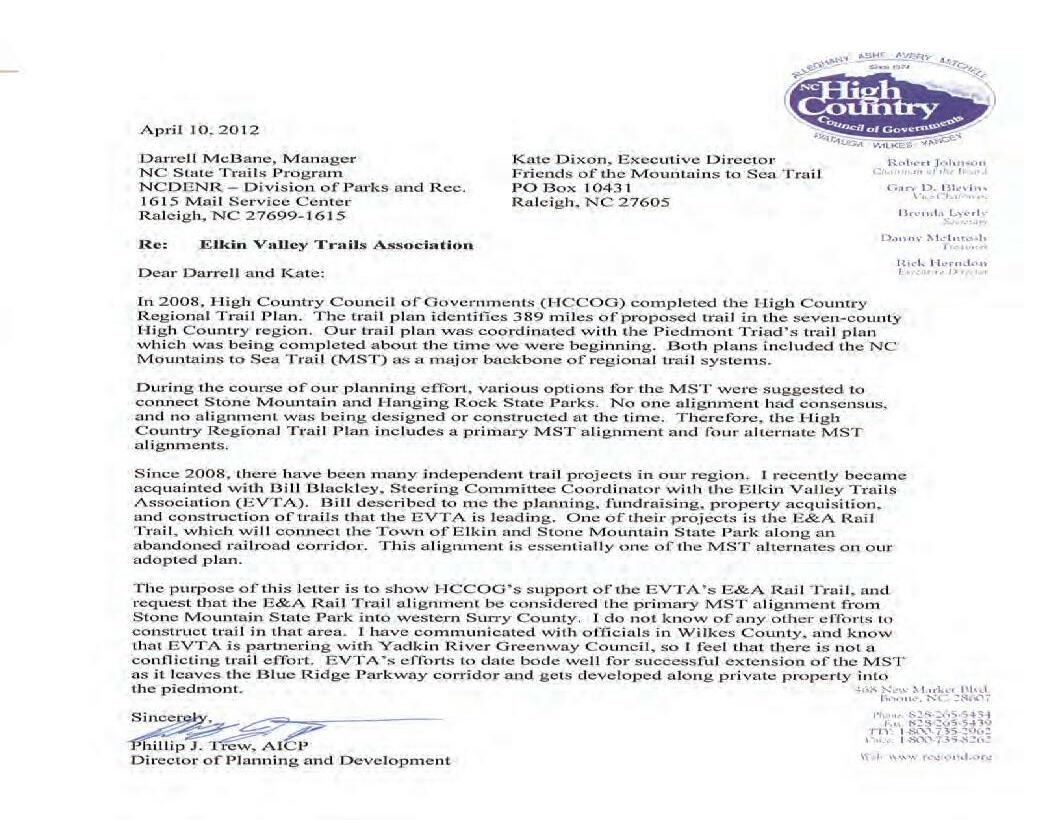
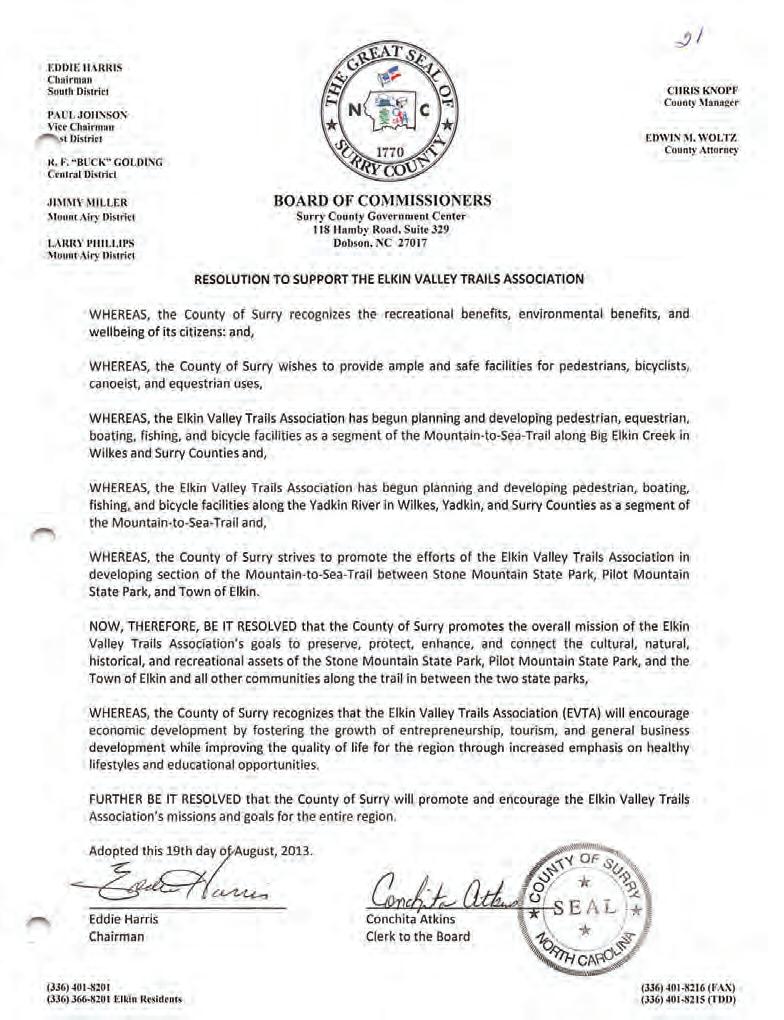
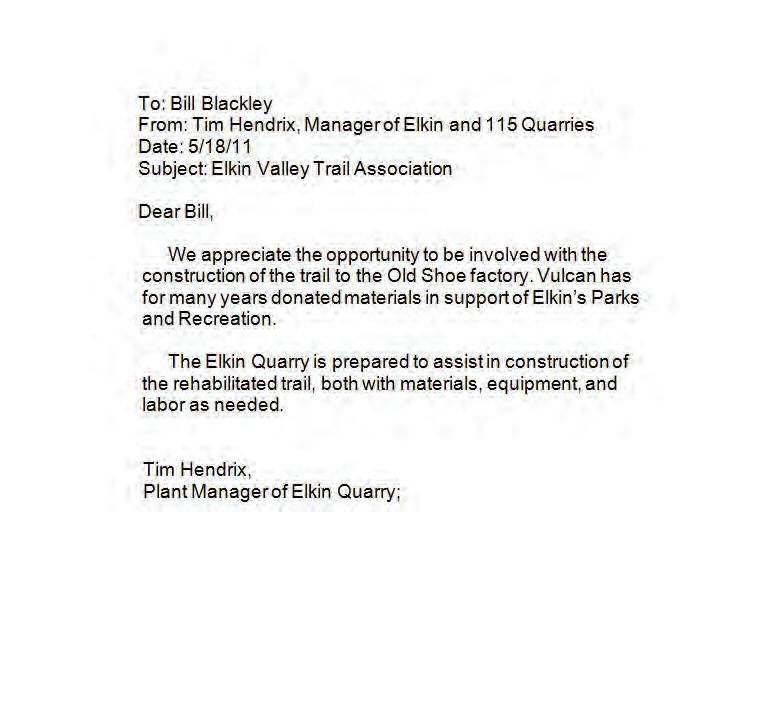
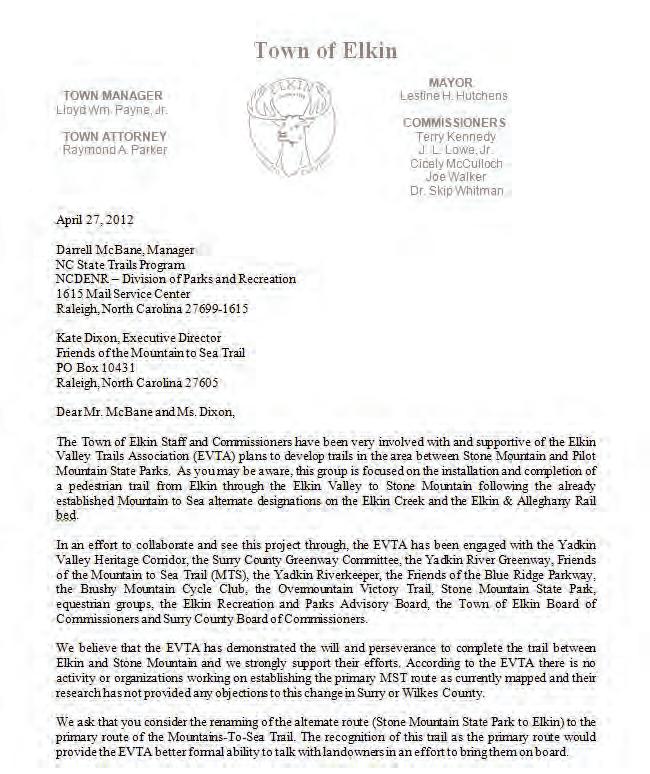
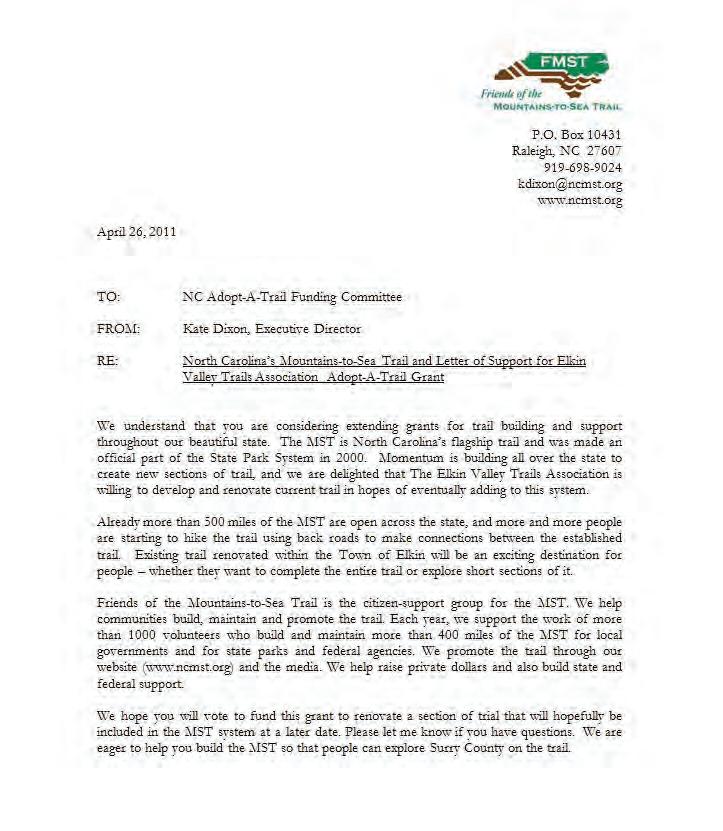
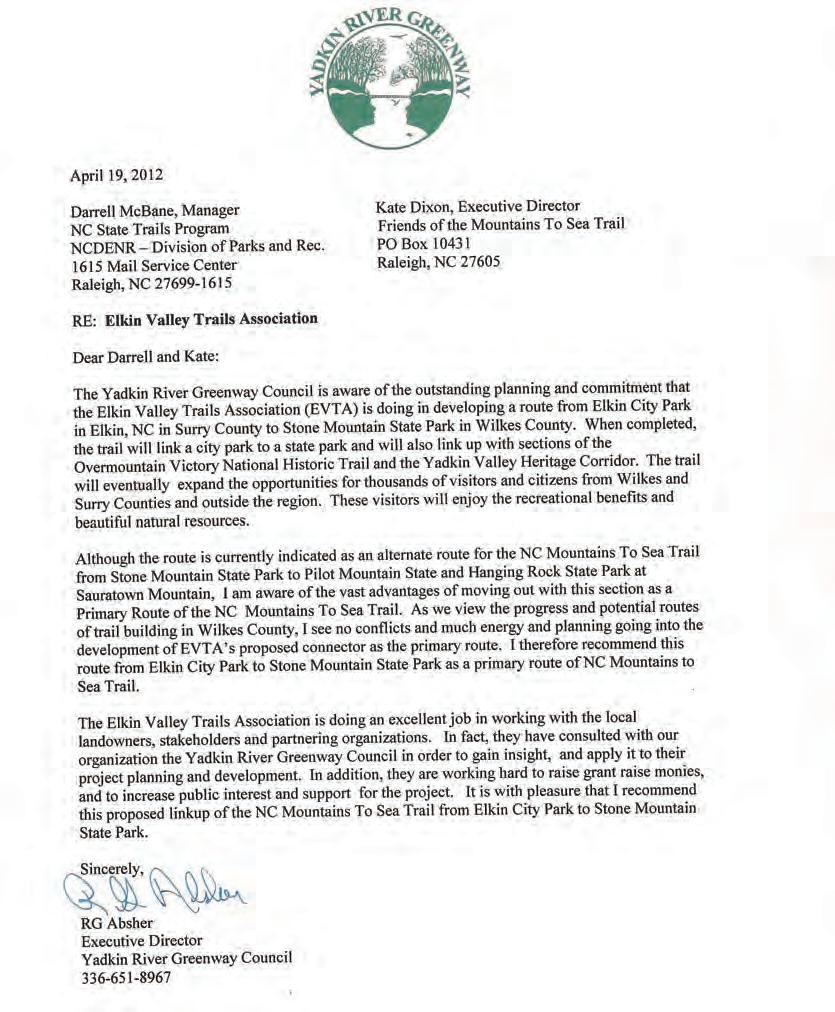
NCDENR – Division of Parks and Rec. 1615 Mail Service Center Raleigh, NC 27699-1615
Re: Elkin Valley Trails Association
Dear Mr. McBane:
I am writing this letter in support of Elkin Valley Trails Associations effort in trail building and easement acquisition along Big Elkin Creek in Wilkes and Surry Counties. As you may know, I serve as chairman for the Yadkin Valley Heritage Corridor. The YVHC is a regional collaboration of local governments, local citizens and state and federal partners whose mission is to create a linear trail system along the Yadkin River and to market the Yadkin Valley Region as a tourist area.
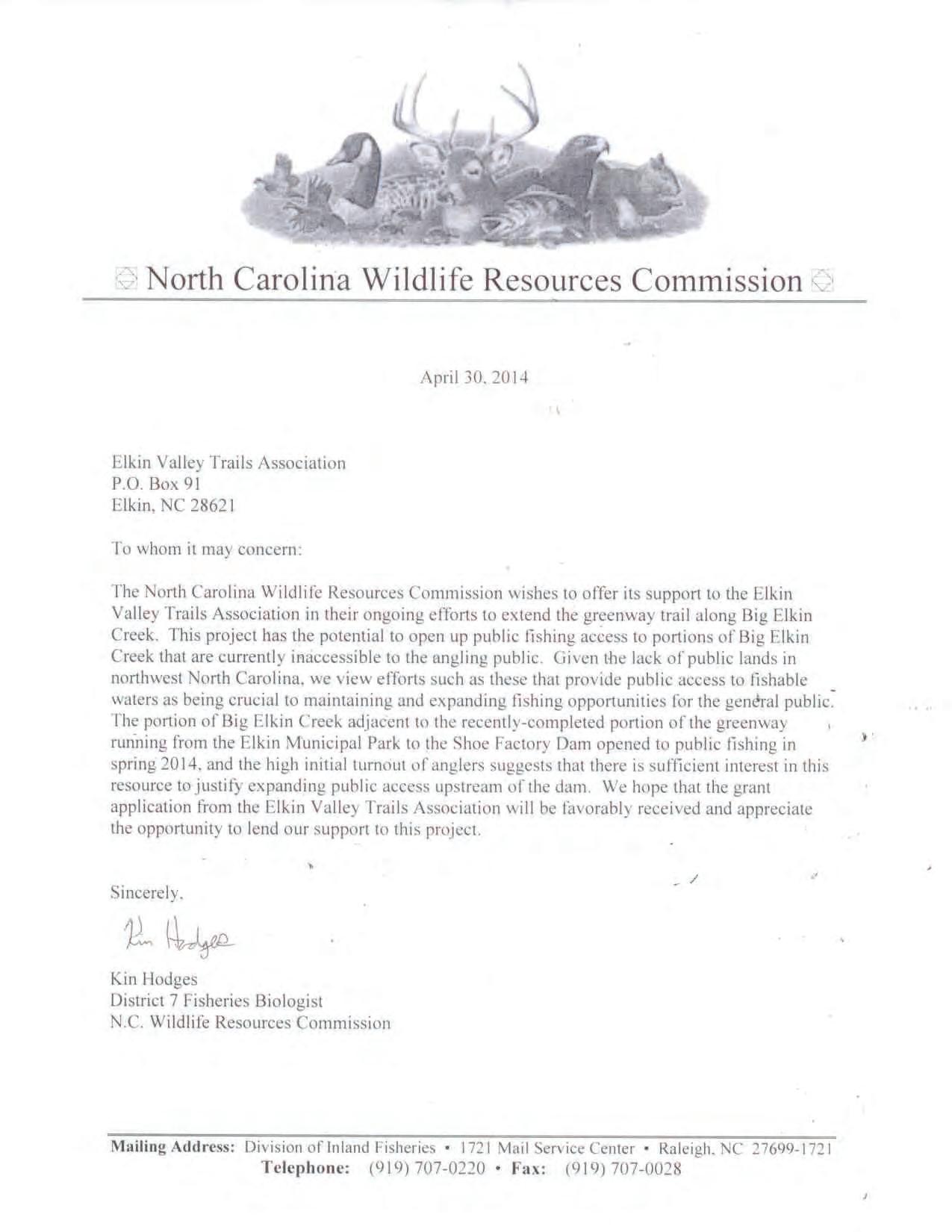
In 2007 we held a series of meetings in conjunction with the State Trails Division. At that time the western representative for State Trails was Dwayne Stutsman. It was our opinion at that time that the primary route for the Mountains to Sea Trail was to follow Roaring River from Stone Mountain State Park to its conßuence with the Yadkin River. The trail would then proceed east along Yadkin Valley Heritage Corridor in eastern Wilkes County and the Overmountain National Historic Victory Trail for several miles.
This alignment was simply chosen due to the Roaring River’s connection with Stone Mountain and the Yadkin River. However, recent efforts by the Elkin Valley Trails Association has demonstrated signiÞcant momentum in trail building and easement acquisition along Big Elkin Creek and an abandoned rail road bed of the former Elkin and Allegany railroad. No trail building or easement acquisition has occurred along the Roaring River route. Therefore, it is now our desire to endorse the section of trail from Stone Mountain to the conßuence of Big Elkin Creek and the Yadkin River as the primary route for the Mountains to Sea Trail, where it will connect to the Yadkin Valley Heritage Corridor and eastern terminus of the Overmountain Victory Trail.
Respectfully, Edward G. Barnes, Chairman
project. At this time, Chairman Elmore read the Resolution to Support the Elkin Valley Trains Association into the record.
Commissioner Eddie Settle made a motion to approve the Resolution in Support the Elkin Valley Trails Association as presented. The motion was seconded by Commissioner David Gambill and unanimously approved.
WHEREAS, the County of Wilkes recognizes the recreational benefits, environmental benefits, and well being of its citizens; and
WHEREAS, the County of Wilkes wishes to provide ample and safe facilities for pedestrians, bicyclists and equestrian uses; and
WHEREAS, the Elkin Valley Trails Association has begun planning and developing pedestrian, equestrian and bicycle facilities in along Big Elkin Creek in Wilkes and Surry Counties; and
WHEREAS, the County of Wilkes strived to promote the efforts of the Elkin Valley Trails Association in developing a trail between Elkin and Stone Mountain State Park,
NOW, THEREFORE, BE IT RESOLVED that the County of Wilkes promotes the overall mission of the Elkin Valley Trails Association goals to preserve, protect, enhance and connect the cultural, natural, historical and recreational assets of the Stone Mountain State Park and the Town of Elkin via a trail along Big Elkin Creek and adjacent areas,
WHEREAS, the County of Wilkes recognized that the Elkin Valley Trails Association (EVTA) will encourage economic development by fostering the growth of entrepreneurship, tourism and general business development while improving the quality of life for the region through increased emphasis on healthy lifestyles and educational opportunities.
FURTHER BE IT RESOLVED that the County of Wilkes will promote and encourage the Elkin Valley Trails Association missions and goals for the entire program.
Adopted this the 18th day of June, 2013.
Keith Elmore, Chairman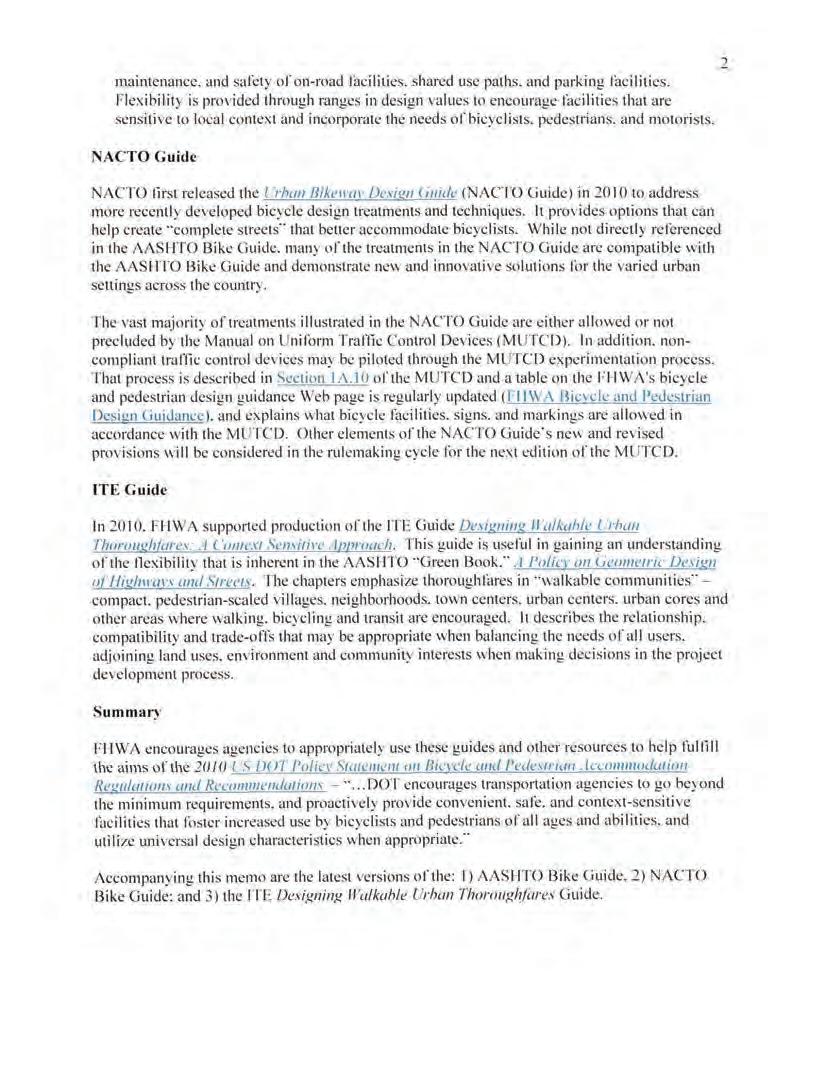
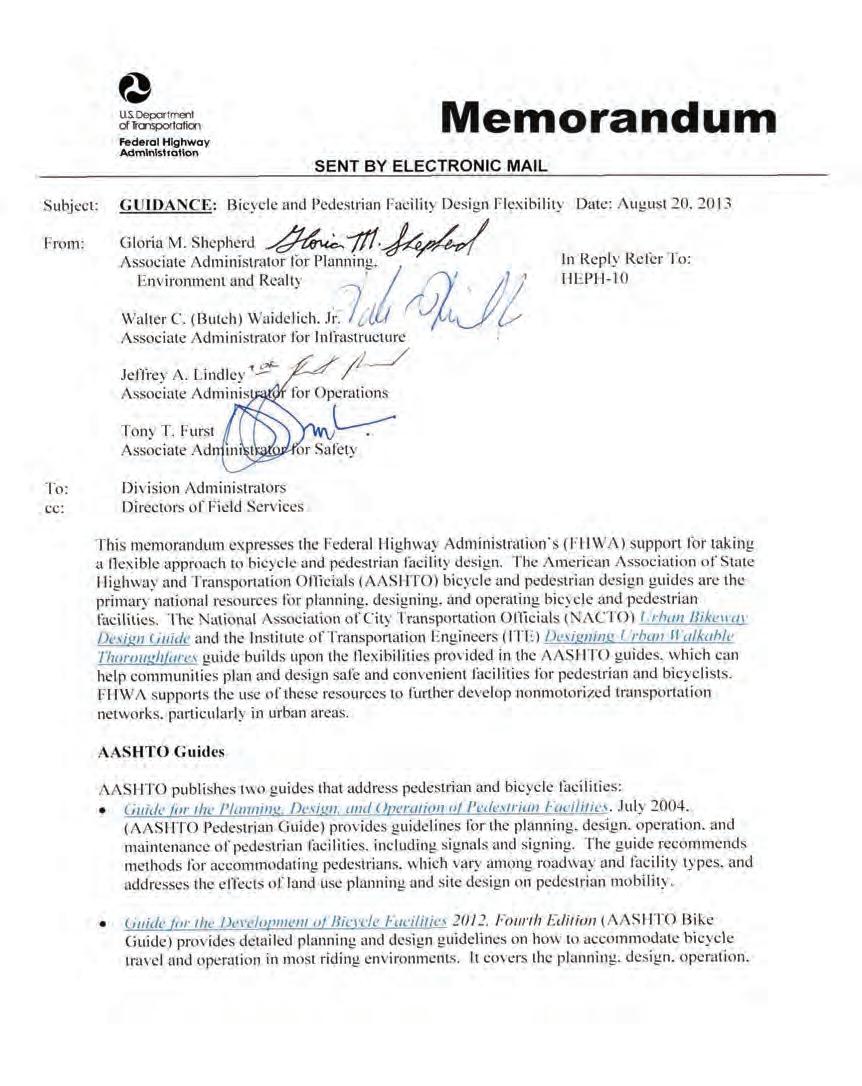
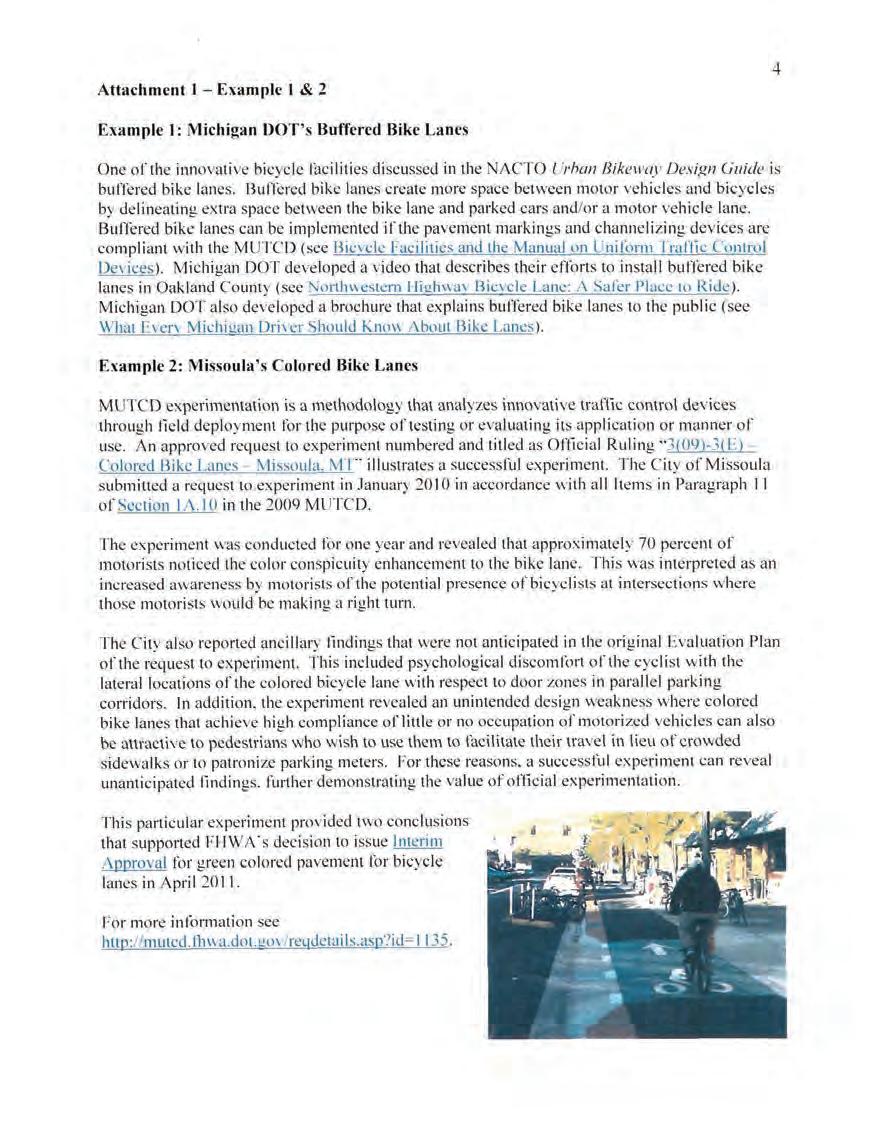


Source: MOU Between Town of Yorktown and New York-New Jersey Trail Conference
Between Town of ___________(Town) AND ___________(Delegated Community Group, or DCG)
The __________ (Town) is a town in __________ County, North Carolina. Notifications of problems are made to the Parks and Recreation Department.
The __________ (DCG) is a not-for-profit membership association engaged in the protection, management, and maintenance of publicly accessible and authorized trails in the Mountains-to-Sea State Trail - Sub Section - Stone Mountain to Pilot Mountain State Park Master Plan study area.
Section 1 - purpose
1.1 This Memorandum of Understanding (MOU) is to plan, develop, maintain, and protect trails within the lands owned by the Town of __________ (Town) and managed by their Parks and Recreation Department with assistance from volunteers organized by the __________ (DCG).
1.2 This MOU applies to the trail system encompassing town owned lands surrounding the Mountains-to-Sea State Trail - Sub Section - Stone Mountain to Pilot Mountain State Park Master Plan study area. It may be amended in writing to include additional trails in parks owned by the Town and any parkland acquired by the Town after the date of this MOU.
2.1 Since its founding in 1920, __________ (DCG) volunteers have built and currently maintain over 1,700 miles of publicly accessible and authorized trails in the North Carolina area. Upon request, the __________ (DCG) will provide a list of trails they maintain.
2.2 The __________ (DCG) has adopted a Trail Management Guide and a Trail Maintenance Manual, which contains its policies, practices, and procedures for building and maintaining hiking trails. The Trail Conference has provided a copy of these documents to the Parks and Recreation Department.
2.3 The __________ (DCG) recruits, trains, and deploys volunteers to plan, build, and maintain hiking trails. In addition to basic training in trail maintenance, safety, use of hand tools, and reporting procedures, the __________ (DCG) offers advanced training in trail design and construction, chainsaw safety and use, mapping, environmental monitoring, and trail leadership.
2.4 __________ (DCG) volunteers provide the tools they need for routine trail maintenance. Trail maintainers do not use power tools, such as chainsaws or drills. However, certain __________ (DCG) volunteers, who are trained in the safe use of chainsaws and other power tools, may use them when they are required and approved by the __________ (DCG).
2.5 In accordance with the Trail Management Guide and unless otherwise specified by the Town, __________ (DCG) maintainers, supervisors, and chairs will handle trail relocations and improvements with or without prior approval of the Town depending on the magnitude and urgency of the relocation or improvement. Regardless of the need for prior consultation, all trail relocations and improvements are included in
semiannual reports.
2.6 While equestrians and motorized (non-official) vehicles are prohibited on all the trails that are covered by this MOU, mountain bikes are permitted on the Yorktown Trailway as well as in the Woodlands property with the exception of trails specifically marked for the exclusion of mountain bikes.
The __________ (DCG) shall:
3.1a. supply trained maintainers who provide their own tools, work independently, and schedule their work trips at their own convenience. They report to a supervisor who in turn regularly communicates with the regional trail committee chair. Either the supervisor or committee chair shall advise the Parks and Recreation Department on conditions and problems that have been so noted.
b. assign maintainers who are members of the __________ (DCG), as per __________ (DCG) practices. The maintainers visit and report on their assigned trail segment at least twice a year (spring and fall) and more frequently when conditions require. At these times the maintainers:
Blaze the trails and rebuild cairns; Clip and trim brush to keep the trail open and passable; Clean water bars and their outflow channels to control erosion; Remove fallen trees and limbs, except when too large to handle with hand tools; Remove litter and graffiti (if possible); and Report trail conditions and problems to their volunteer supervisor.
c. provide the Town with a site specific trail plan for all new trails. These plans will be written by one of the __________ (DCG)’s experienced trail designers and are to be approved by the Town’s Parks and Recreation Department.
d. schedule major projects to restore or relocate trails with conditions which are due to but not limited to poor design, environmental impacts, severe weather, overuse, motorized vehicles, and other factors. Such major projects require the advance approval of the Town’s Parks and Recreation Department and are performed and scheduled by the __________ (DCG) subject to availability of materials and labor.
e. have general liability insurance coverage for volunteers who may be sued in the course of performing their assigned tasks on behalf of the Town and can procure supplemental accident coverage for volunteers who are not otherwise covered for injuries.
The Town shall:
4.1. Obtain, as needed and at its discretion, any licenses, permits, and approvals for the construction of any improvements to the land, such as trails, bridges, lean-tos, privies, retaining walls, or buildings of any kind. Where engineering plans, designs, or surveys are required, the Town shall obtain the required plans and permits.
4.2. Supply tag blazes, kiosks or signs.
4.3. Conduct environmental impact surveys and the filings of any applications, forms, or reports that may be required by any level of government or by a granting or regulatory agency.
4.4. Arrange for the transportation of materials for construction of bridges, boardwalks, etc to the nearest location to the work site that a vehicle may approach such as a parking area or trailhead.
4.5. Be responsible for the stewardship of the land and its trails including the enforcement of rules that govern the use of the trails by the public
5.1 apply for grants to provide materials for the construction of bridges or other structures along the trails
5.2 provide the verbiage for signs which, if used at trailhead are to include that the Trail Conference maintains the trails.
5.3 seek out and find suitable projects for youth, school, civic, and corporate groups wishing to assist with trail projects
Upon completion of the draft plan, the consultant team commenced a 45-day public comment period. A printed draft plan, along with a cover letter (see page right), was formally mailed to all major stakeholders and local governments within the study area (see table below). Also, an electronic copy of the draft plan was sent to three major email lists, including those belonging to Elkin Valley Trails Association, Yadkin Valley Heritage Corridor Partnership and Friends of the Mountains-to-Sea Trail.
1. County Town name position
Surry Elkin Lloyd Payne Town Manager
Surry Chris Knopf County Manager
Surry Elkin Dr. Bill Blackley Coordinator - Elkin Valley
Trails Association
Surry Elkin Leslie Schlender Economic Development Director
Wake Raleigh Kate Dixon Executive Director - FMST
Wake Raleigh Darrell Mcbane Trails Program Manager - NC
Division of Parks and Rec
Wilkes John Yates County Manager
Wilkes Ronda Lahoma O'Lague Town Administrator
The parties may modify this MOU in a writing signed by both parties.
party may withdraw from the relationship described above
the other party.
days written notice
Wilkes Eddie Barnes Planning Director
Yadkin Jonesville Scott Buffkin Town Manager
Yadkin Aaron Church County Manager
Yadkin Boonville Rusty Hunter IV Mayor
At the completion of the 45 day comment period, only brief and informal comments had been received via phone and email from only few stakeholders.
To: Regional Trail Stakeholders

From: Eric Woolridge, AICP
Principal, Destination by Design
Date: September 15, 2014
Re: Mountains
Destination by Design (DbD) is pleased to provide your office with a draft of the Mountains-to-SeaStateTrailSub SectionPlan:StoneMountaintoPilotMountainStateParkMasterPlan . This study was commissioned by the North Carolina Division of Parks and Recreation and the Northwest Partnership for Public Health. We welcome your comments concerning this draft plan, which will remain open for public comment until October 1, 2014.
Noted below are some major facts and objectives found within the plan:
1. This plan changes the previously planned Mountains-to-Sea (MST) route from the Roaring River corridor to the Wells Knob/ Elkin Creek corridor.
2. Upon completion, this study area would provide for approximately 70 miles of designated Mountains-to-Sea Trail.
3. This plan calls for 17 new miles of equestrian trail (Stone Mountain State Park to Carter Falls).
4. East of Elkin/Jonesville, equestrian use is not recommended because of railroad right of way crossings.
5. 33 miles (38%) of the proposed trail will serve as multi use cycling and hiking designated MST. This will begin just north of Elkin and then traverse through Elkin and Jonesville and along the Yadkin River to Pilot Mountain State Park. A multi use trail design will provide the greatest economic impact to the region.
6. This plan proposes a loop trail around the Yadkin River that links both Elkin and Jonesville.
7. East of Elkin and Jonesville, the trail is recommended on the Surry County side until it approaches Wayne Farms; at this point, the trail will need to cross the Yadkin River south to Yadkin County if the trail is to remain multi use. The plan notes other areas where potential bridge crossings will need to be developed further linking Surry and Yadkin Counties.
8. The plan identifies priority implementation areas for governing bodies and non profit organizations as they focus their efforts on trail implementation (Chapter 6).
DbD and the North Carolina Division of Parks and Recreation welcome all public comments regarding this plan. It is our hope that your governing body or organization will adopt this plan or provide recommend changes that would make that possible.
For more information, contact:
Eric Woolridge, AICP
Principal, Destination by Design
Phone: 828.386.1866
Email: eric@DbDplanning.com
Destination by Design
The Sauratown Trails Association (STA) requested that equestrian use be called for along portions of the Yadkin River where the railroad does not exist. Also, Friends of Mountains to Sea Trail reminded the consultant team that Friends of Sauratown Trails is the DCG within Pilot Mountain State Park while STA assists with MST efforts outside of the parks. Officials from Elkin Valley Trails Association wanted to note that the planned trail route will continue to alter significantly as they continue to secure landowner agreements. The National Park Service (NPS) noted that all plans and discussion concerning the Blue Ridge Parkway would ultimately need to be officially endorsed by NPS (see A-15 for full NPS email).
The consultant team, upon request from NCDPR and subsequent to the 45 day comment period, placed a phone call to Ronda officials to confirm whether the town had any response or comments, either positive or negative, about changing the route. As of the printing of the final plan, the consultant team was unable to reach Ronda officials. The consultant team also reached out to Wilkes County officials via email; Eddie Barnes, Wilkes County Planning Director, expressed that their office had no comments concerning the draft plan.

